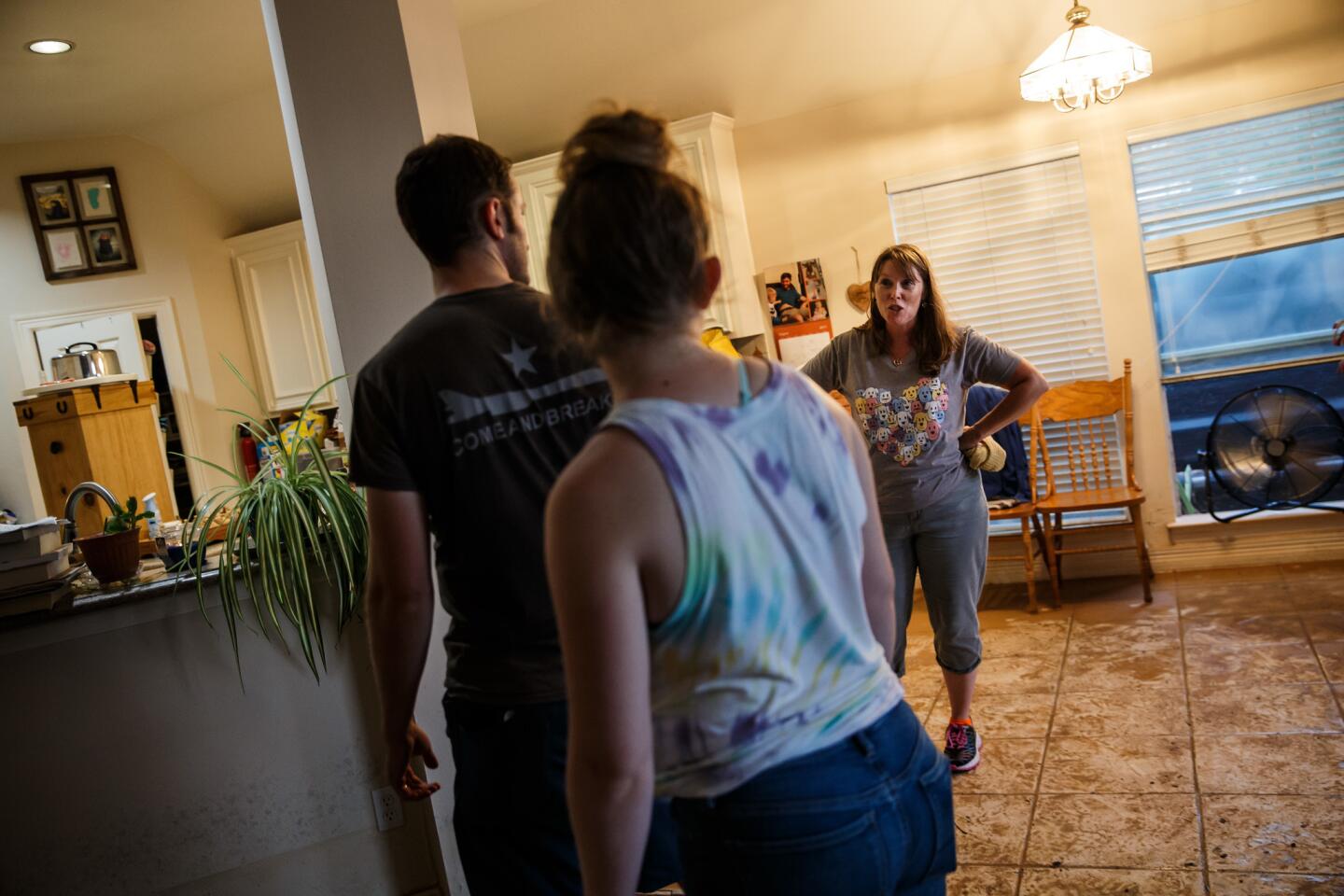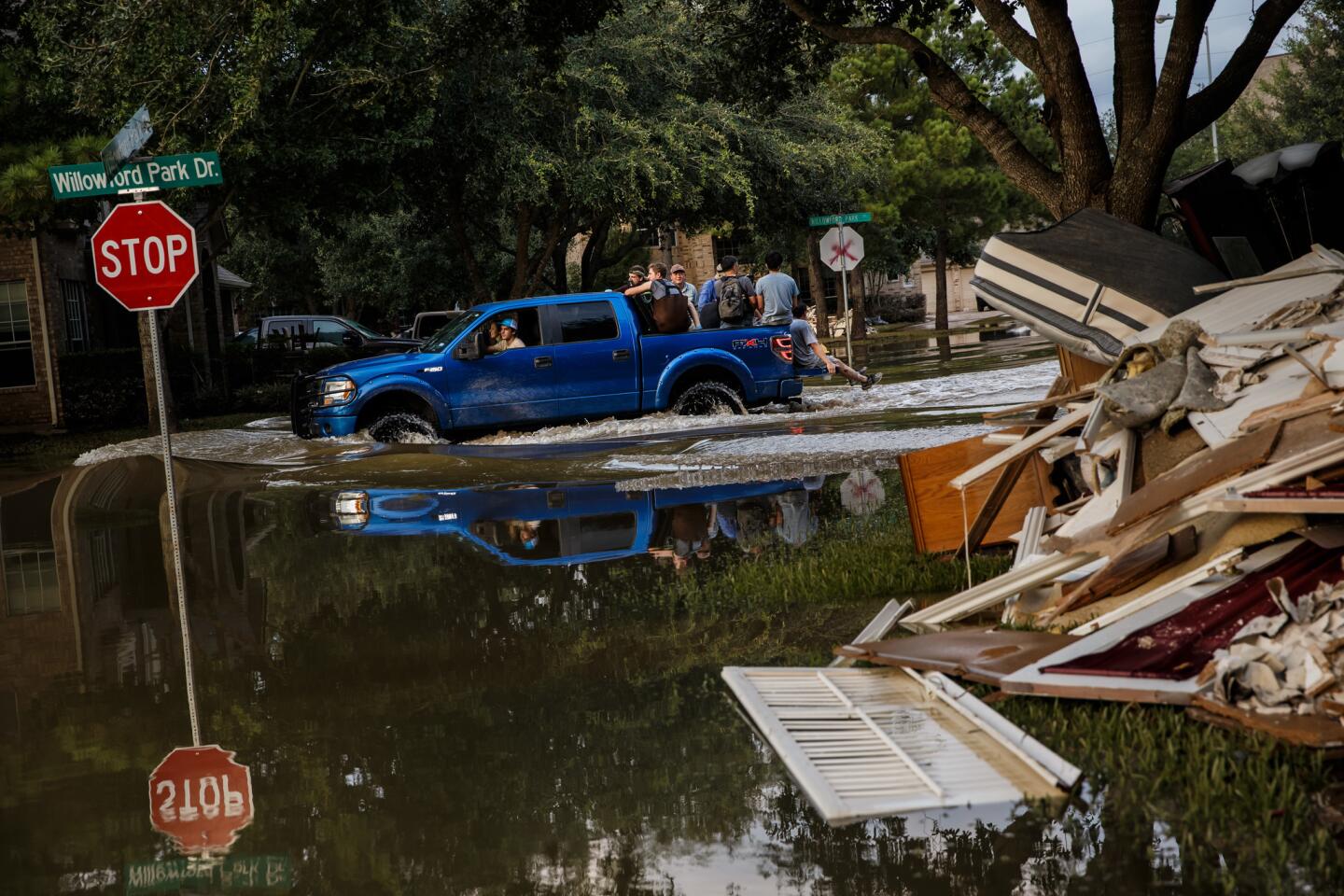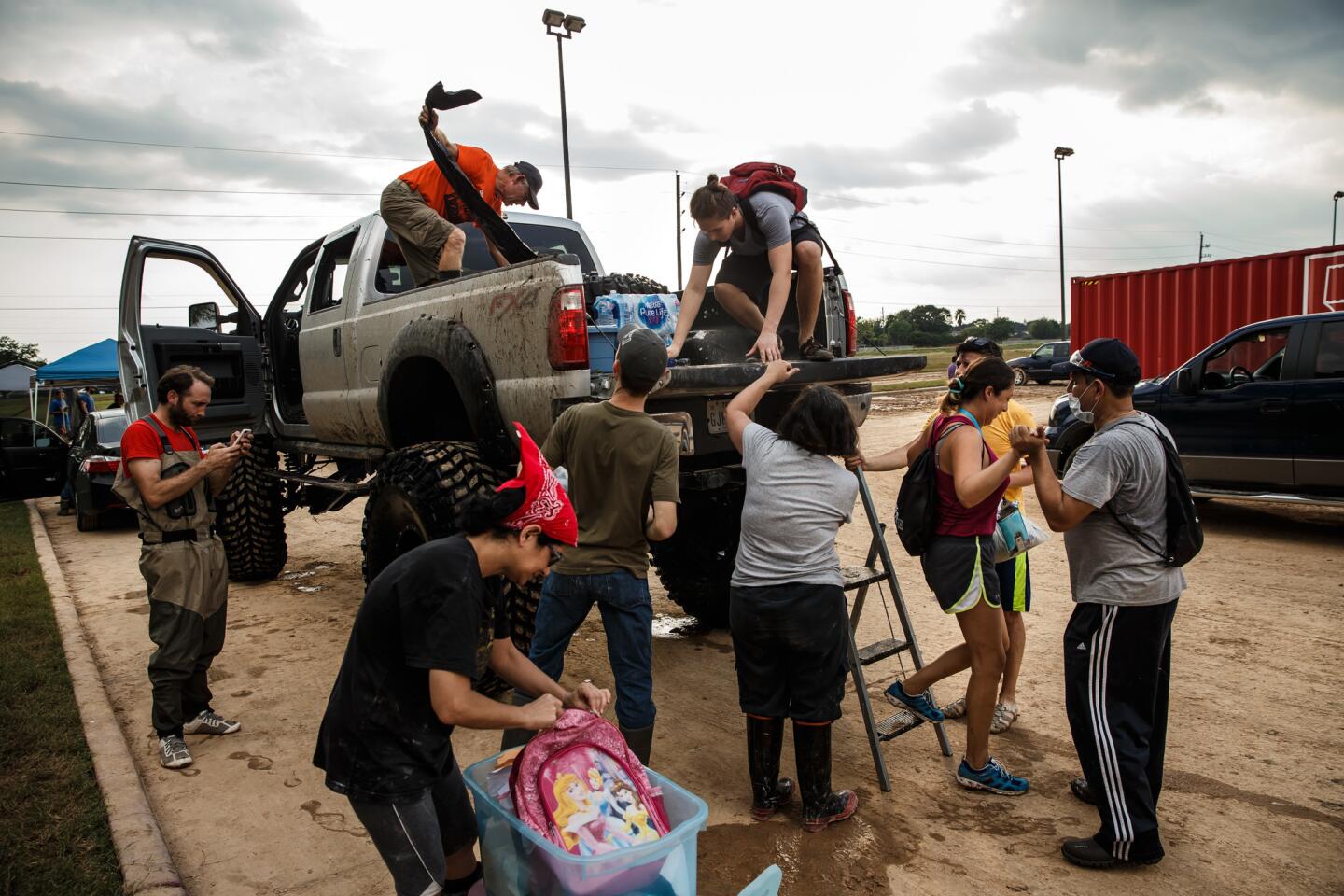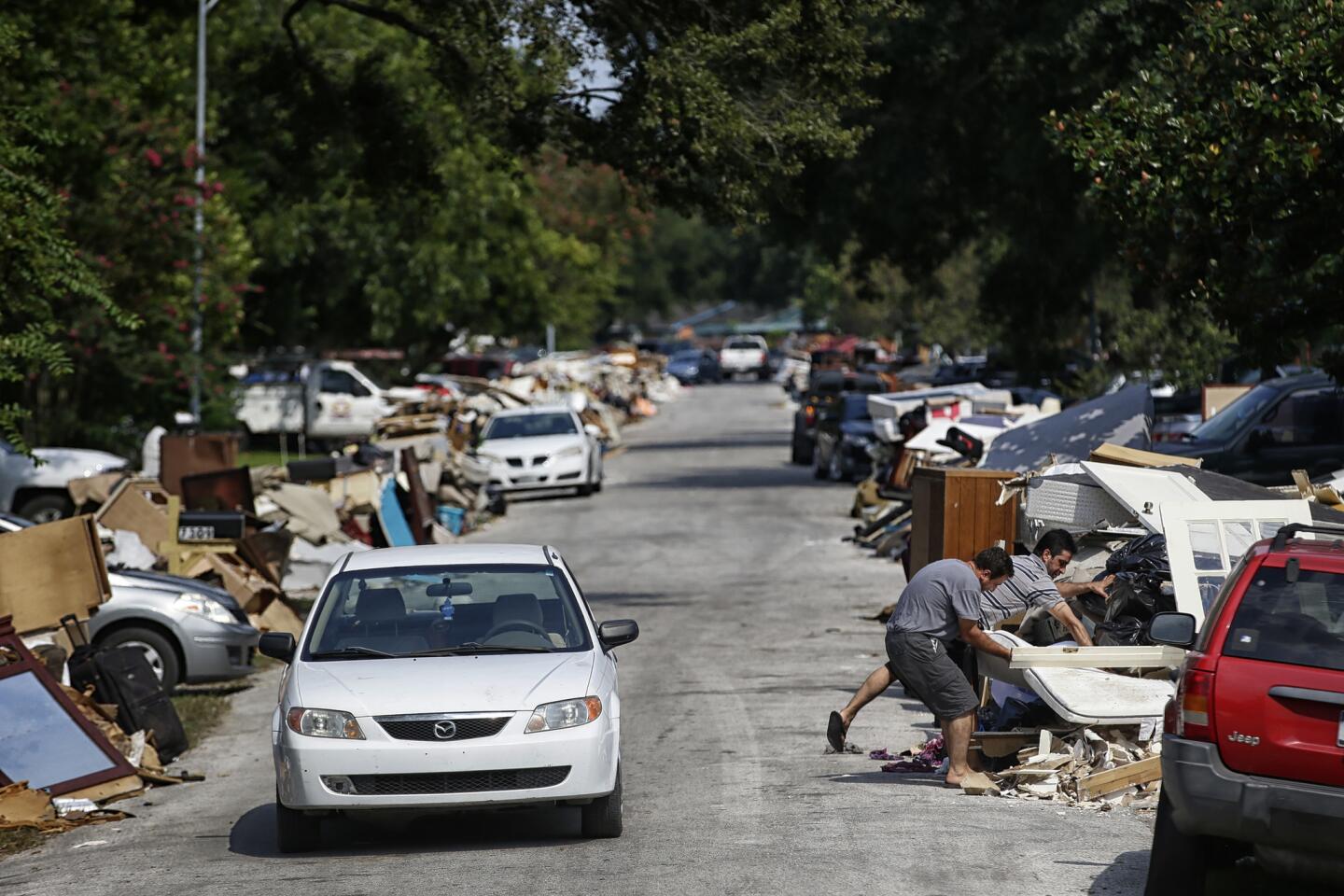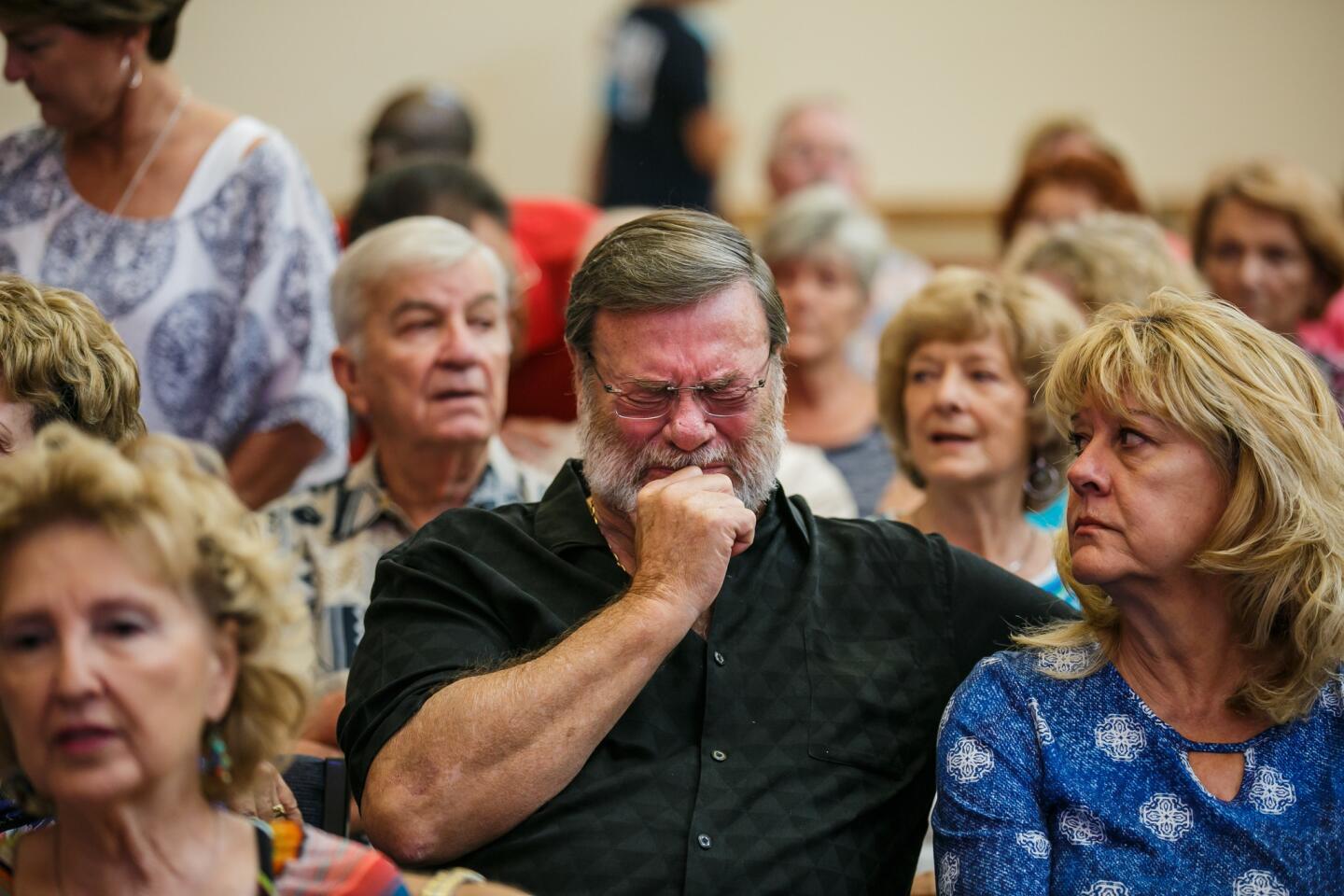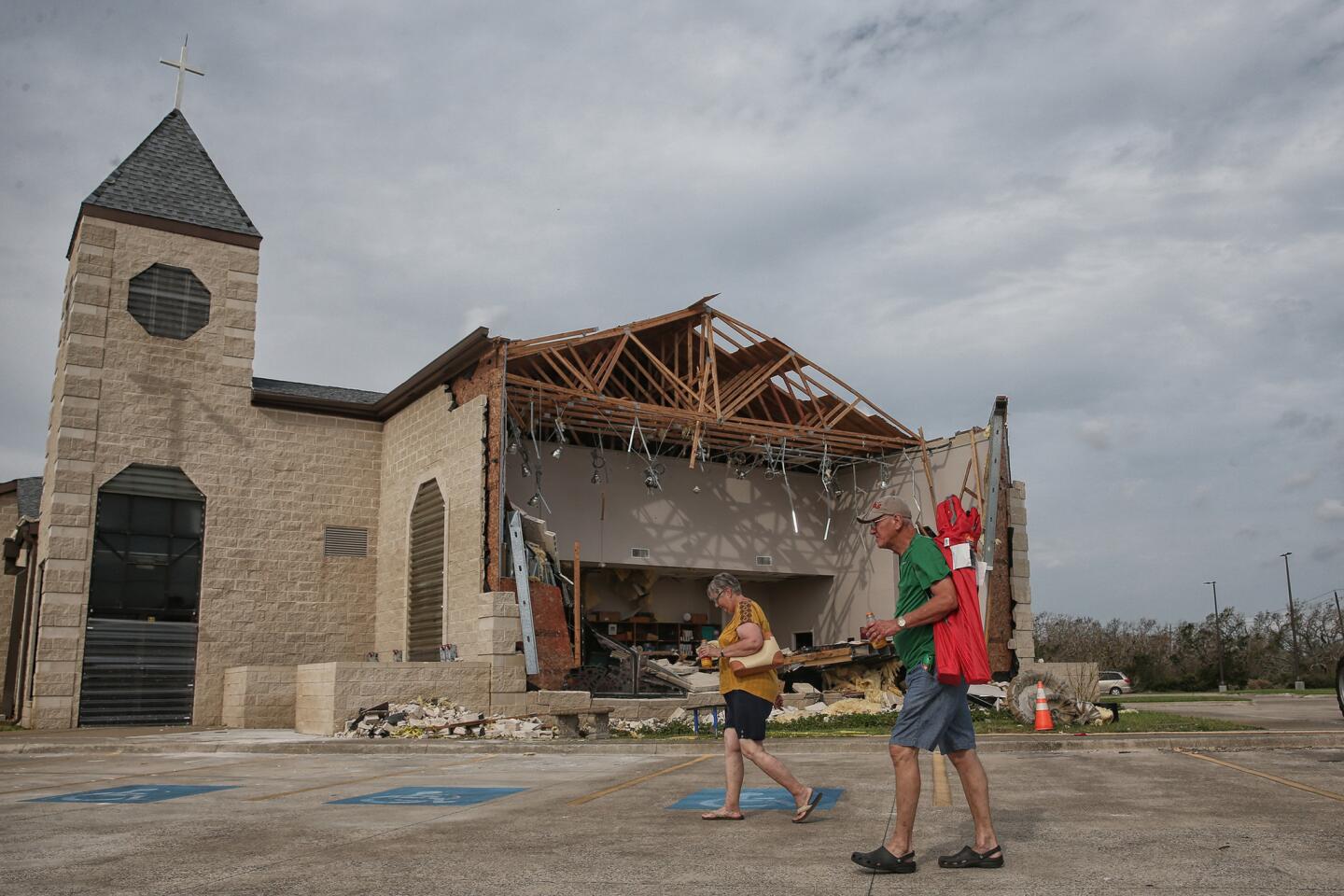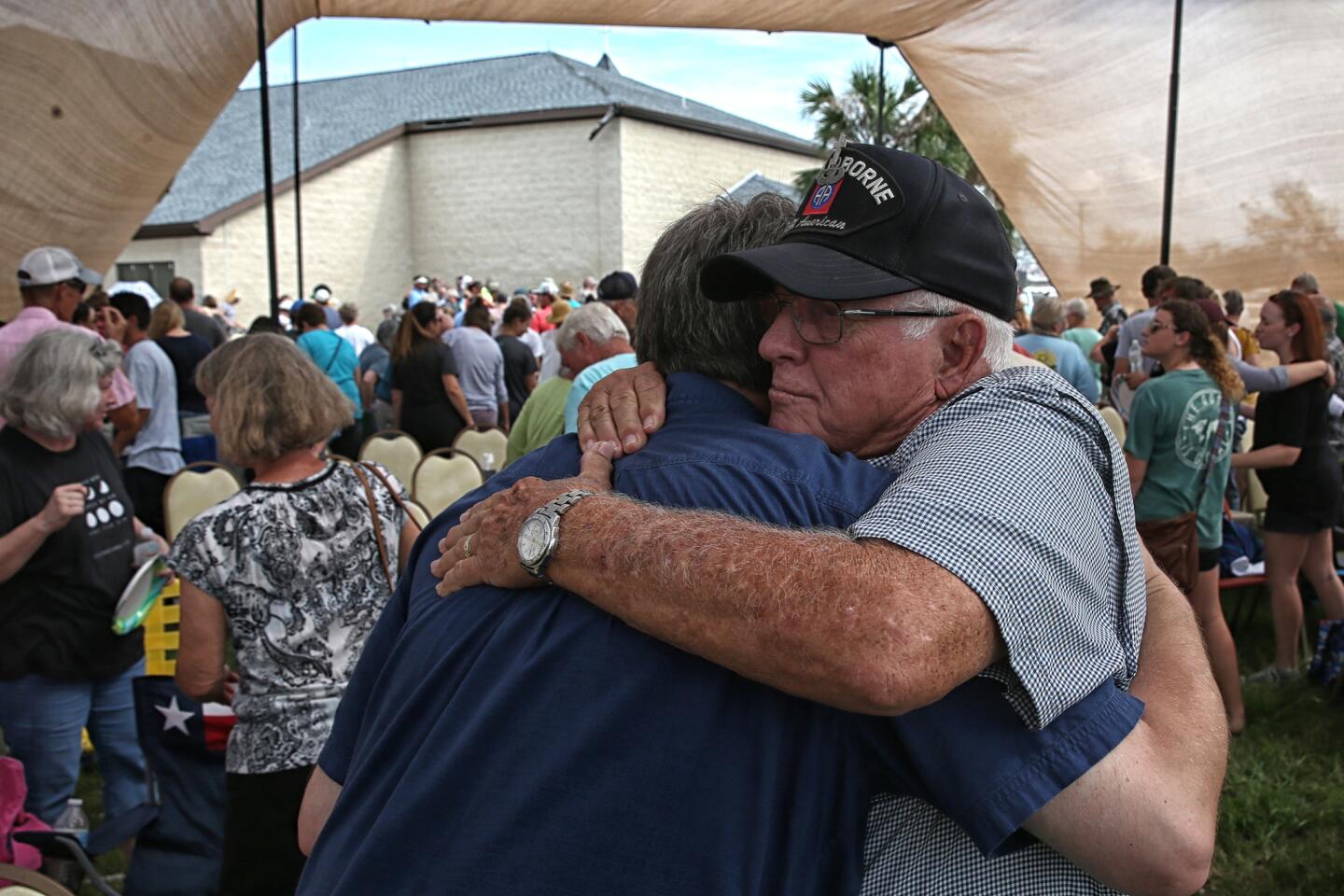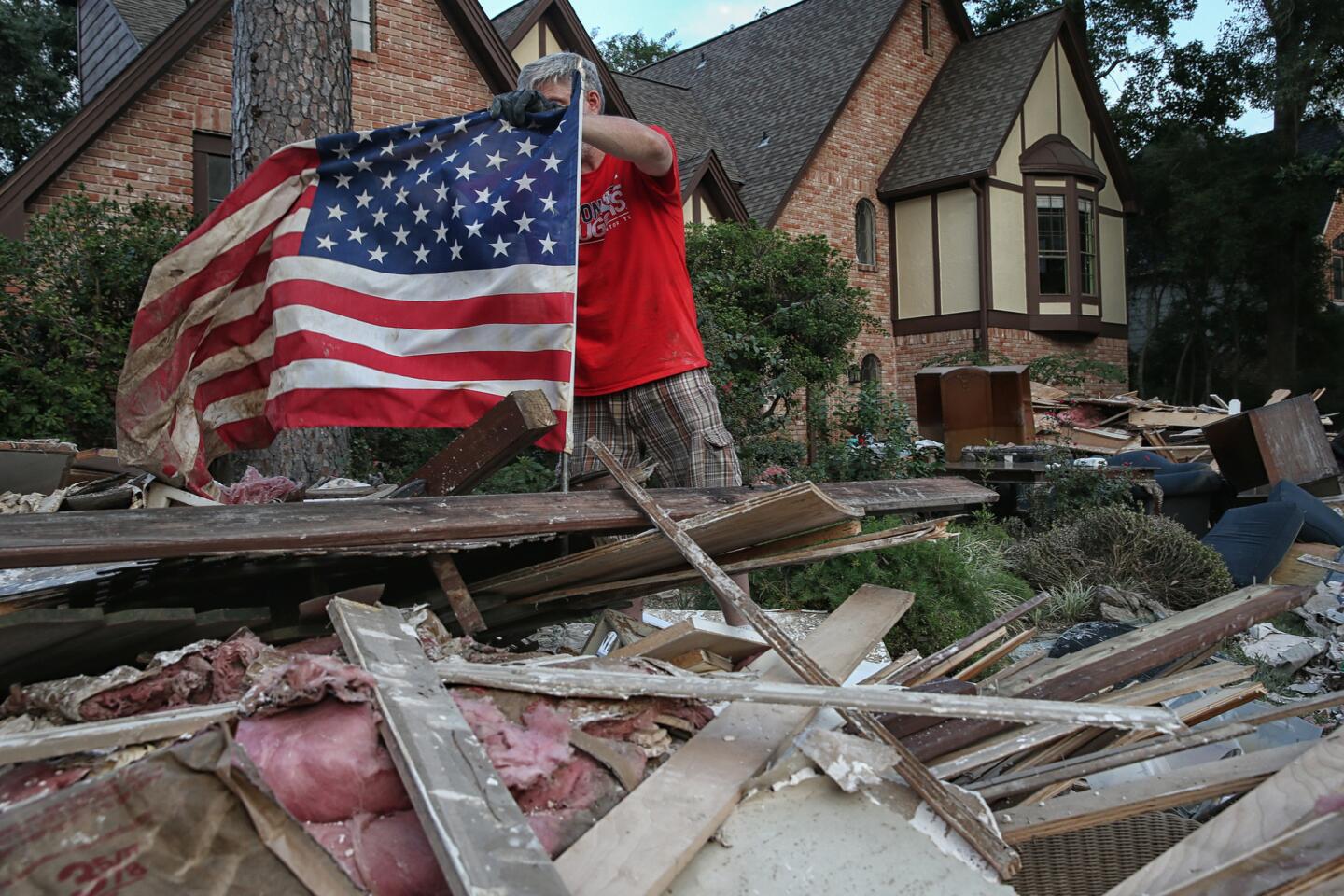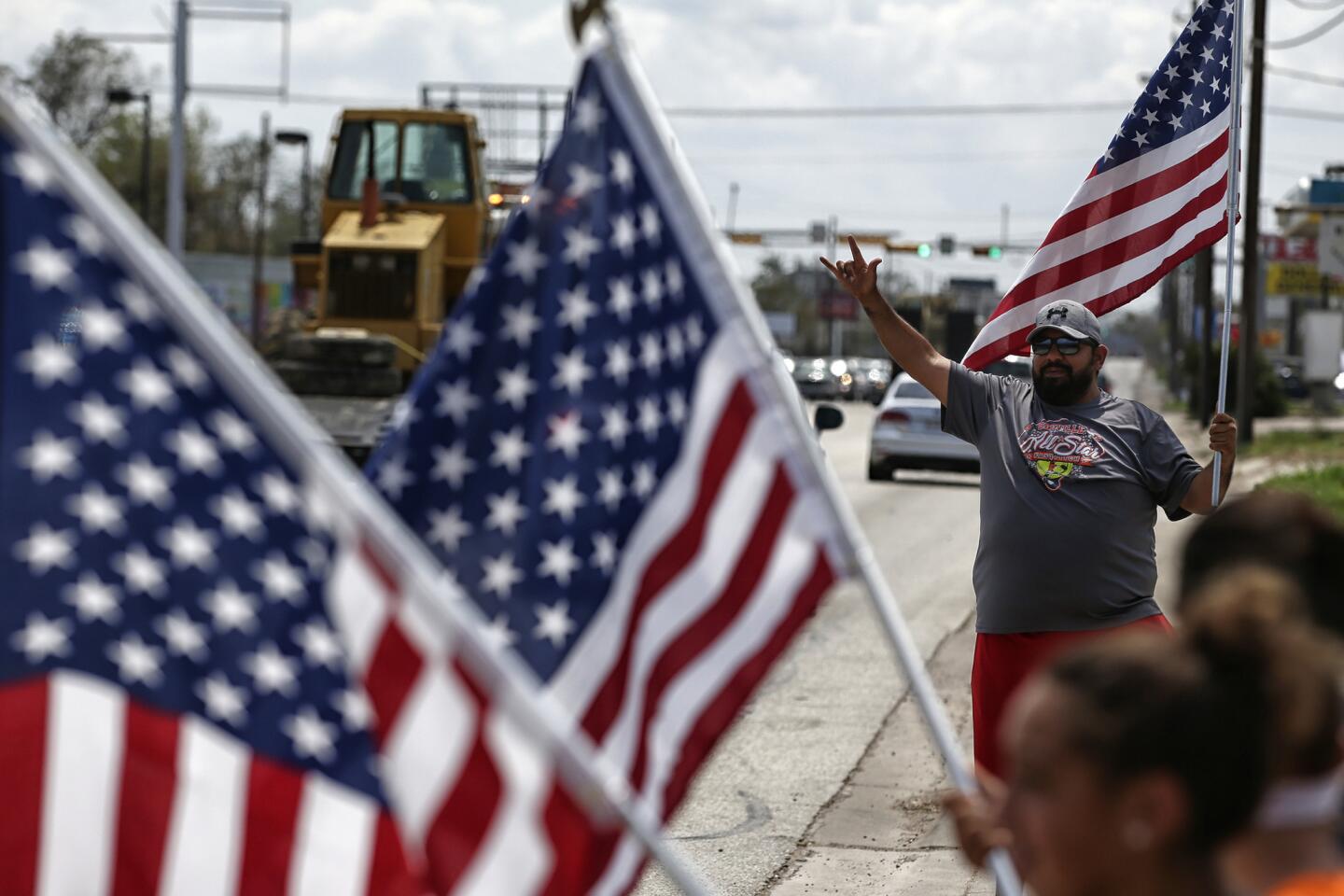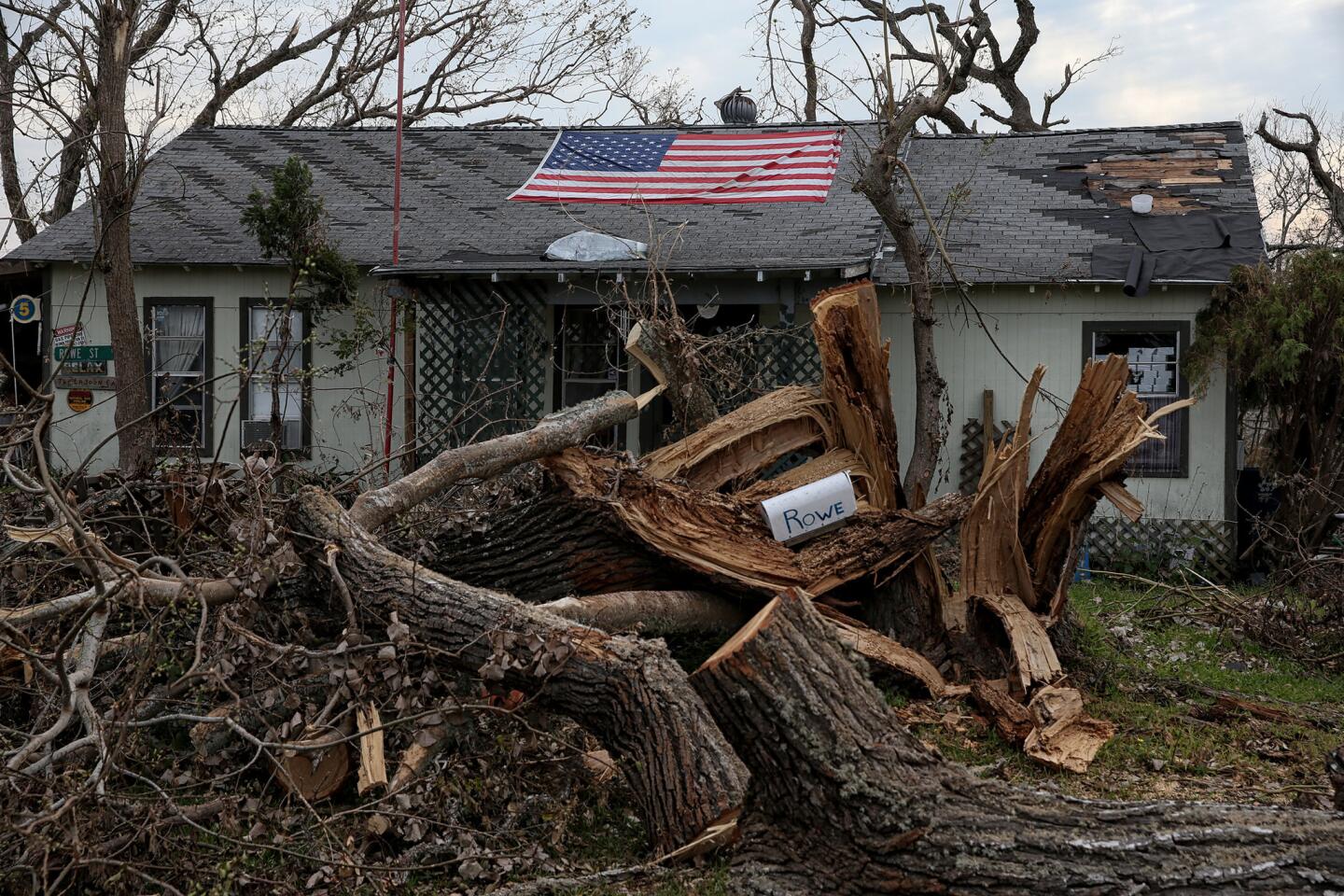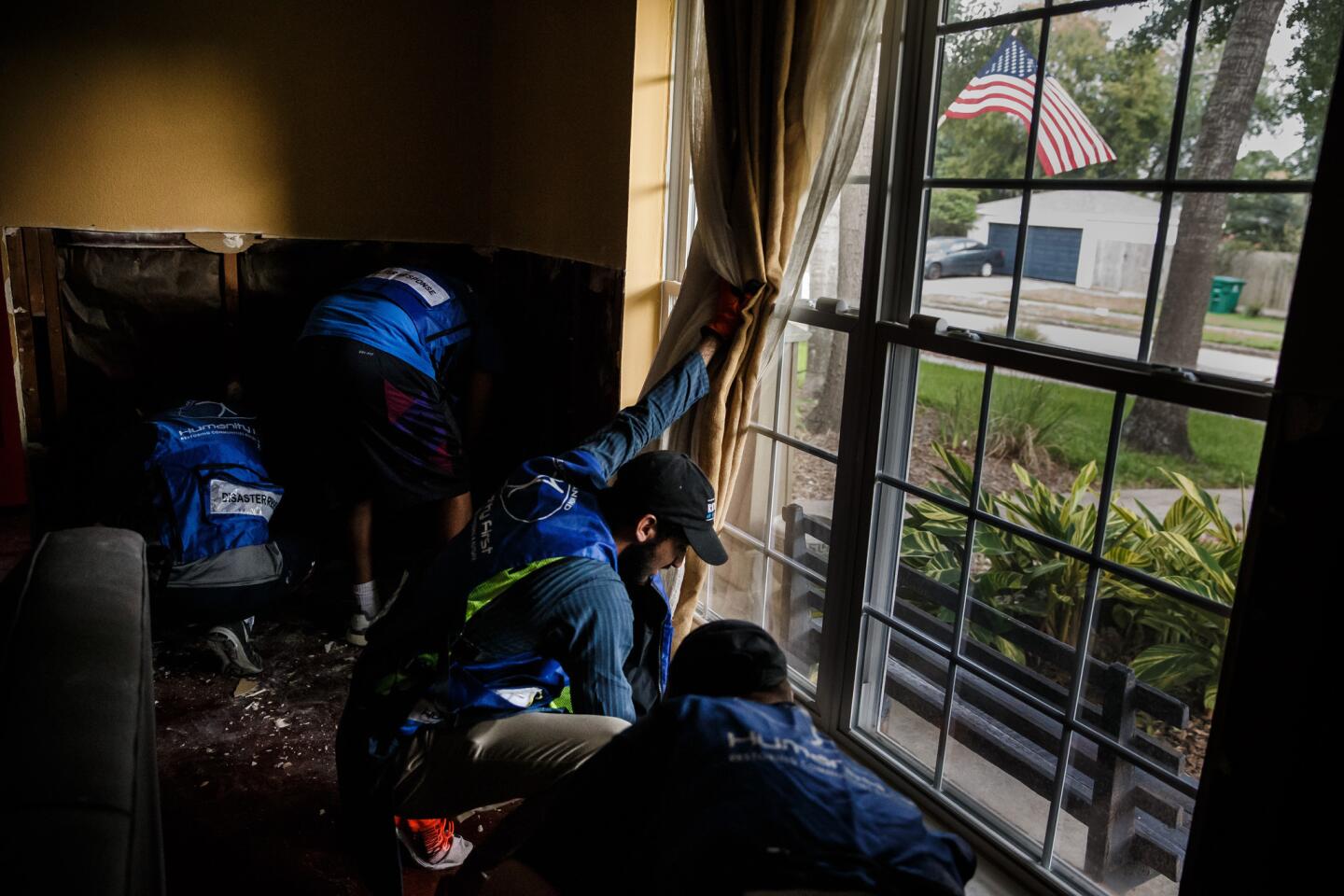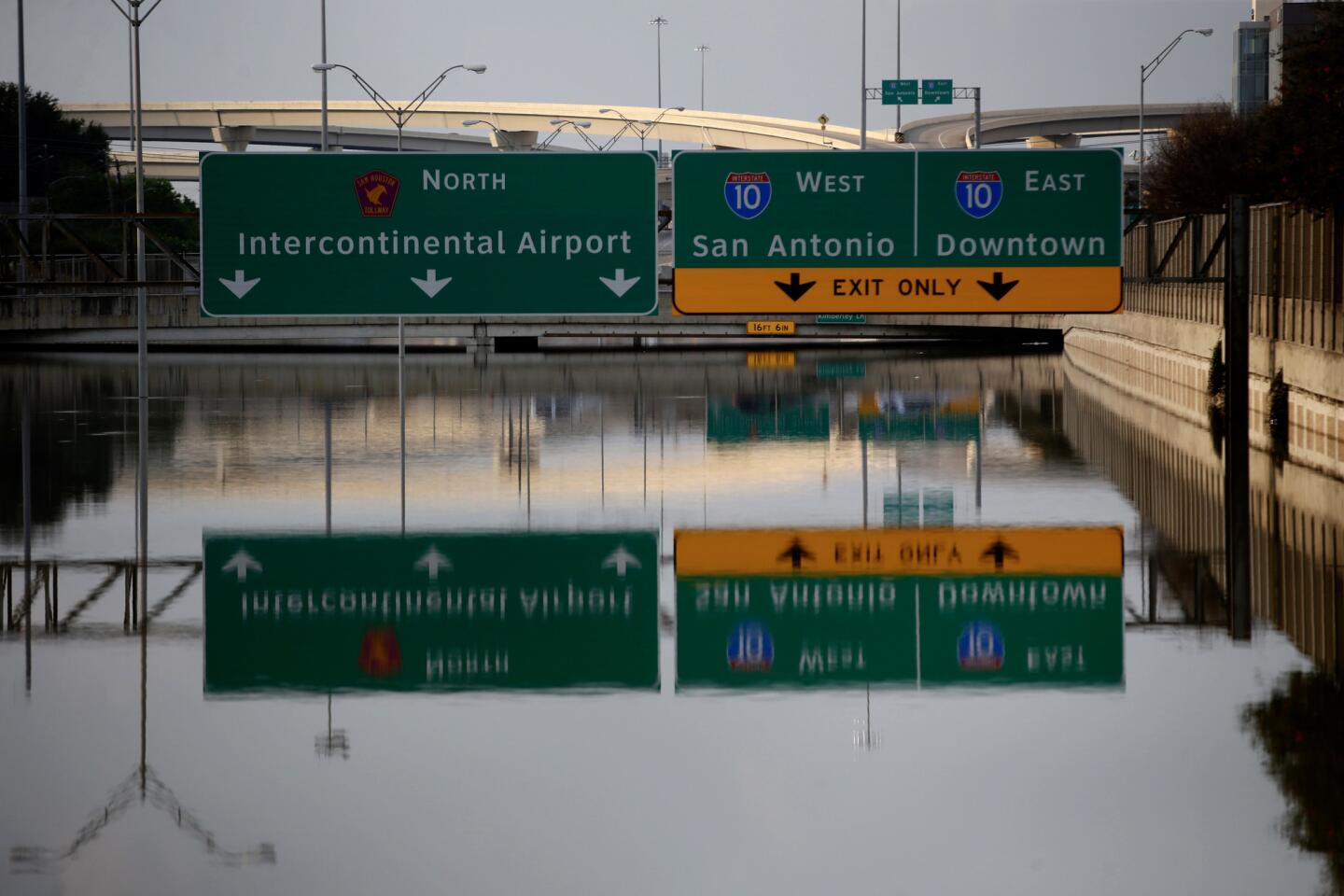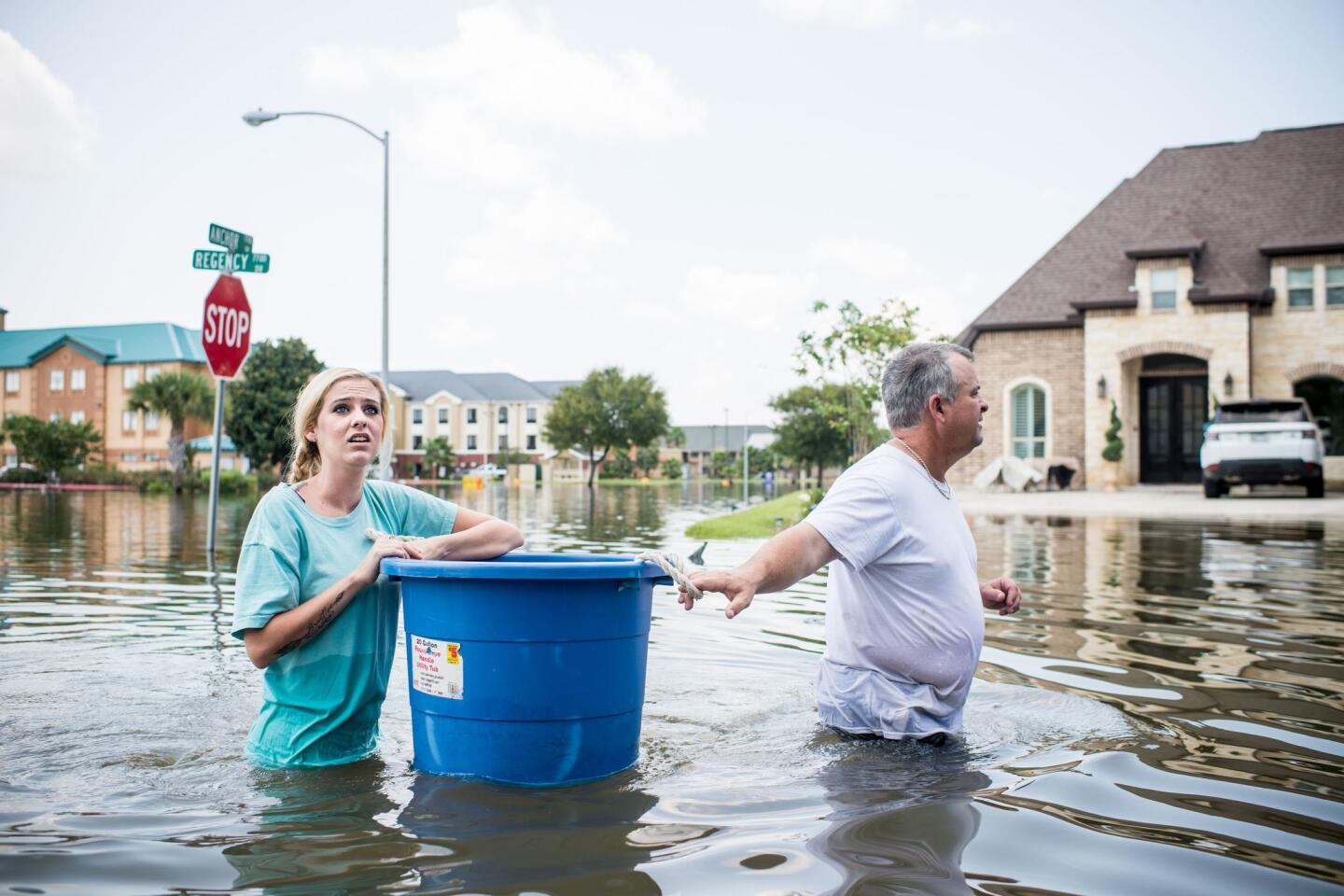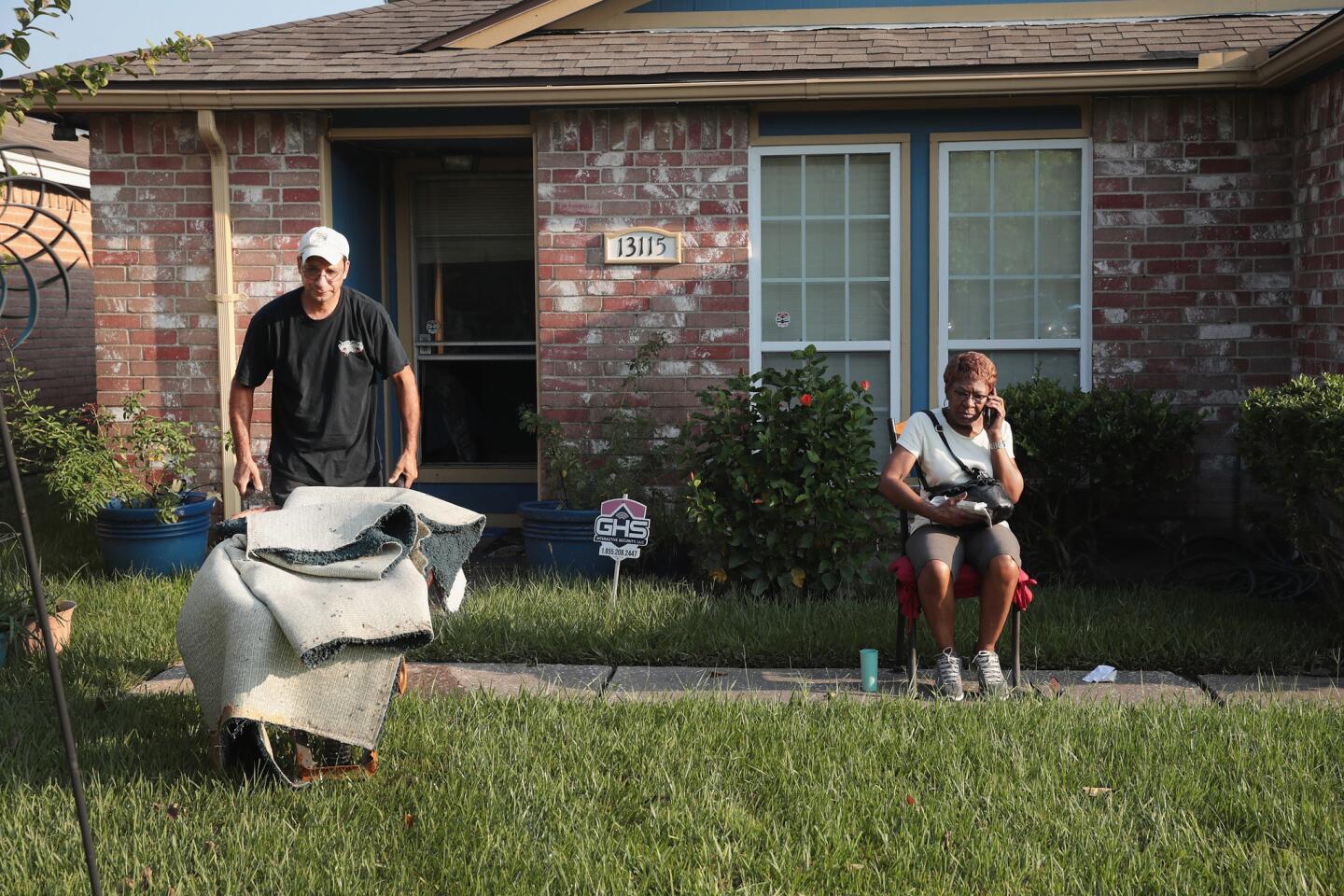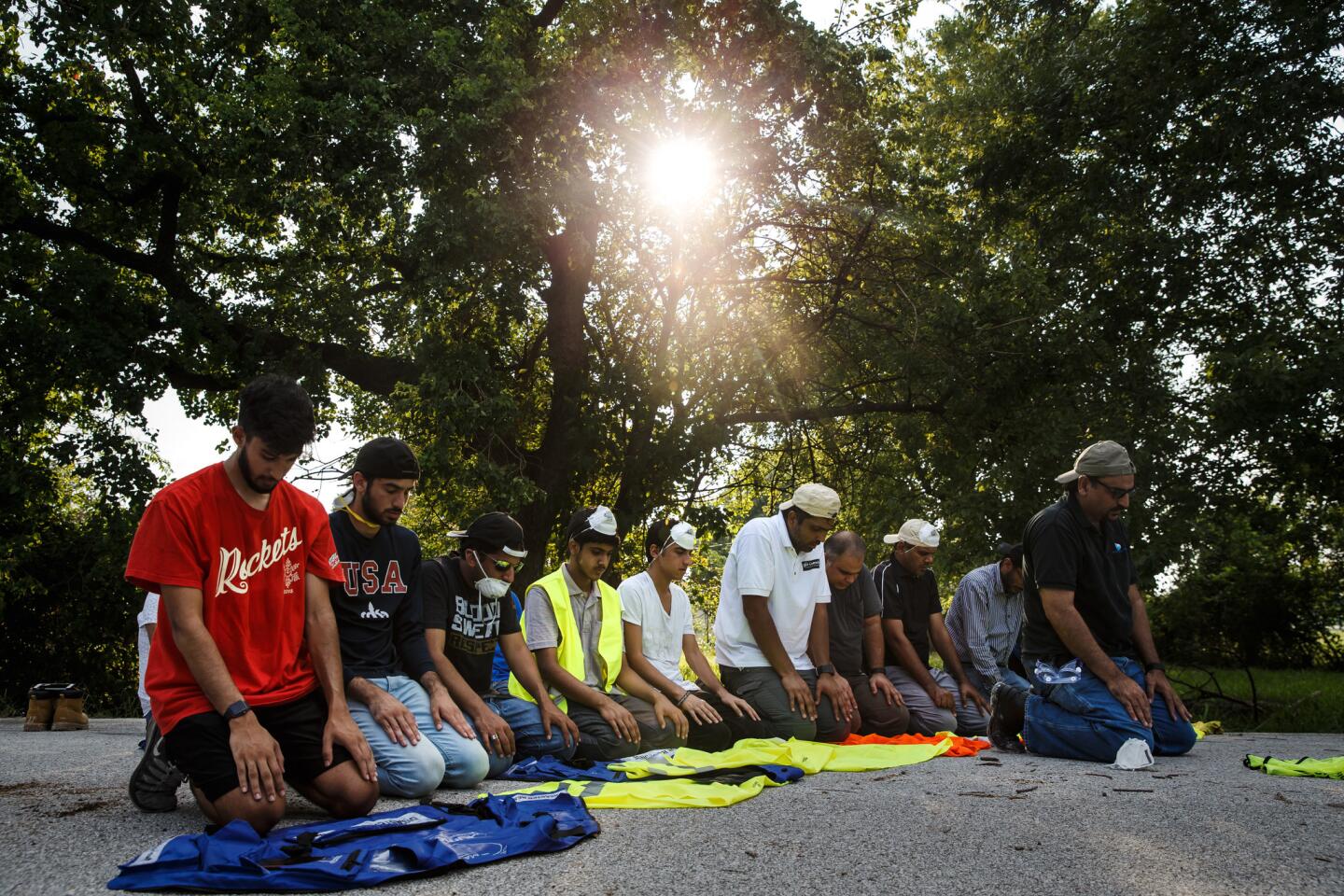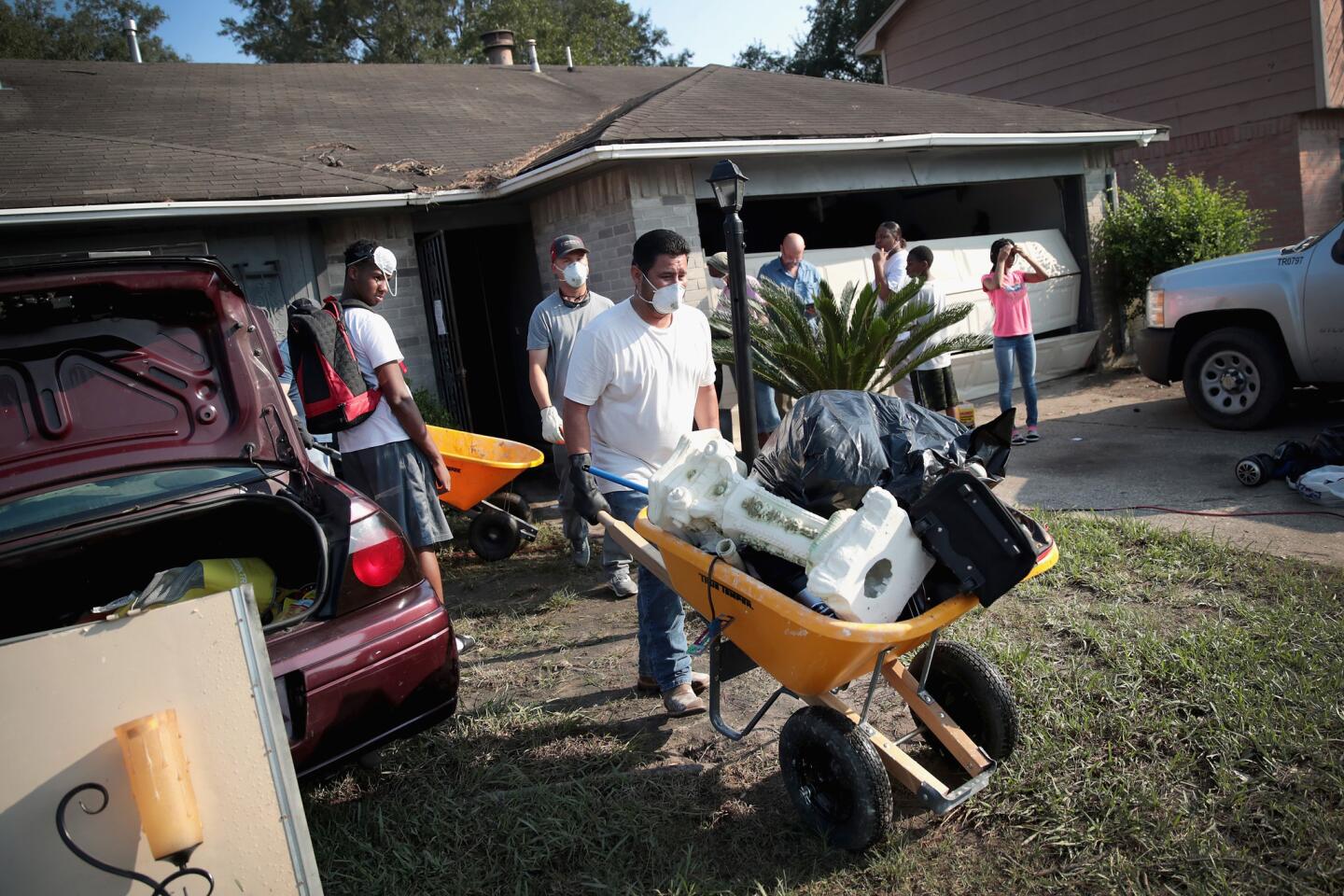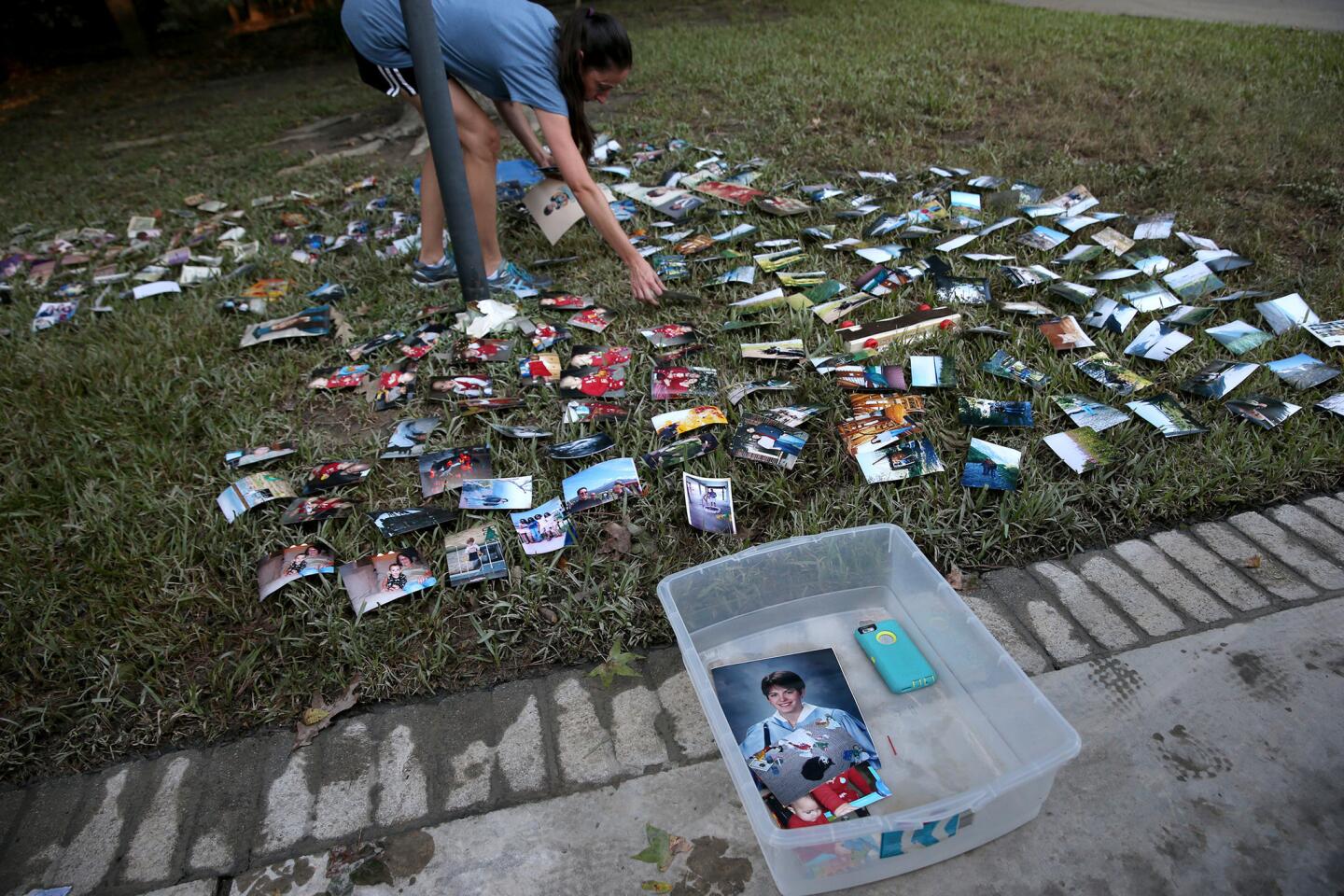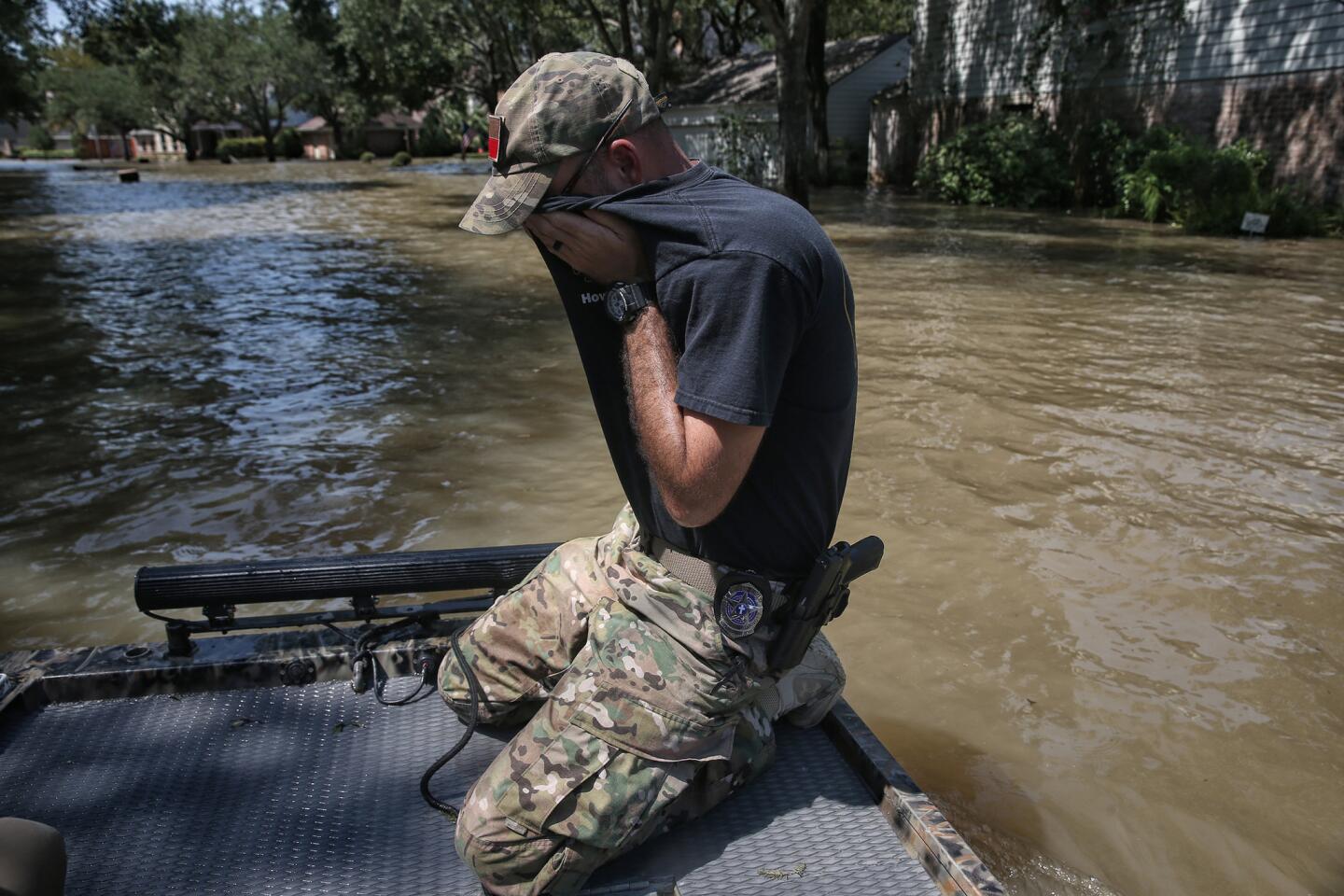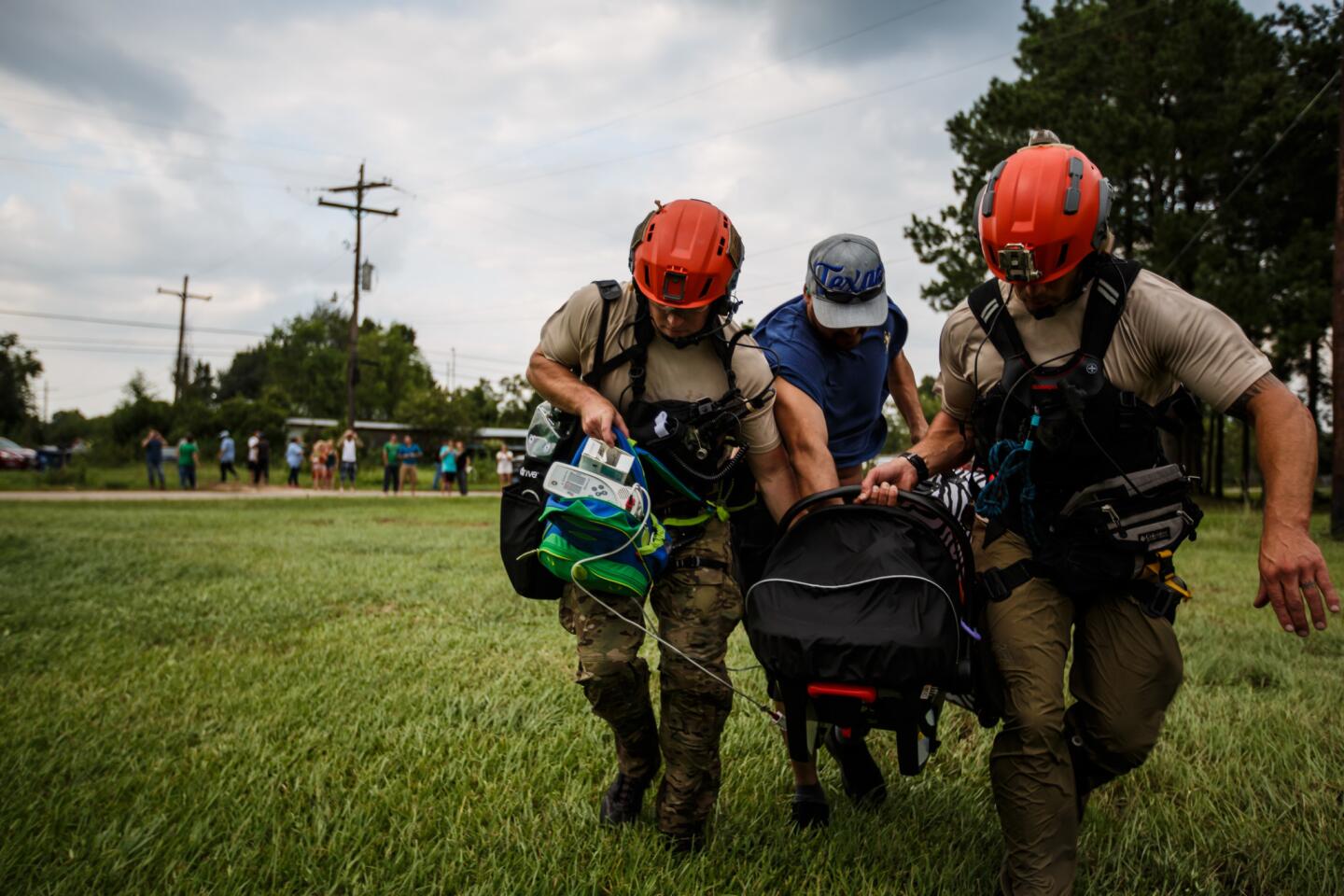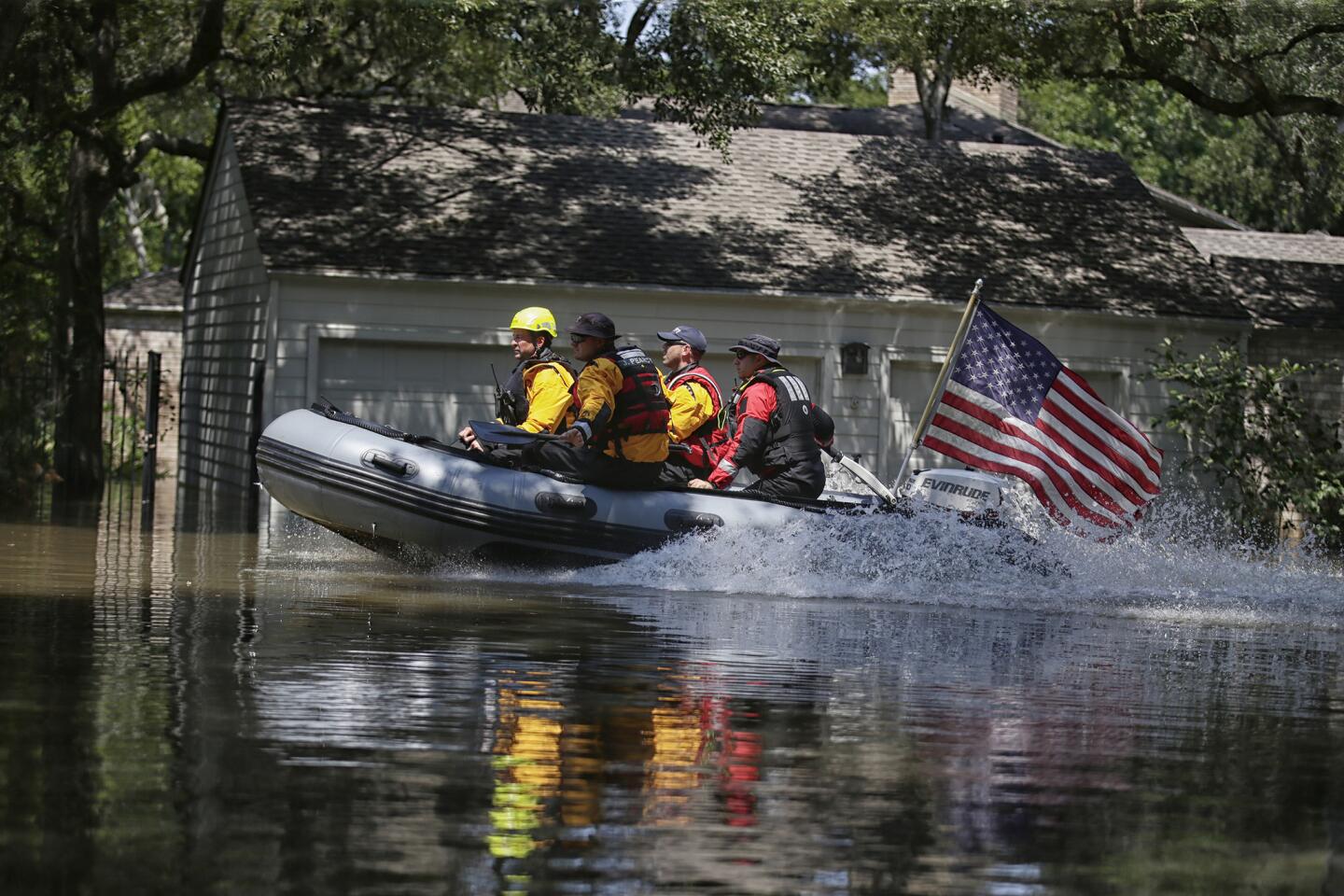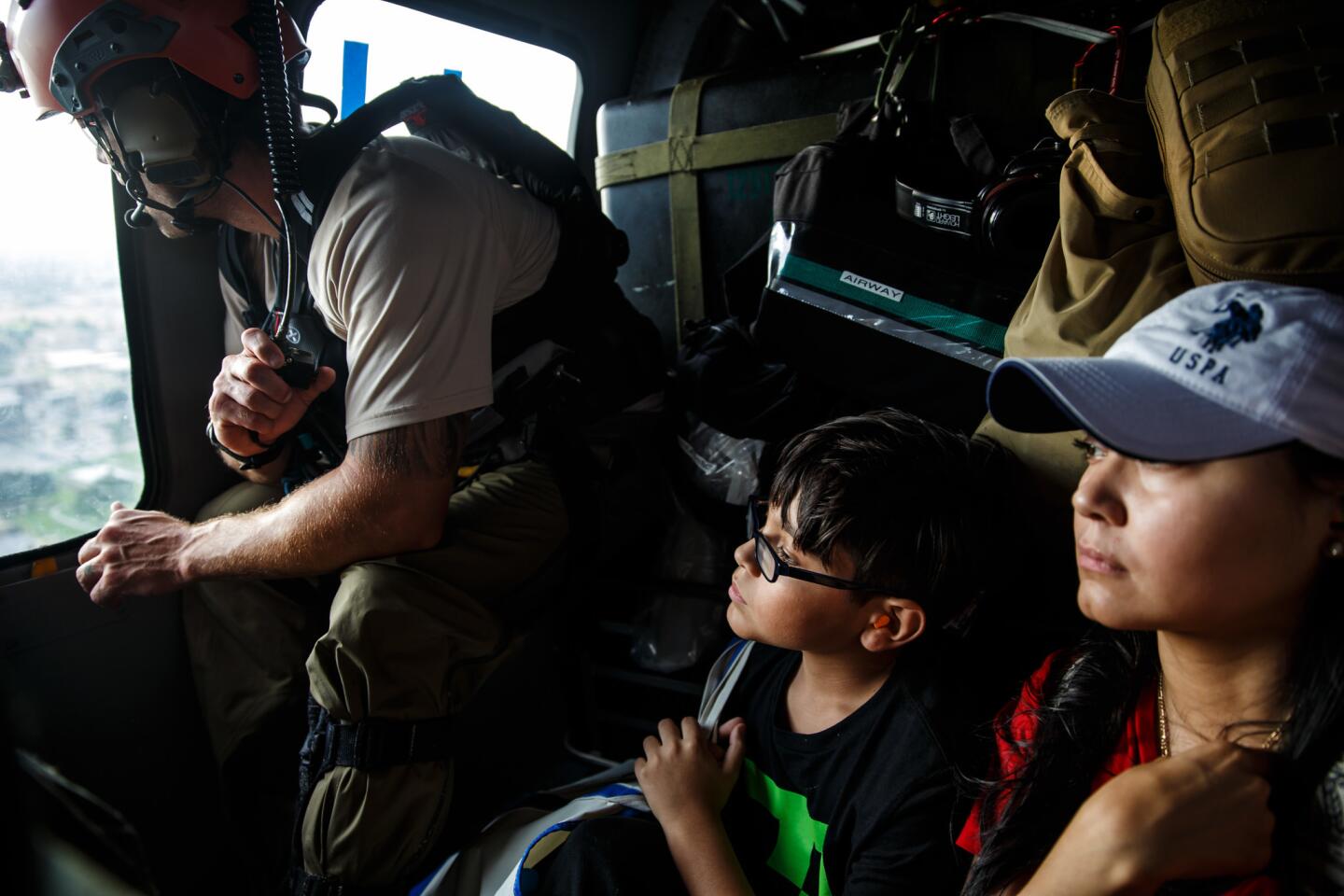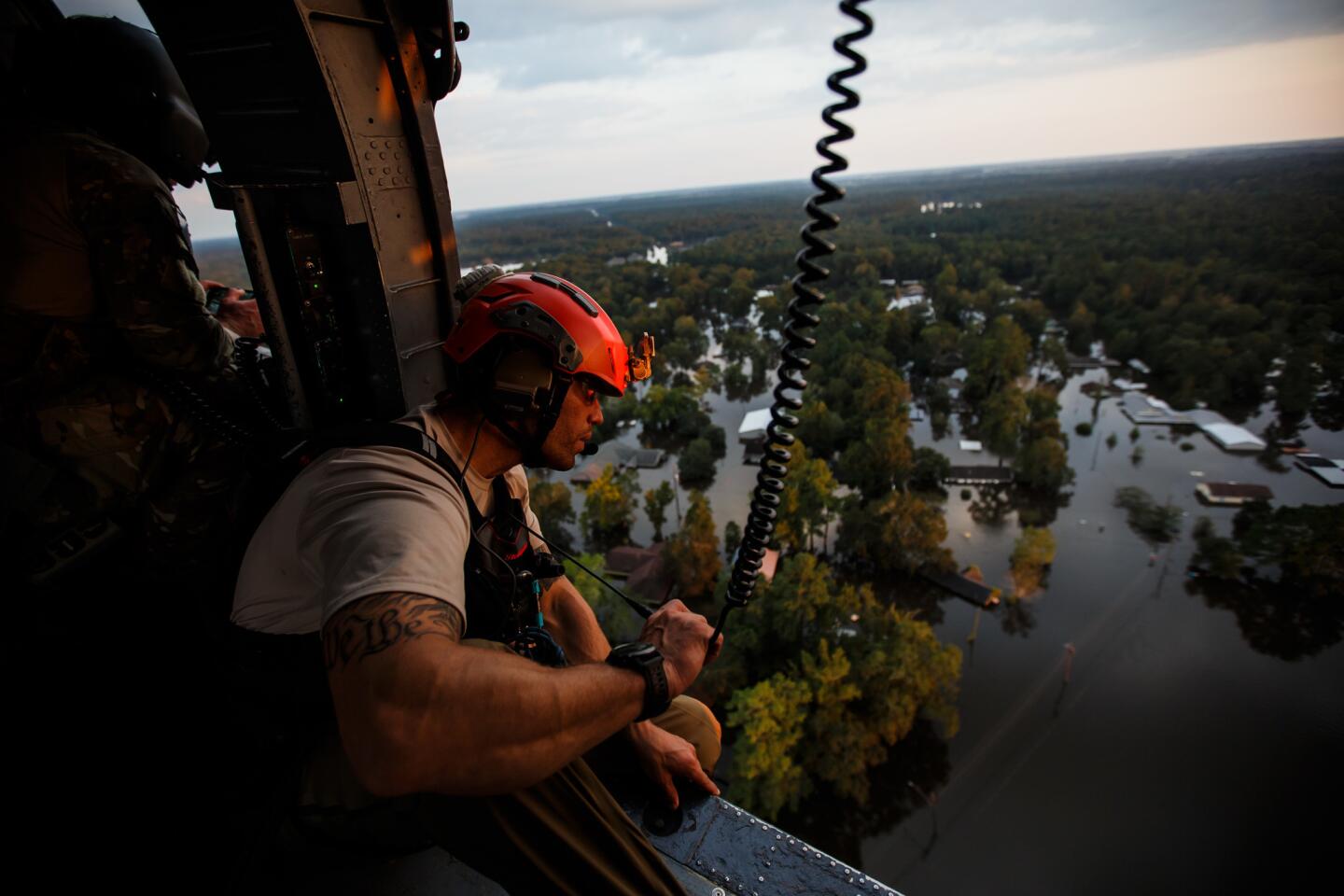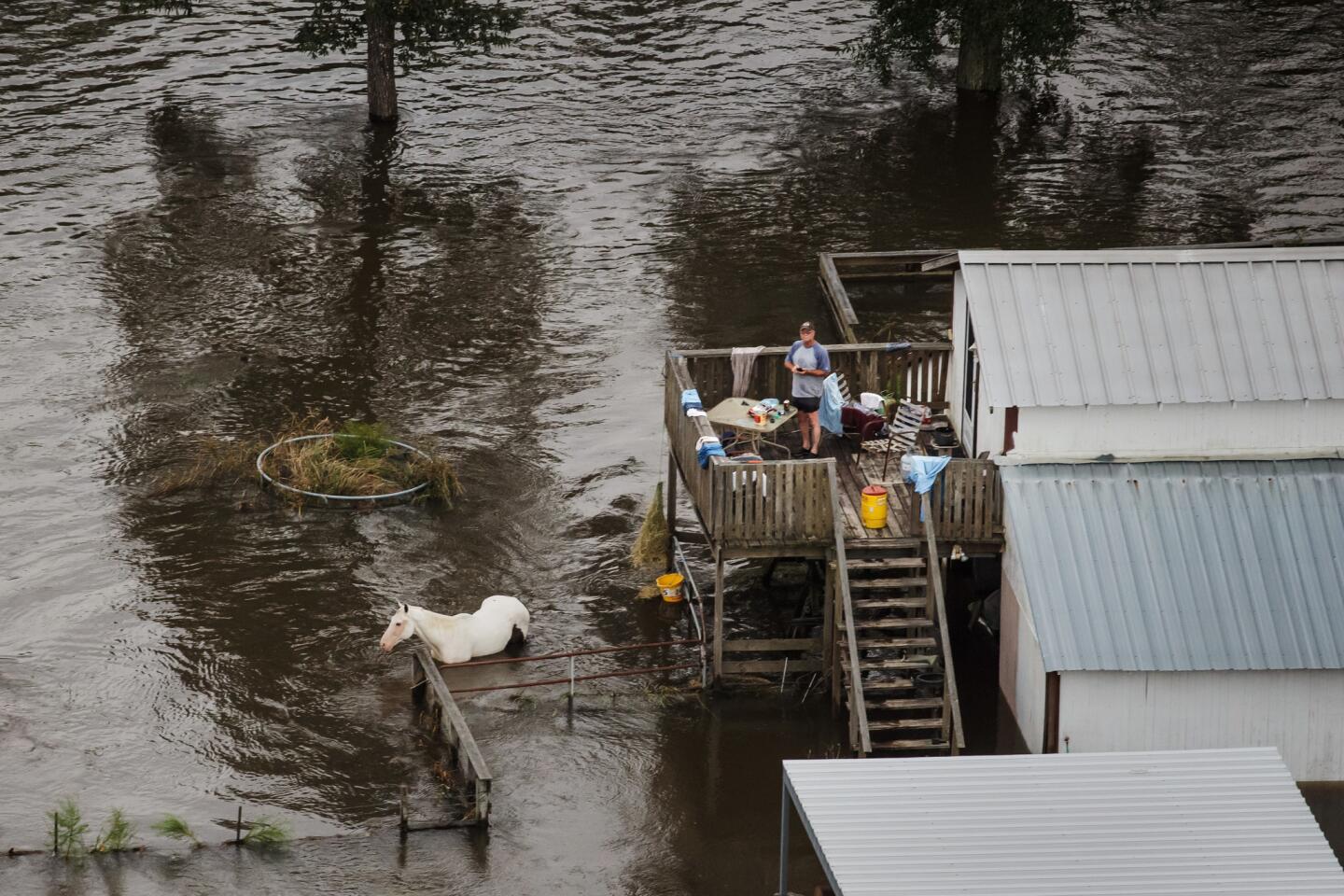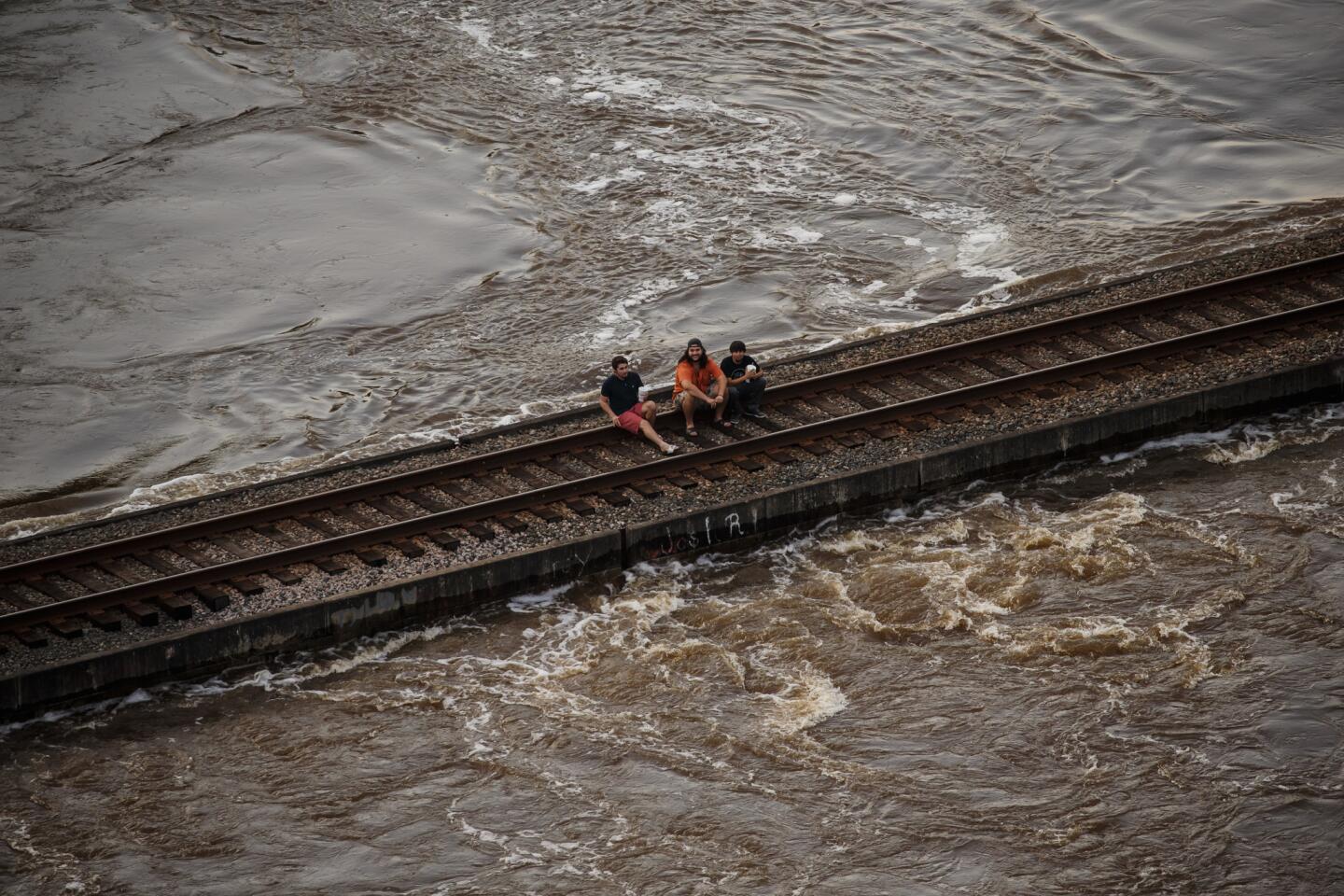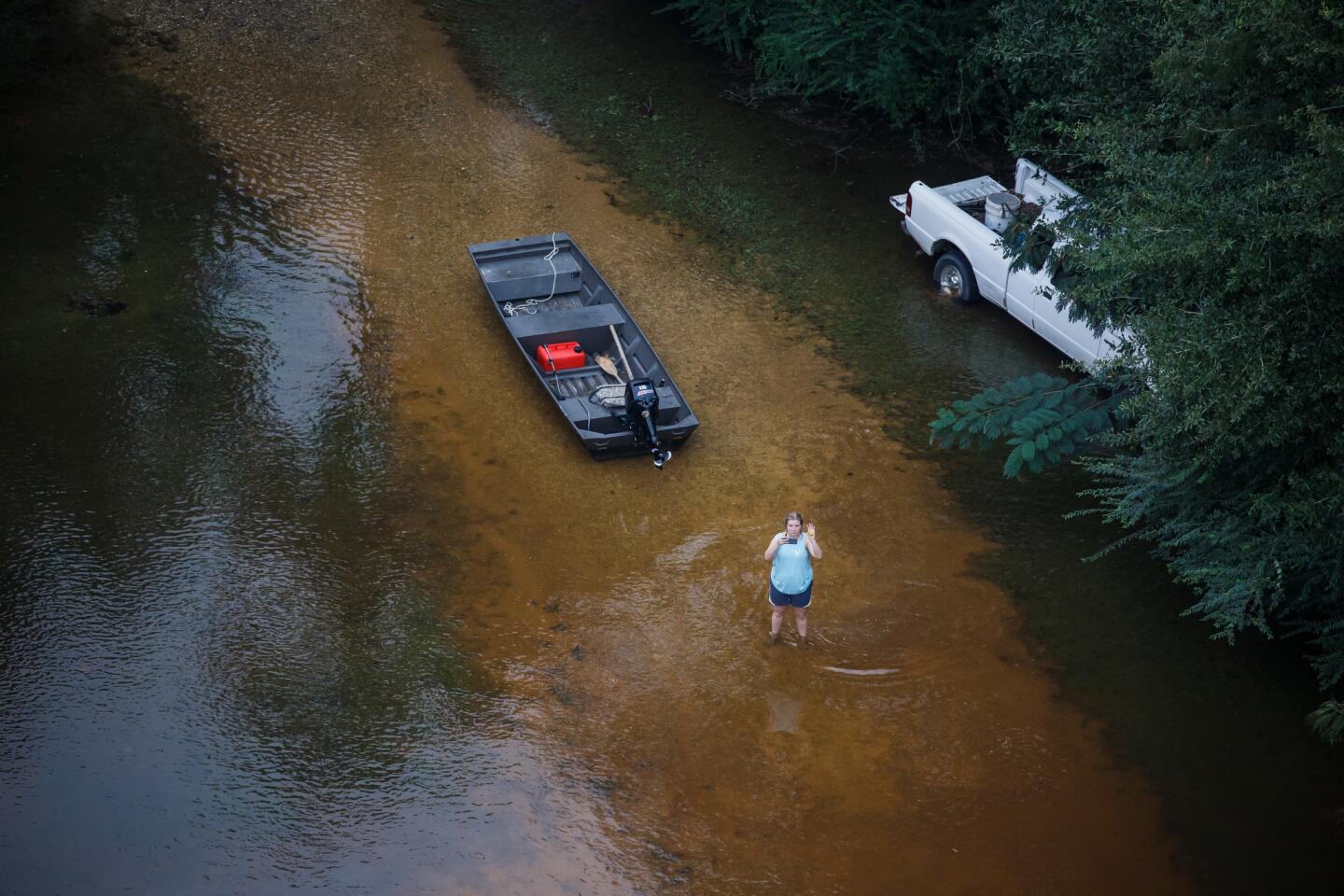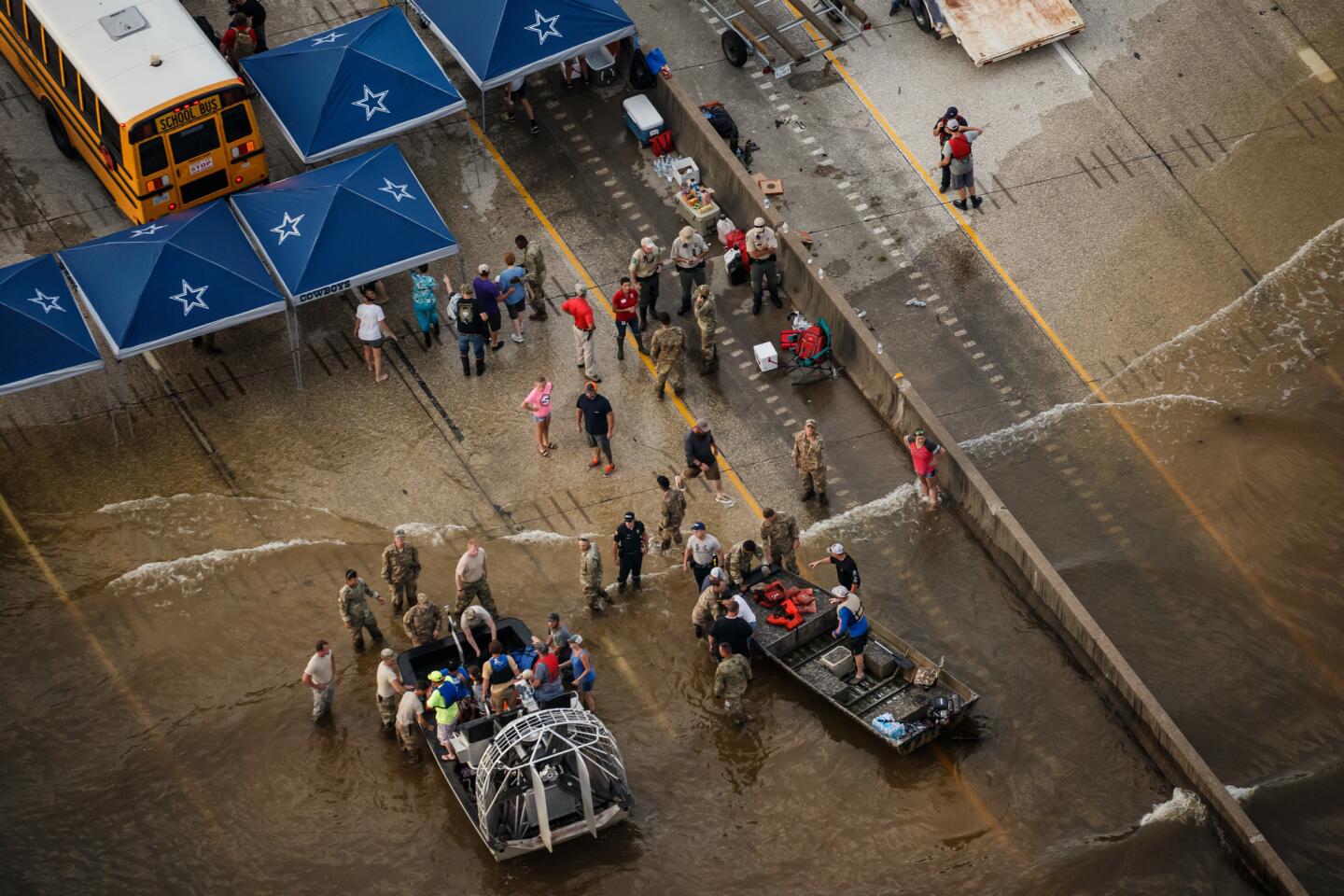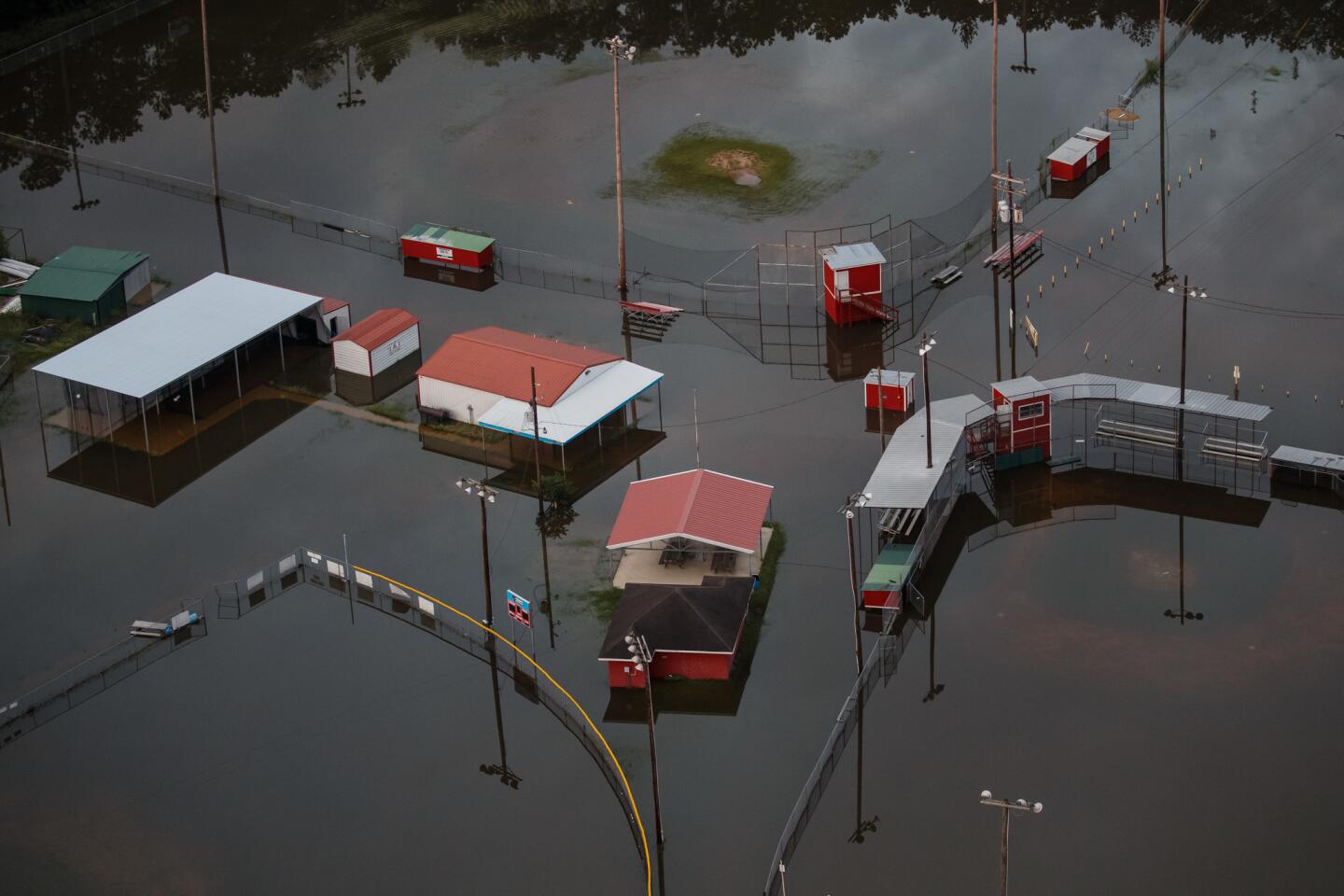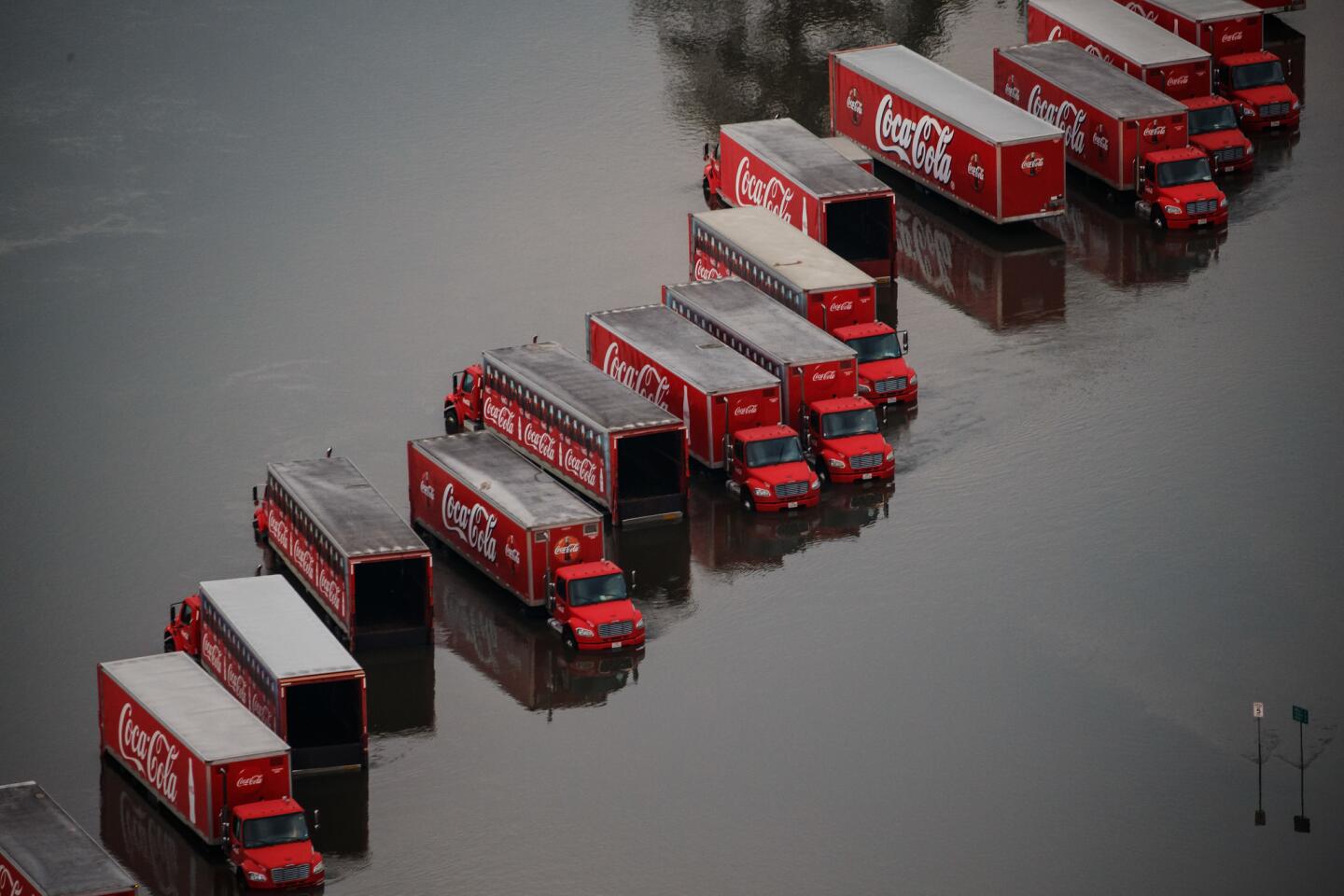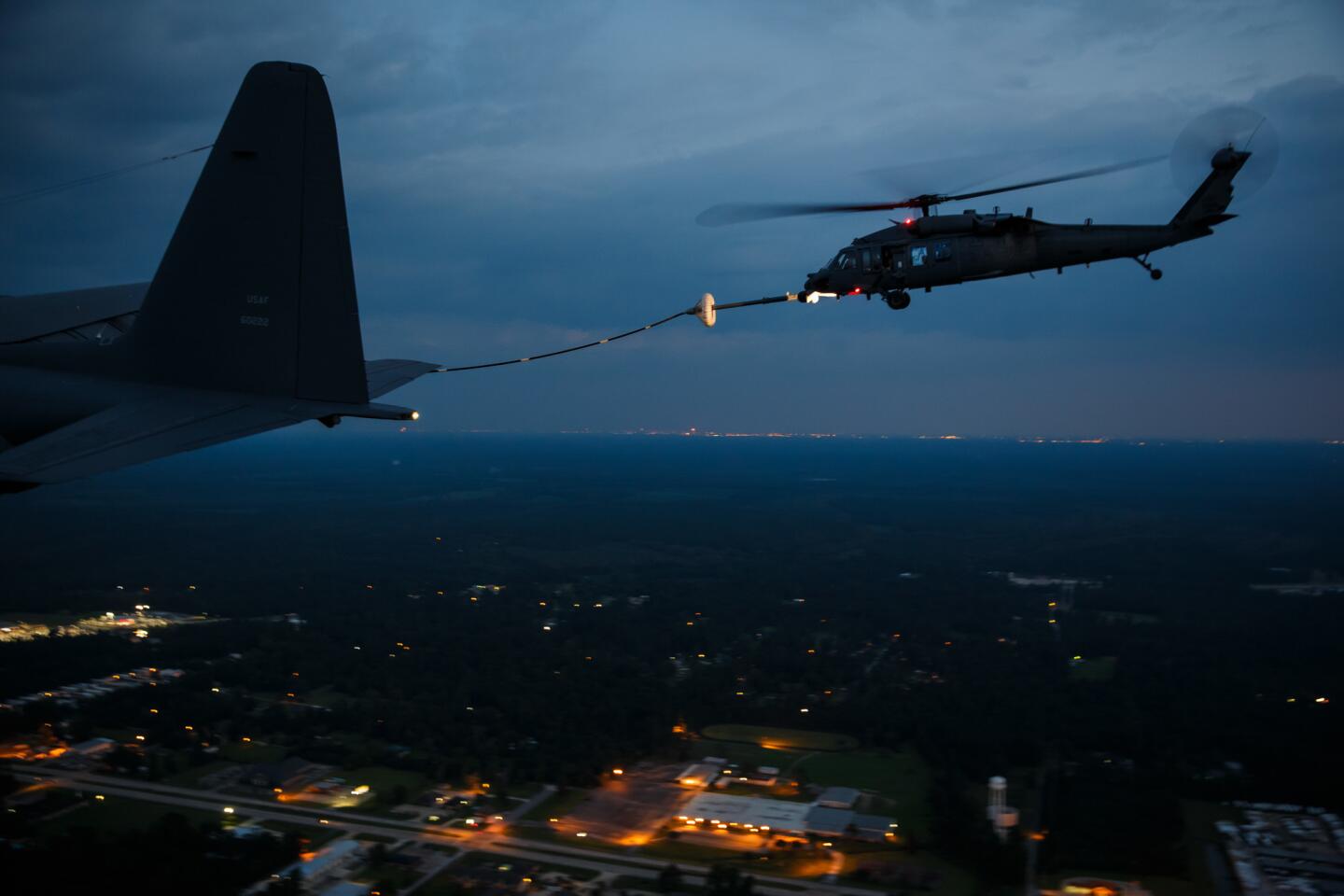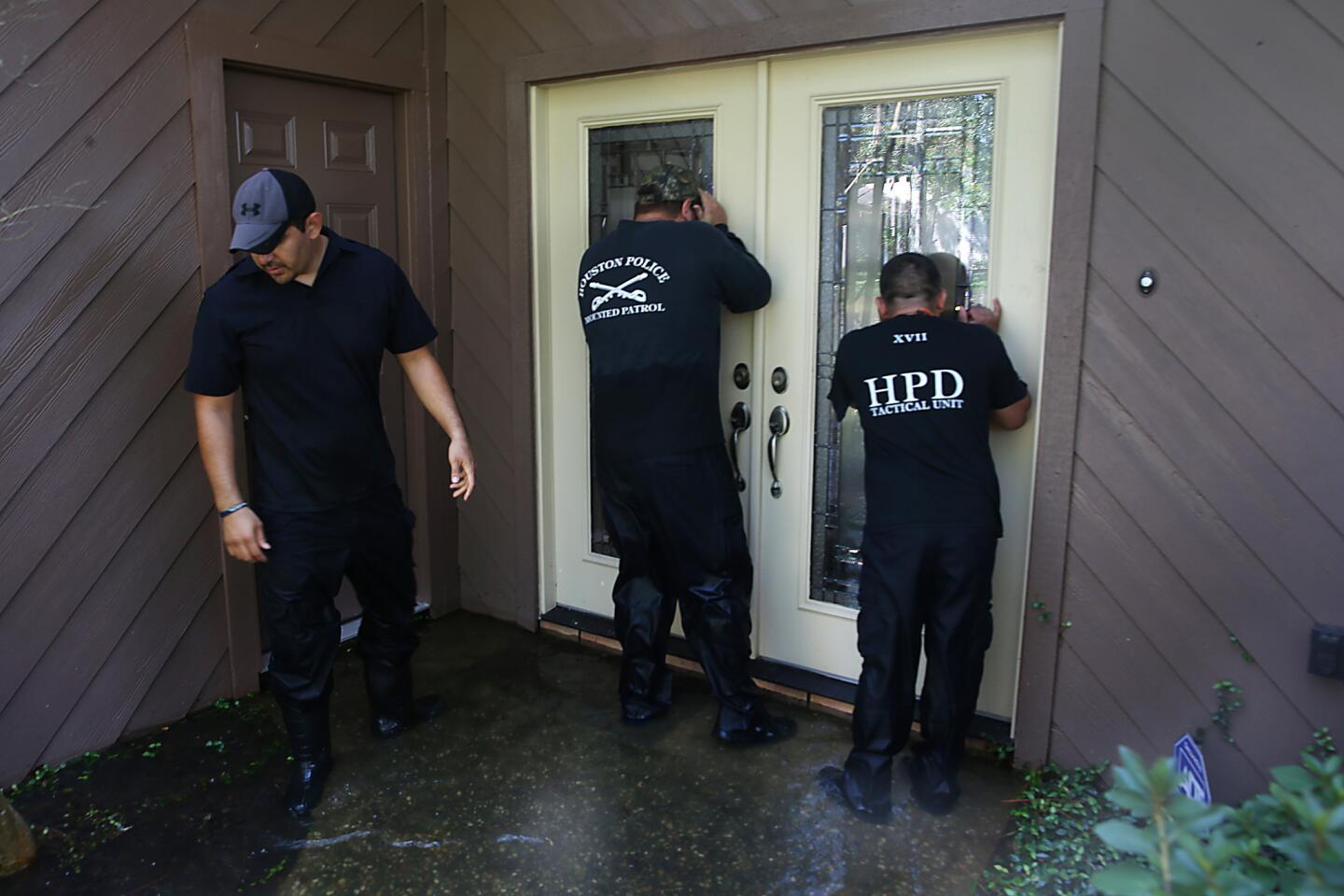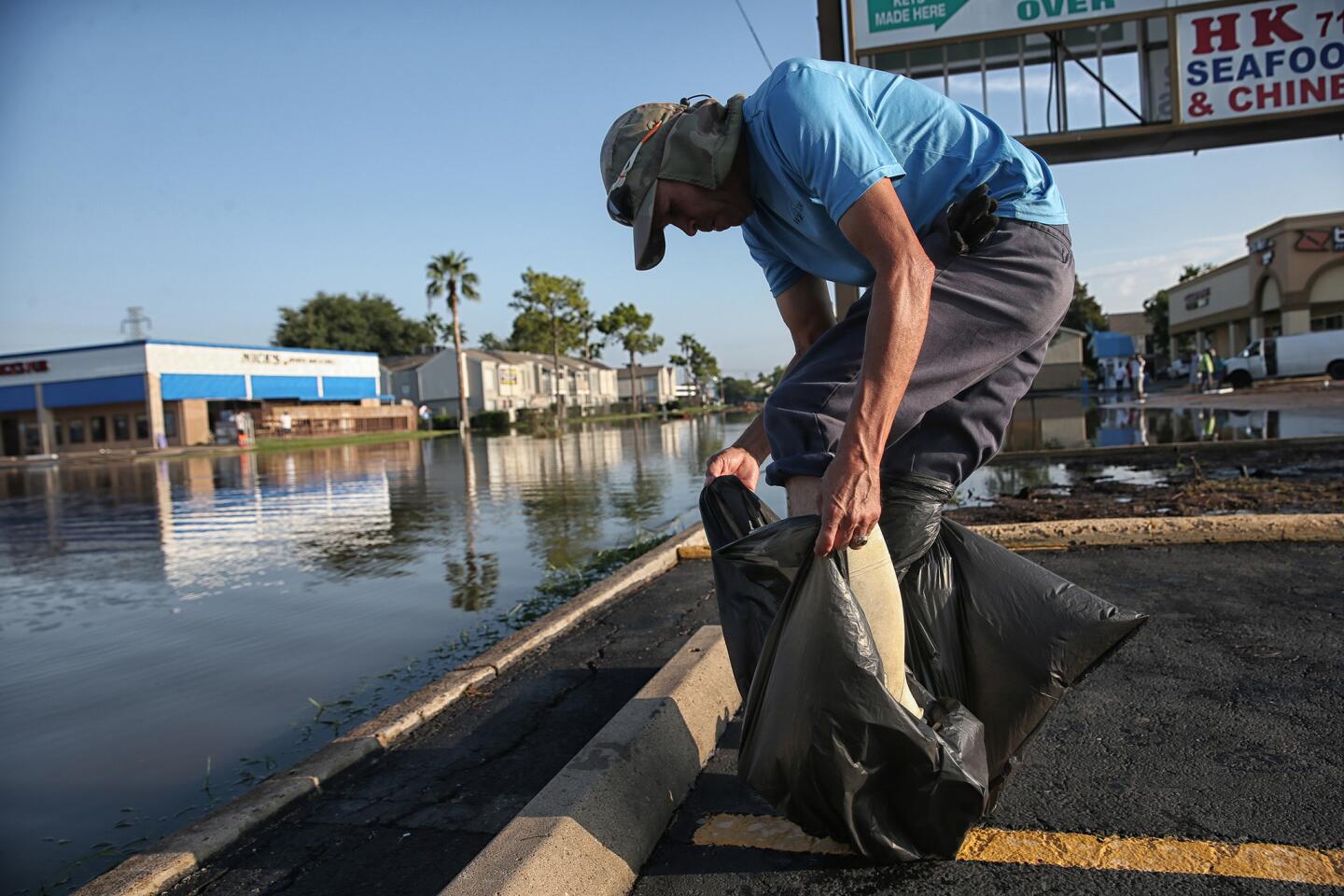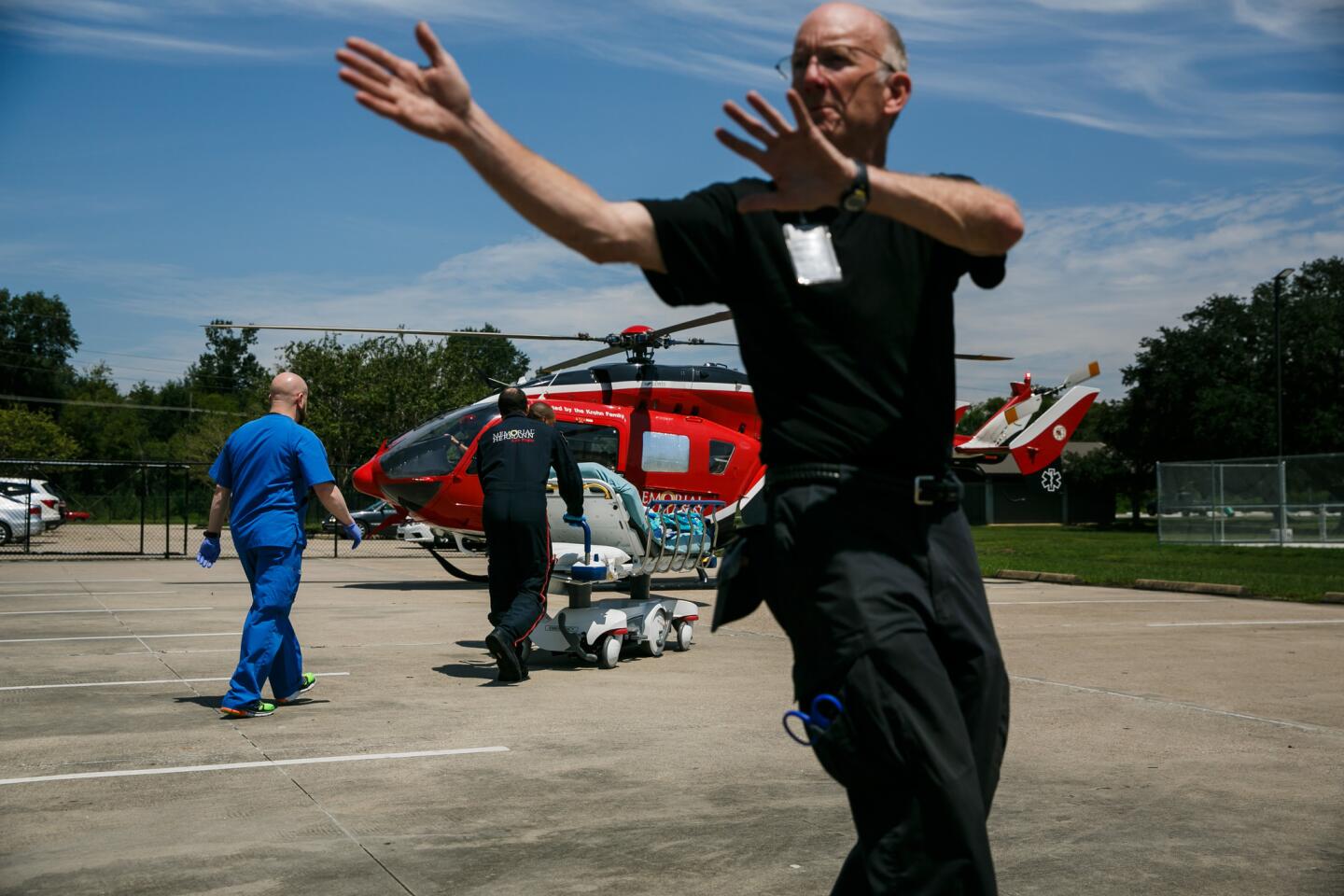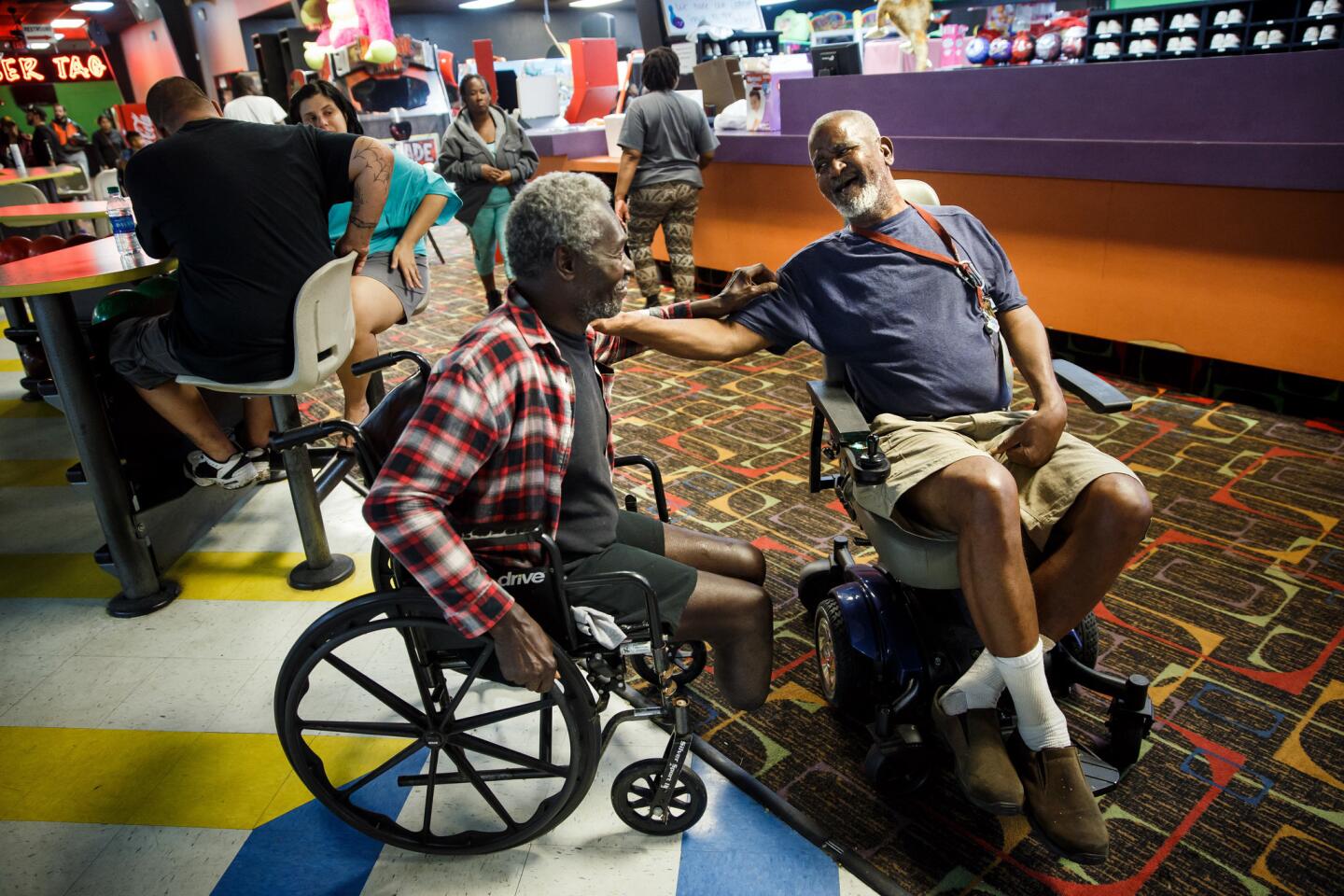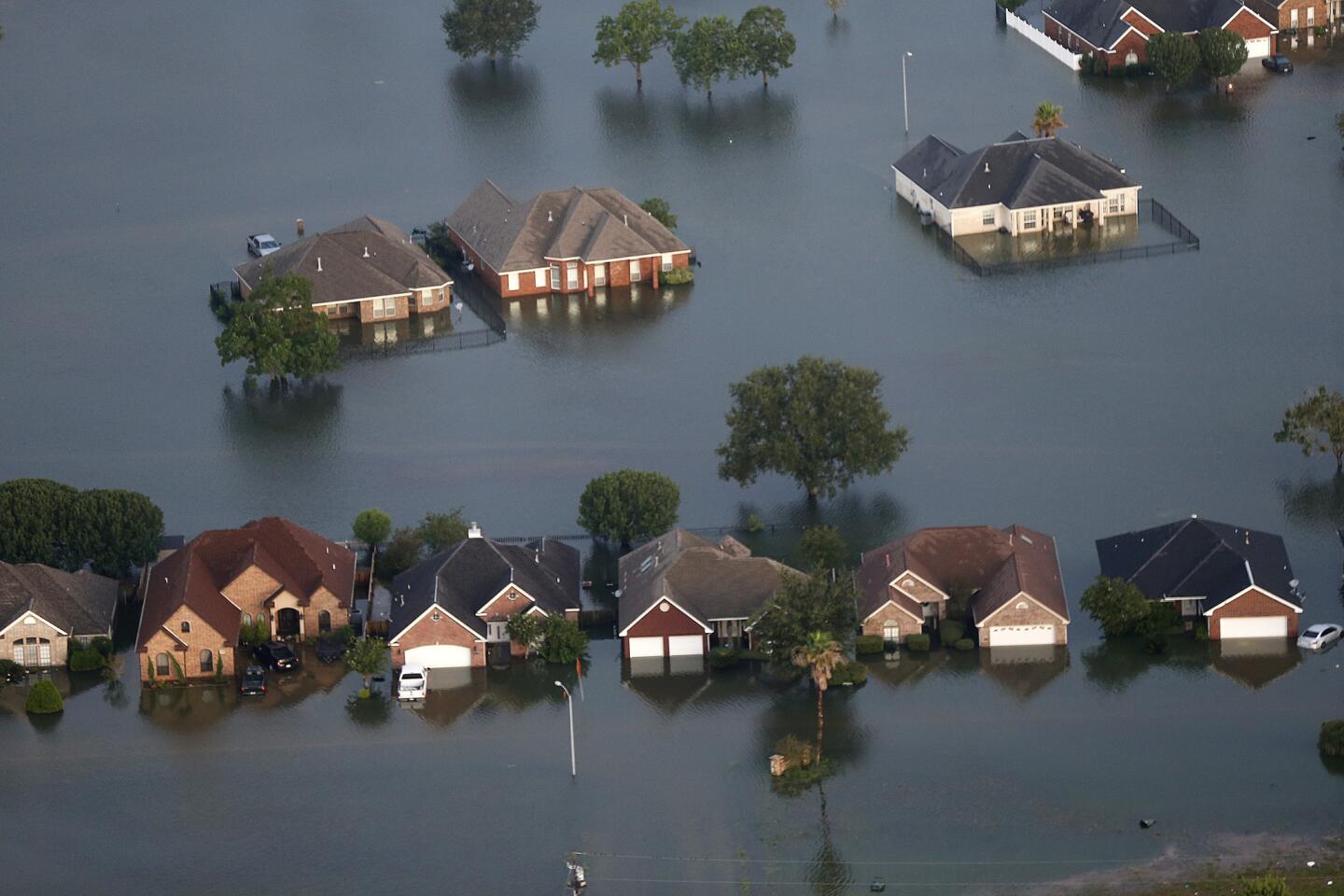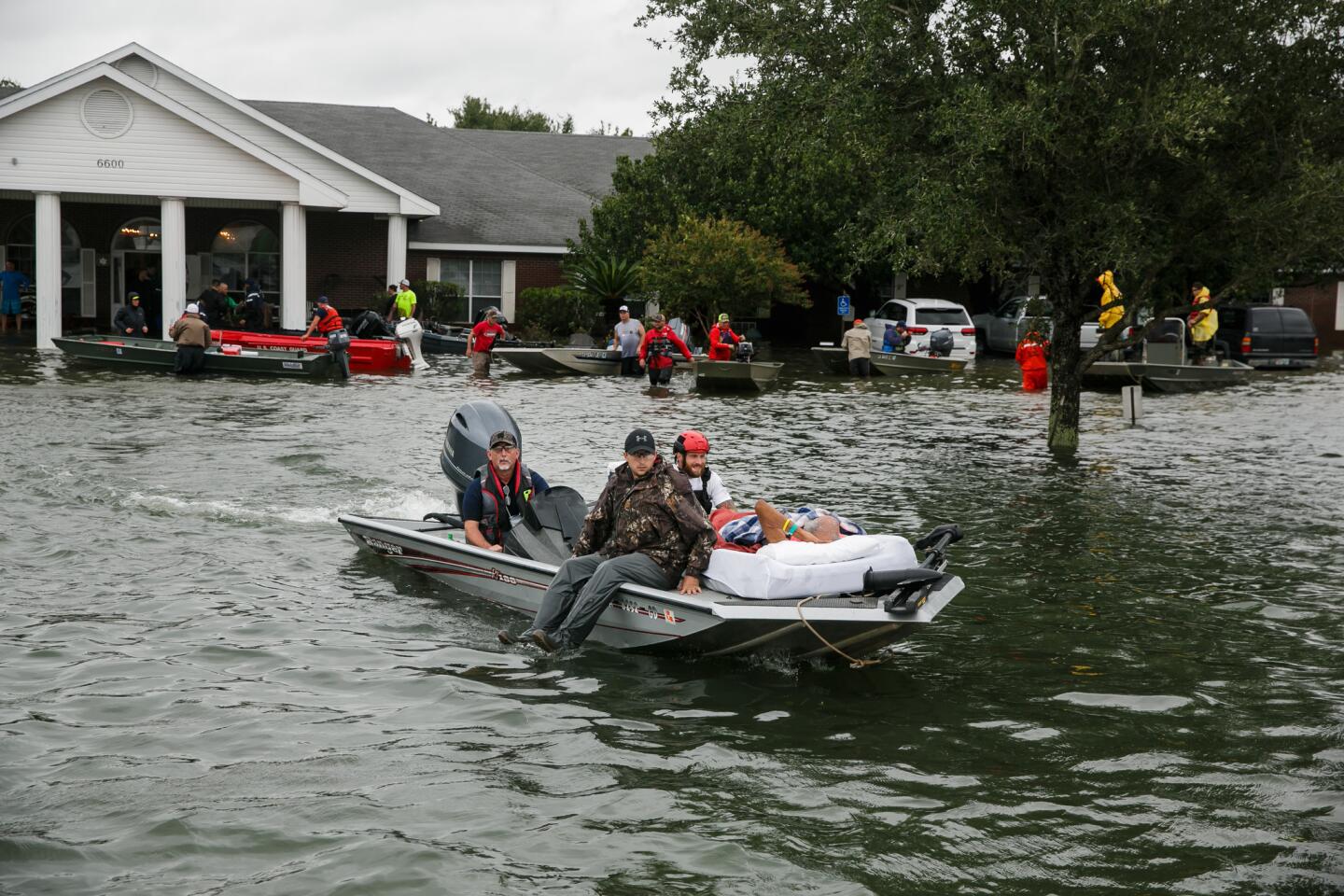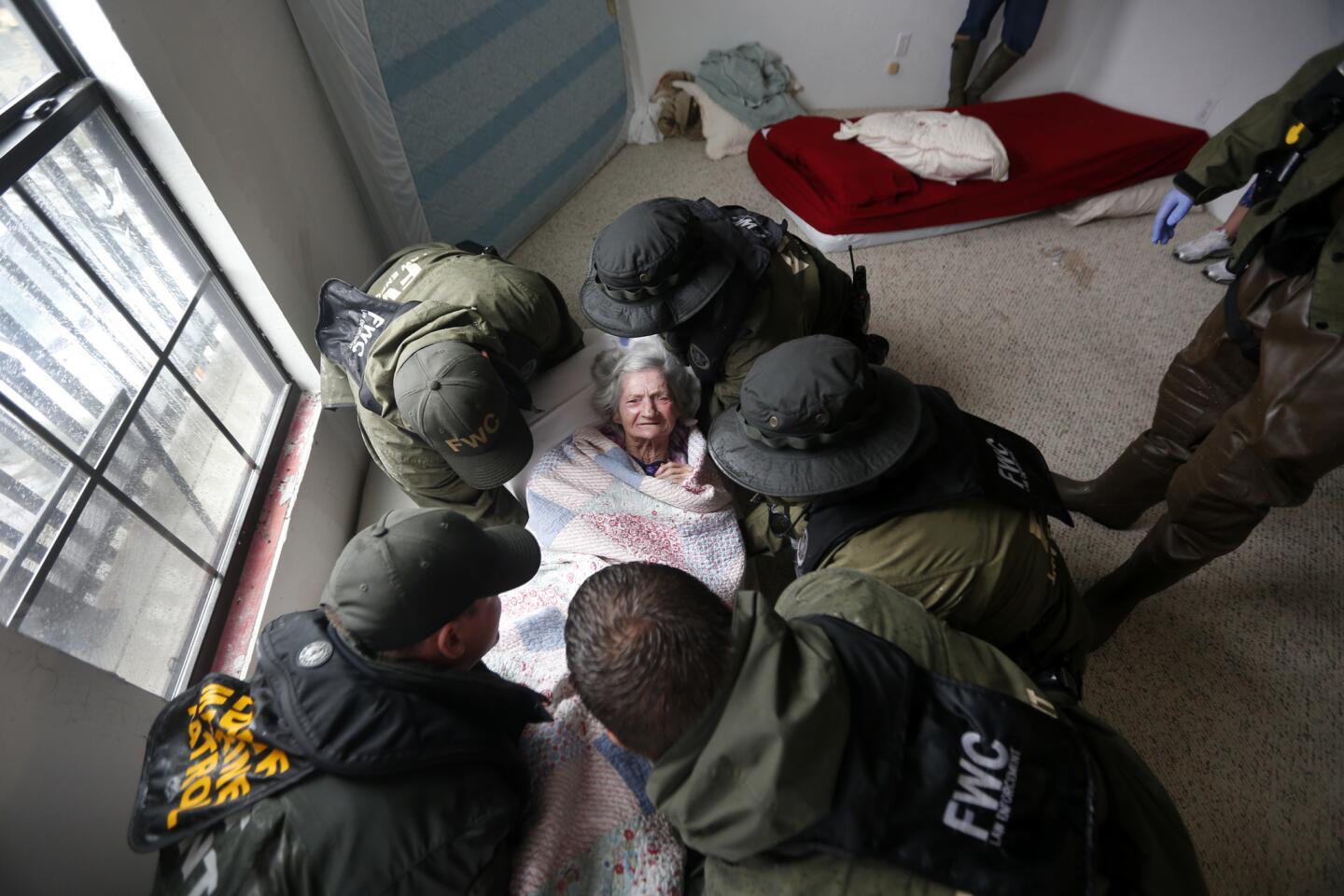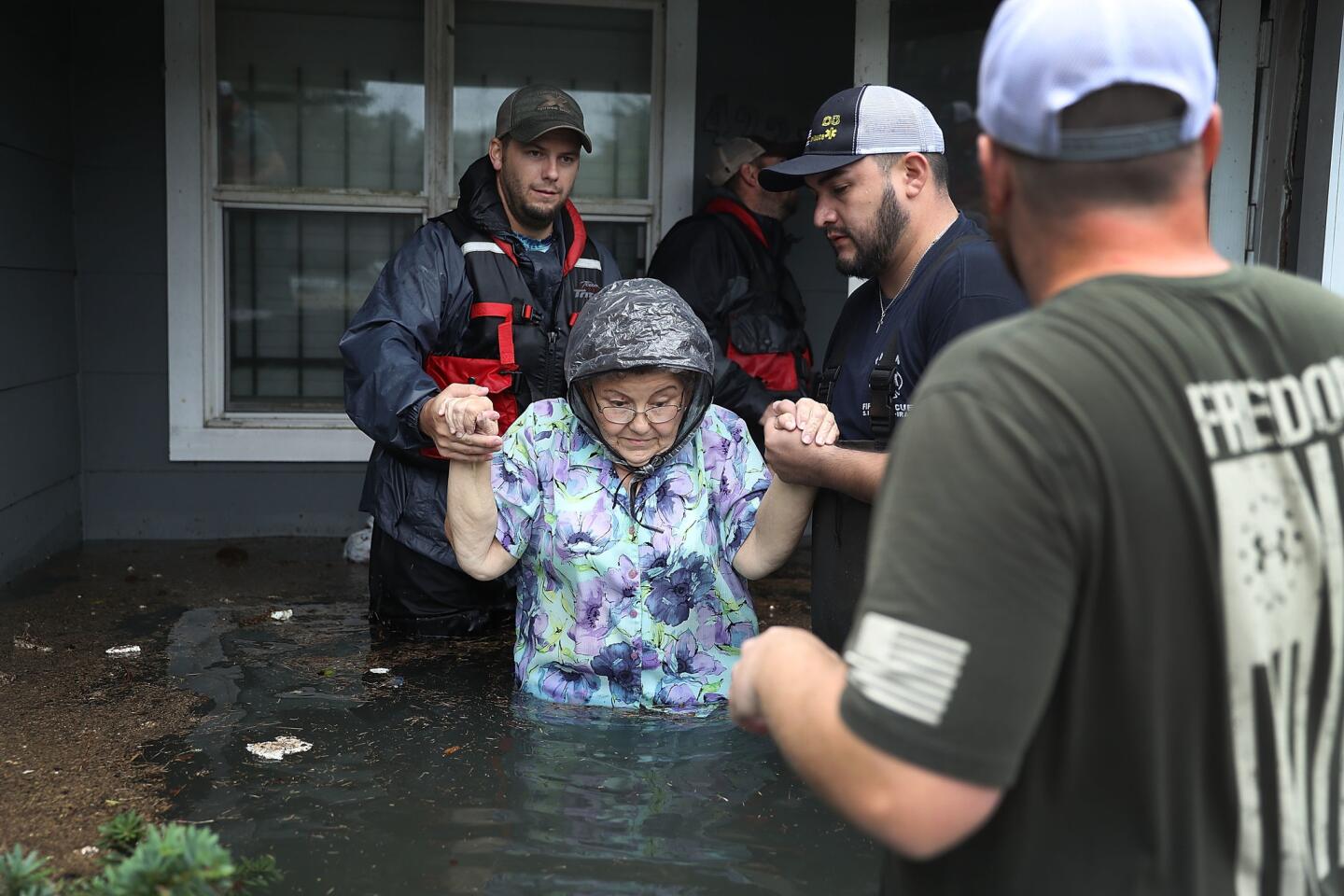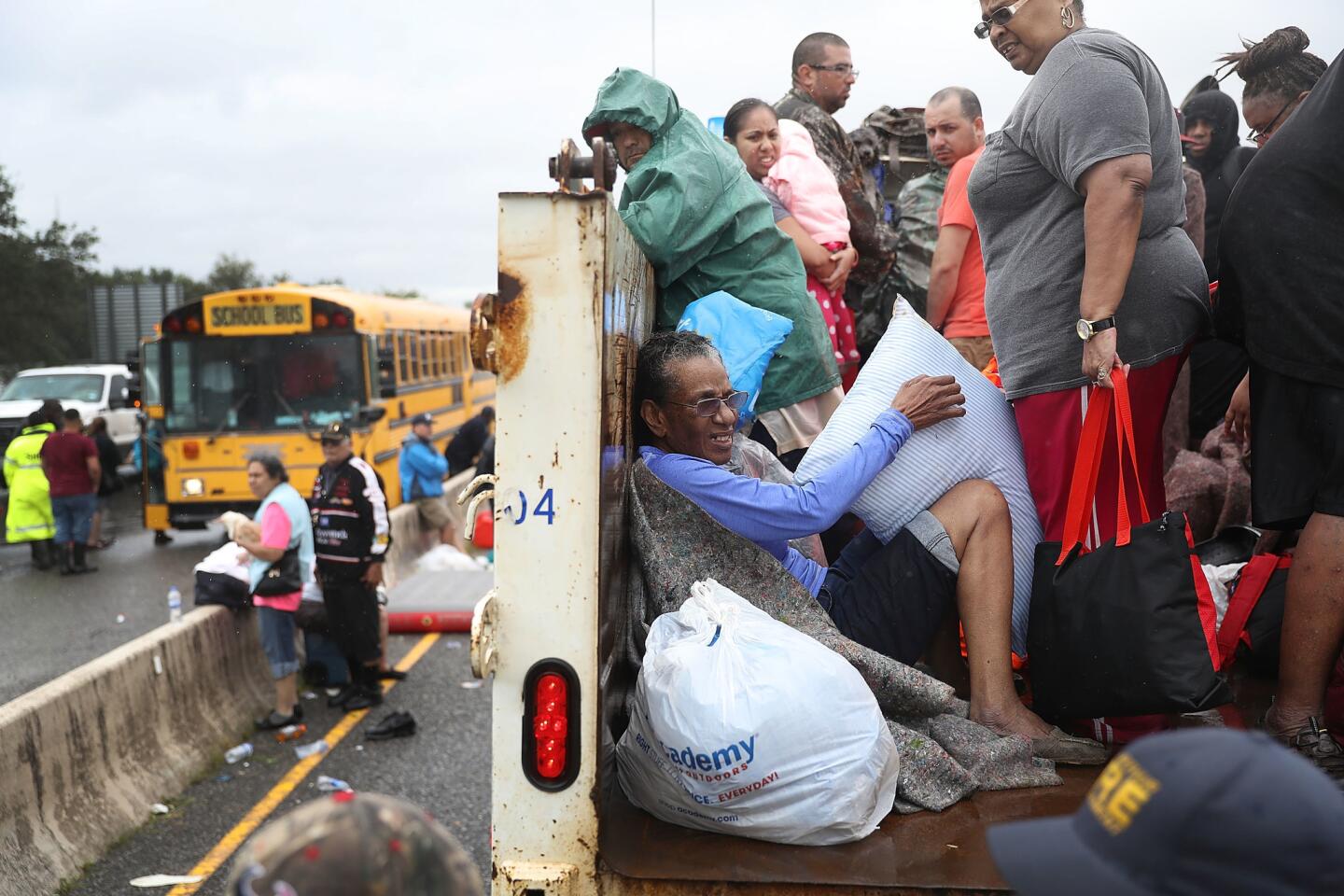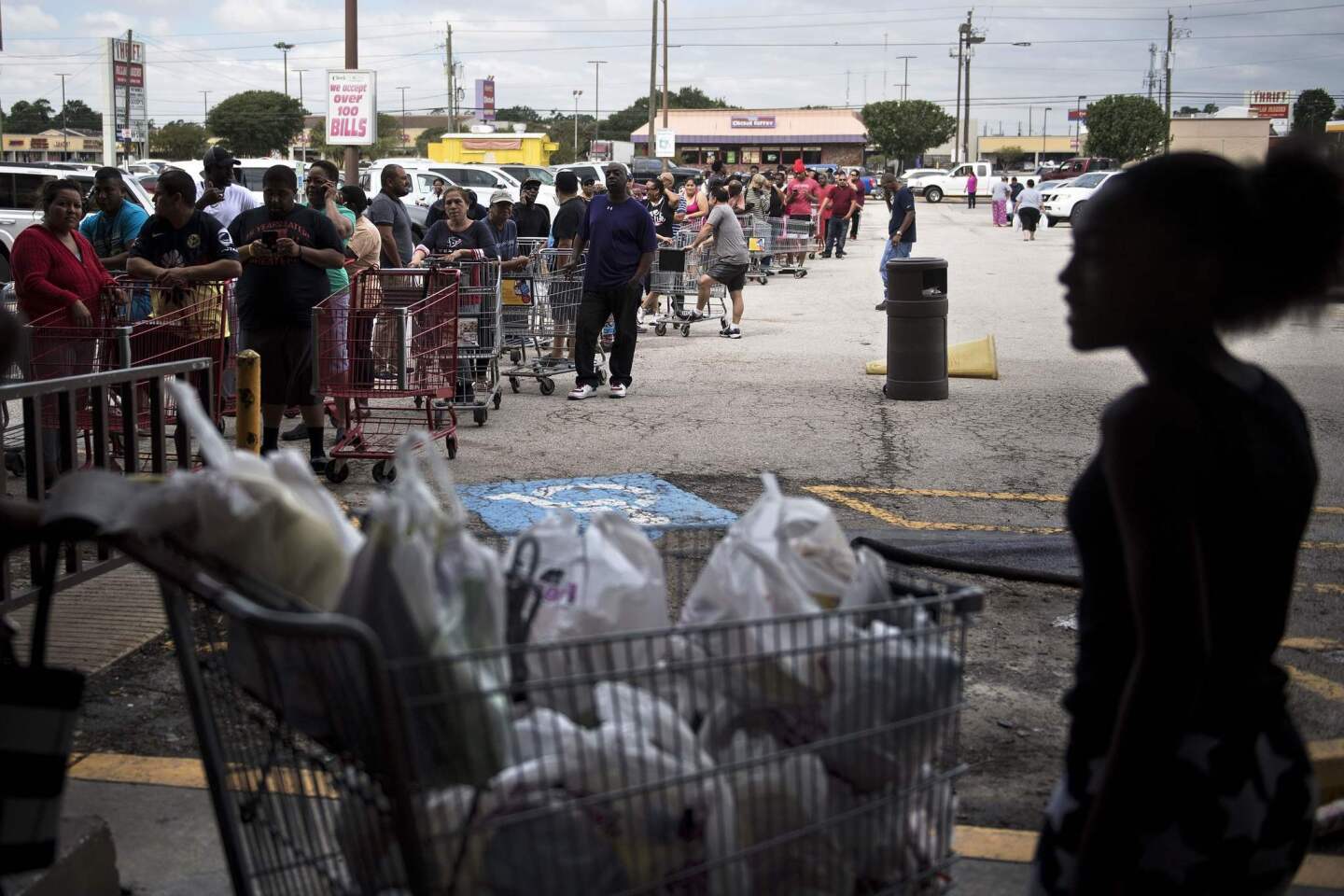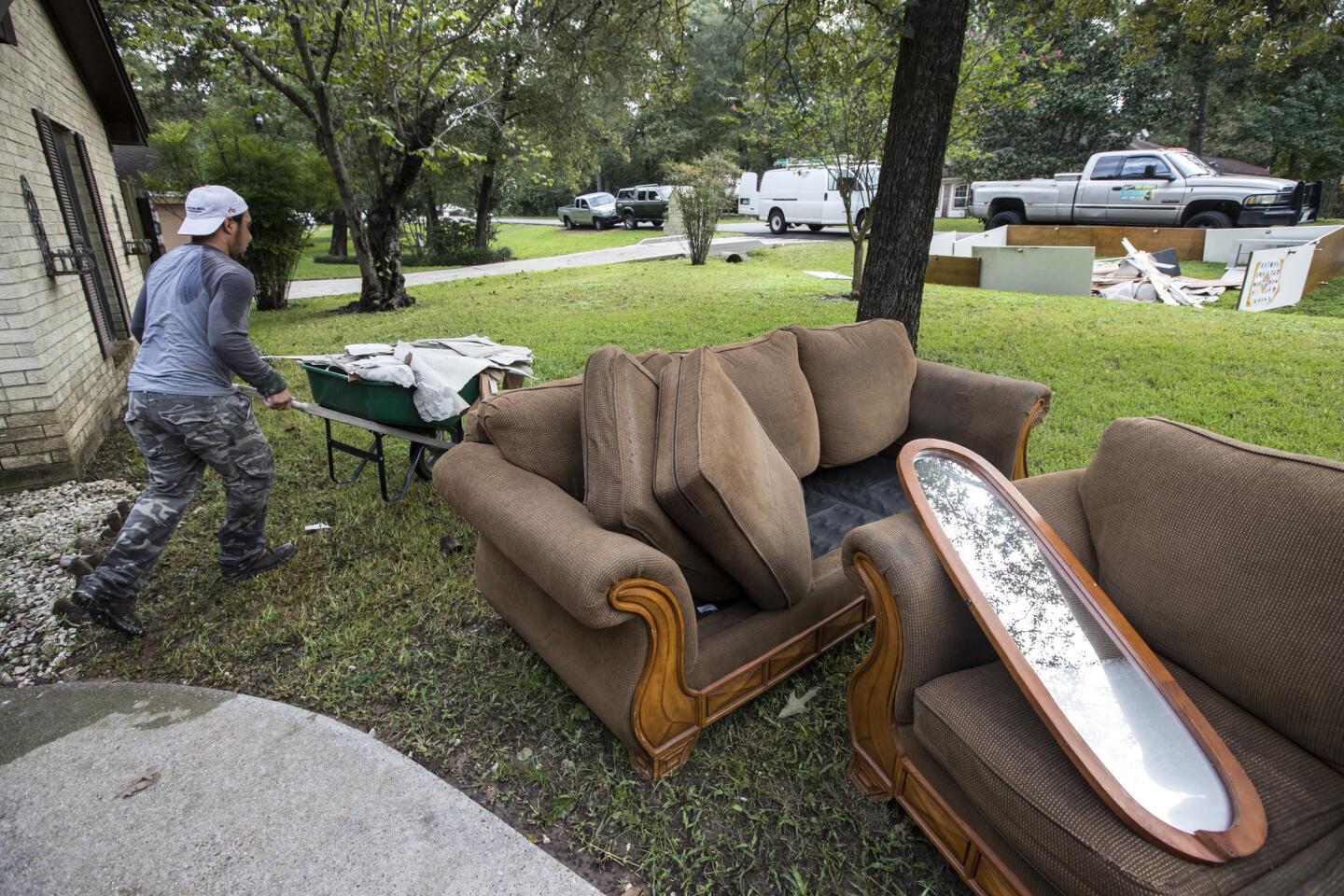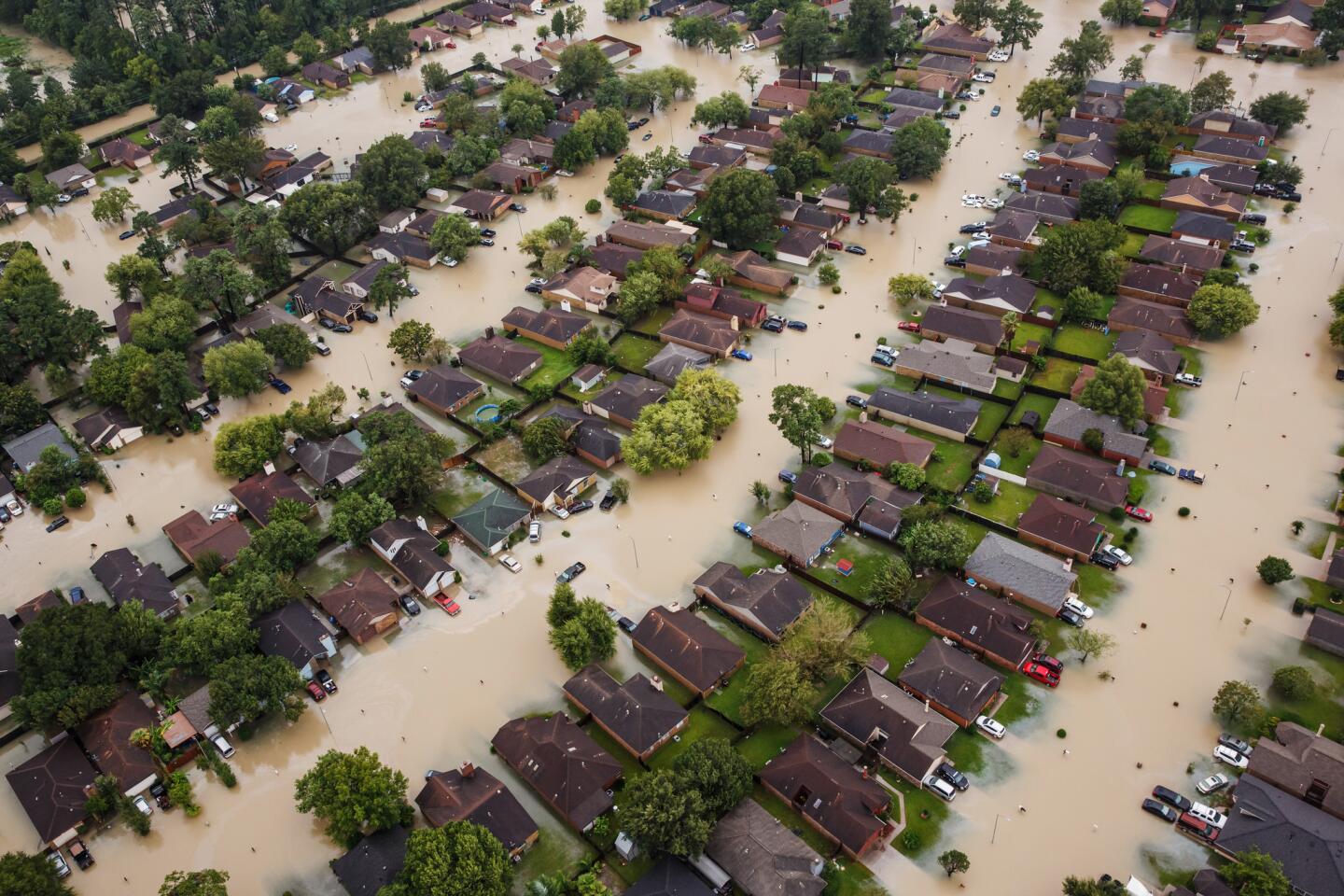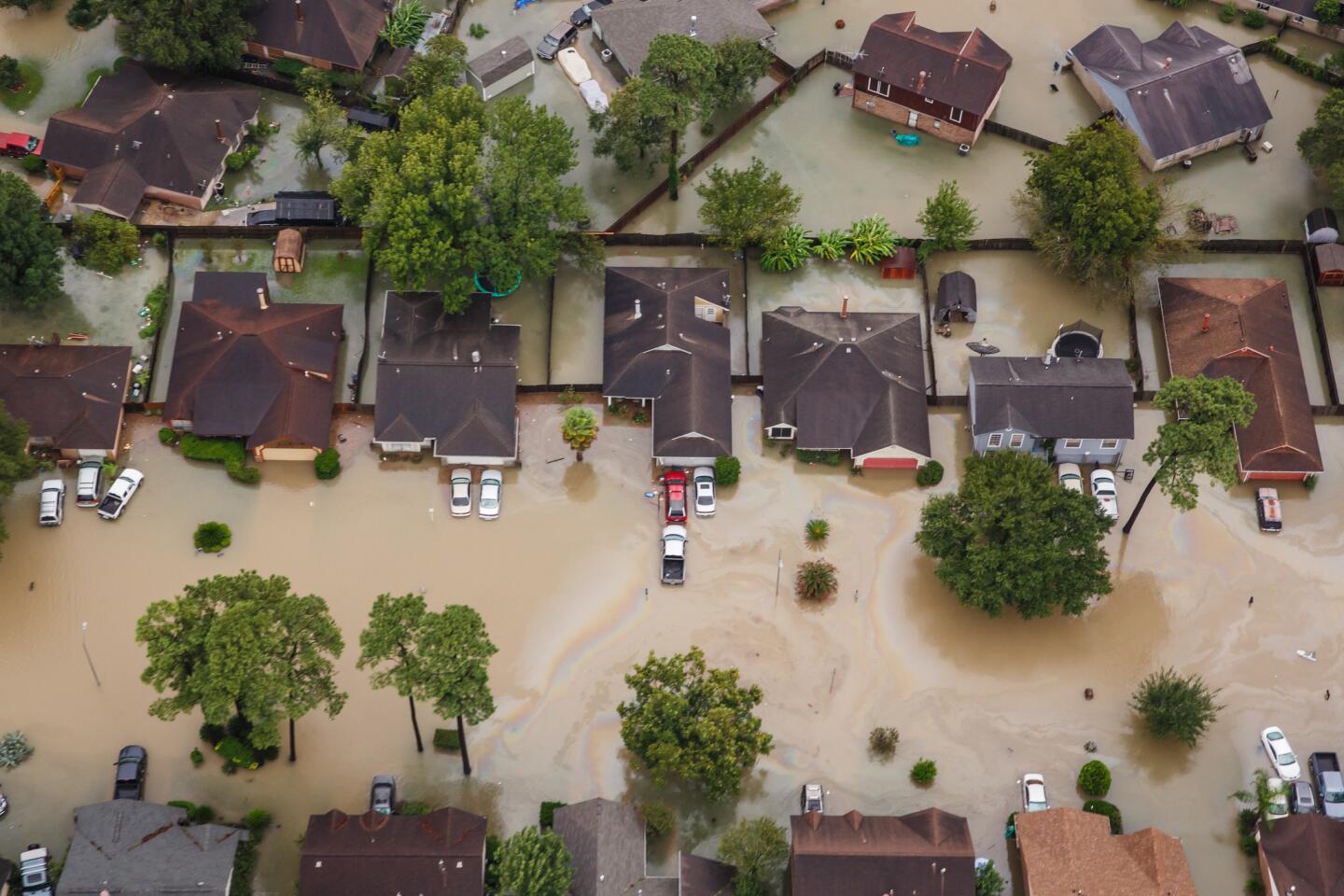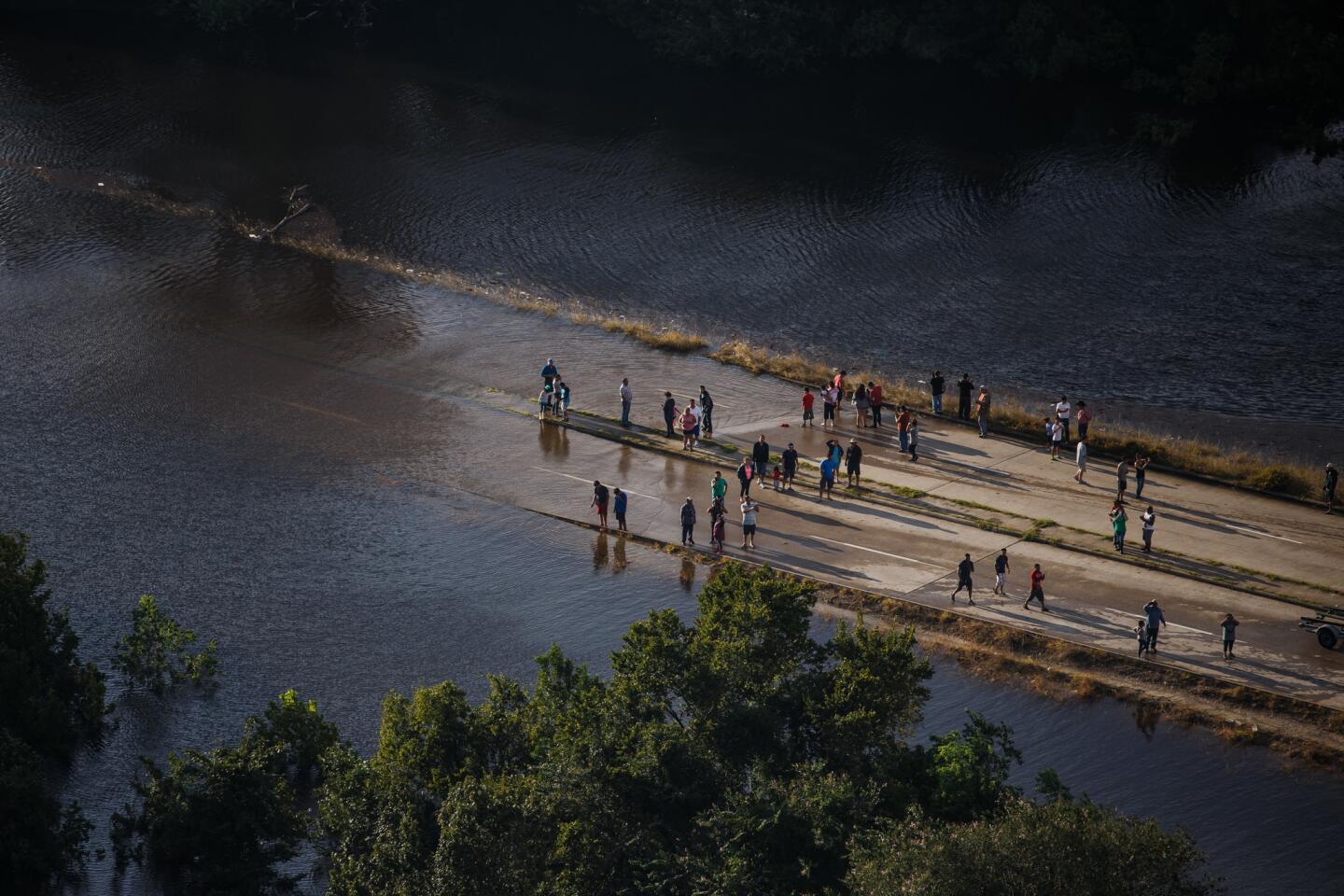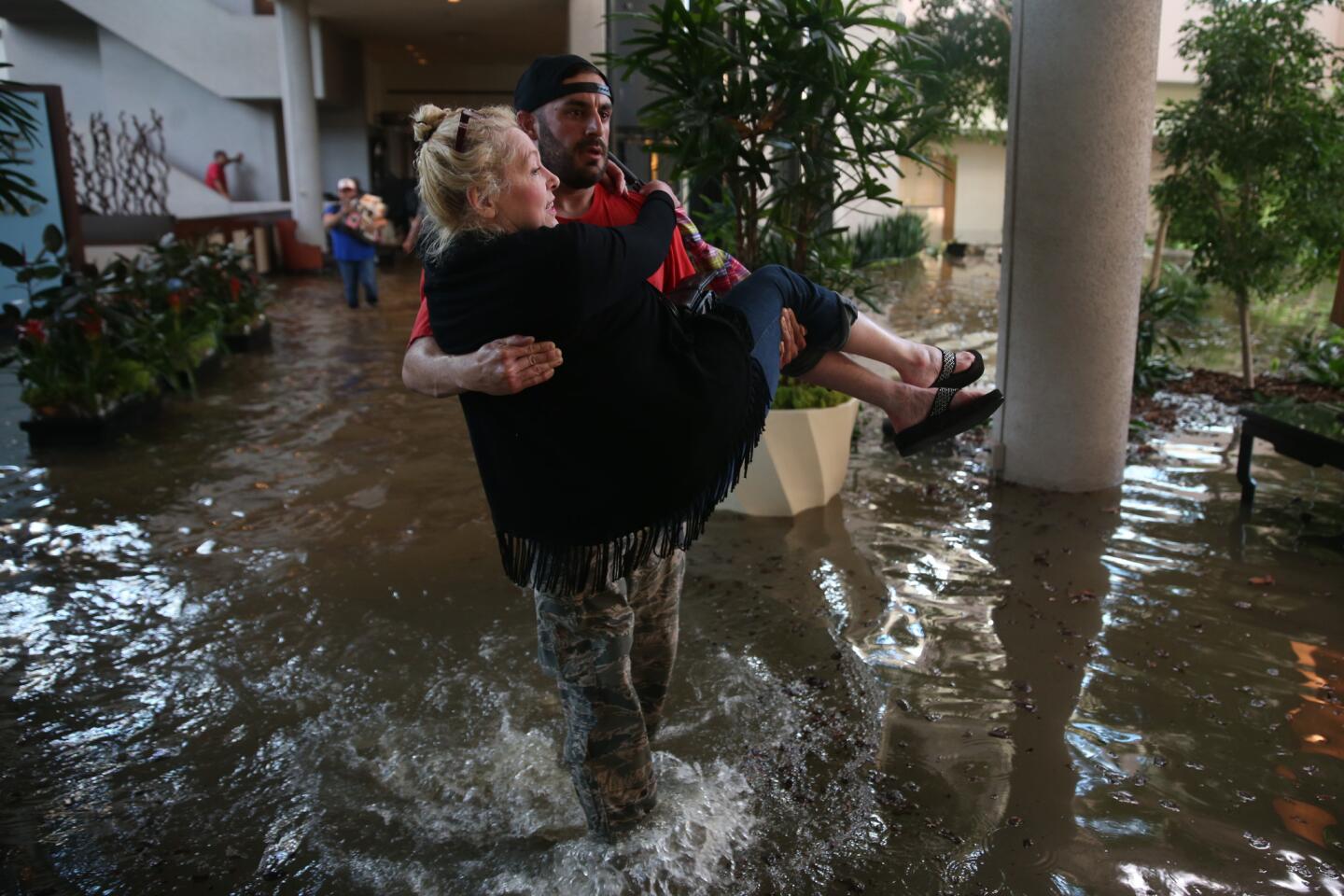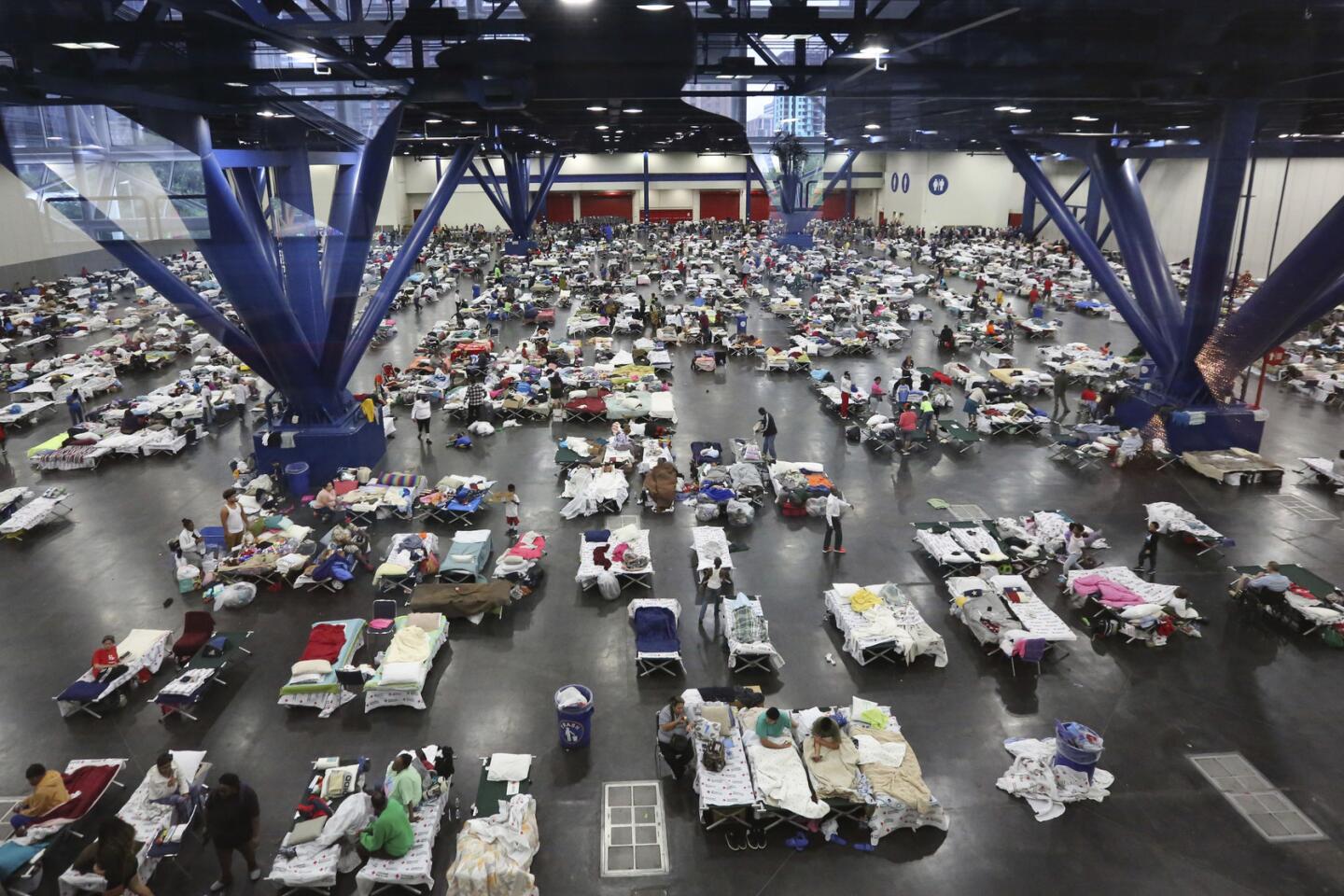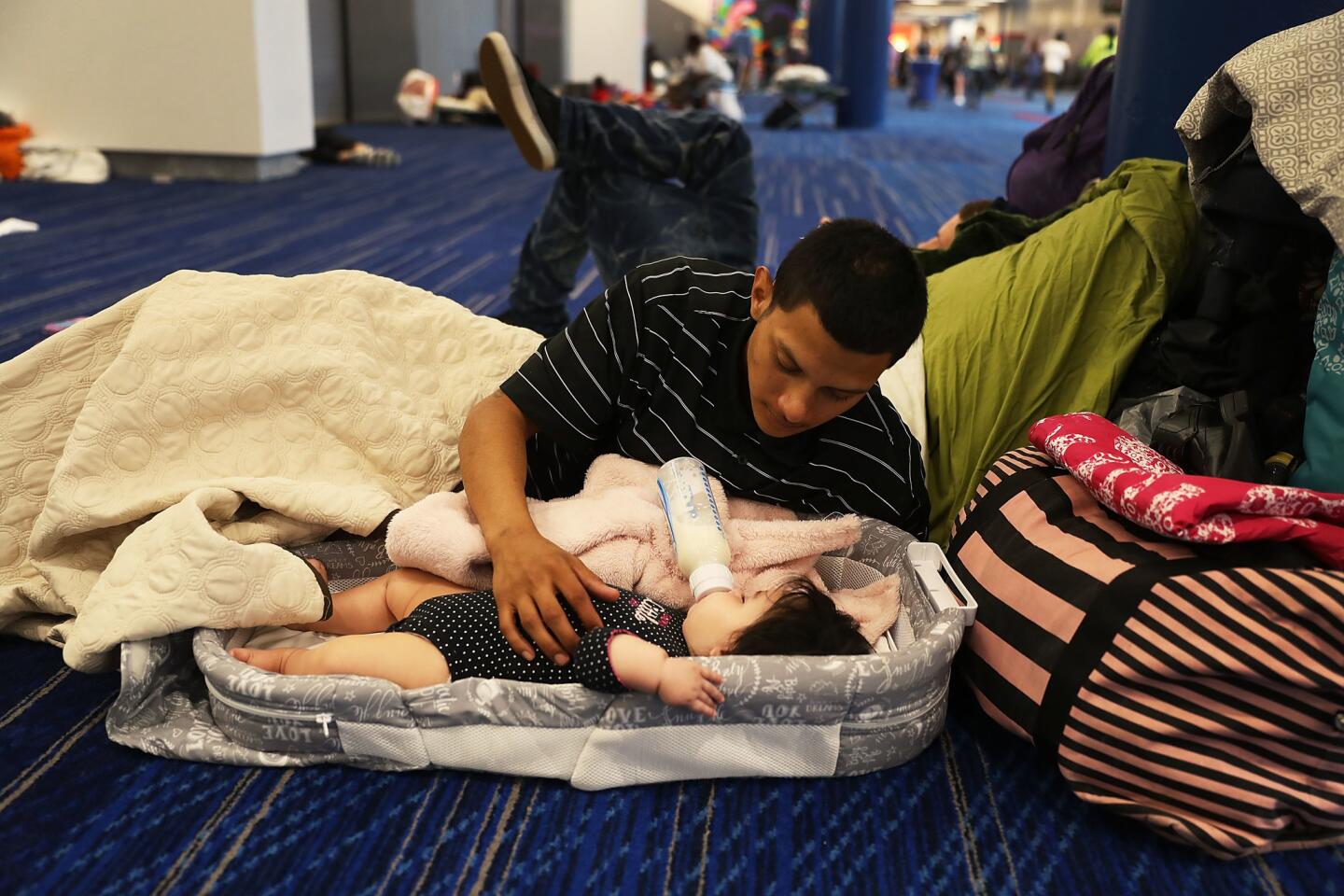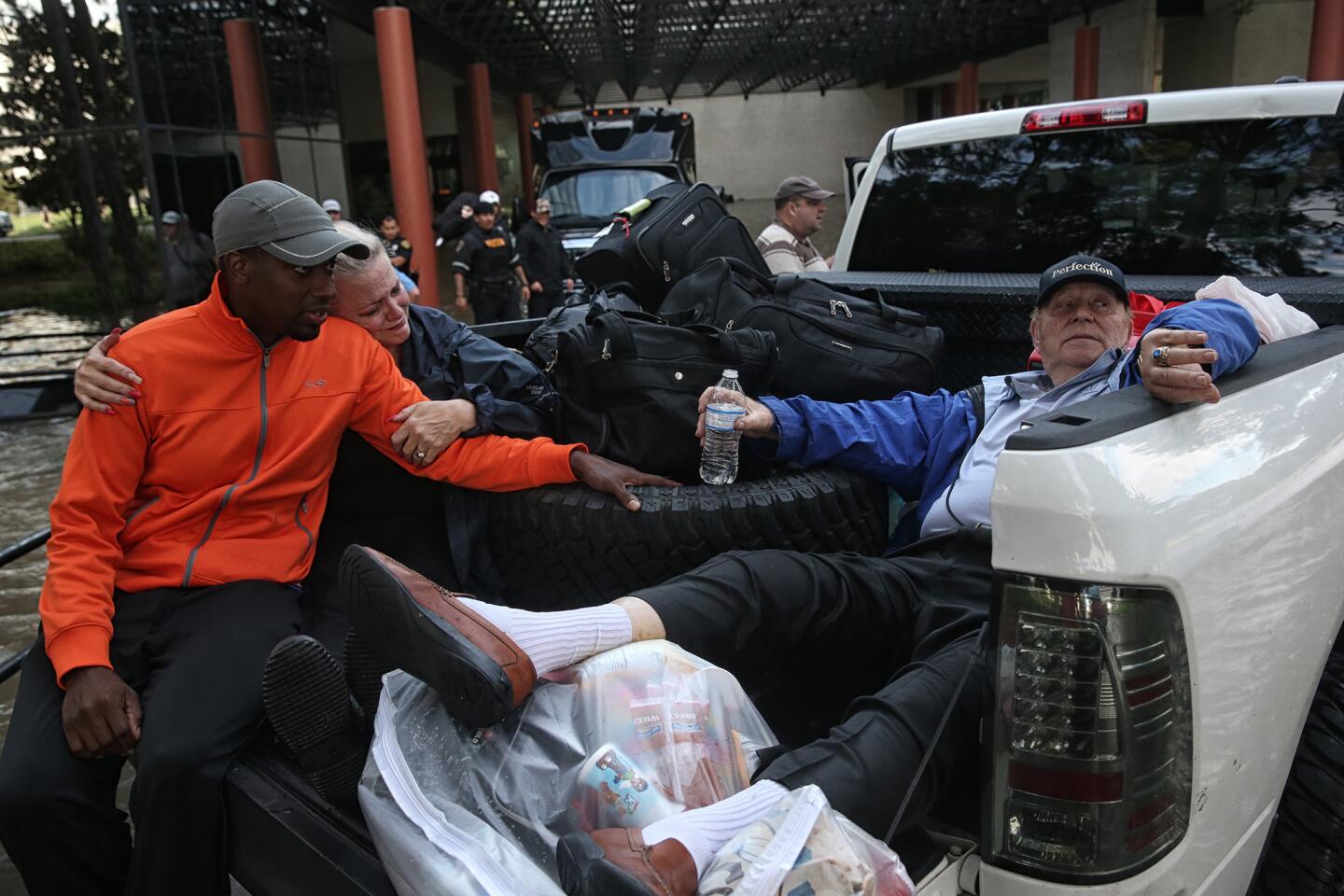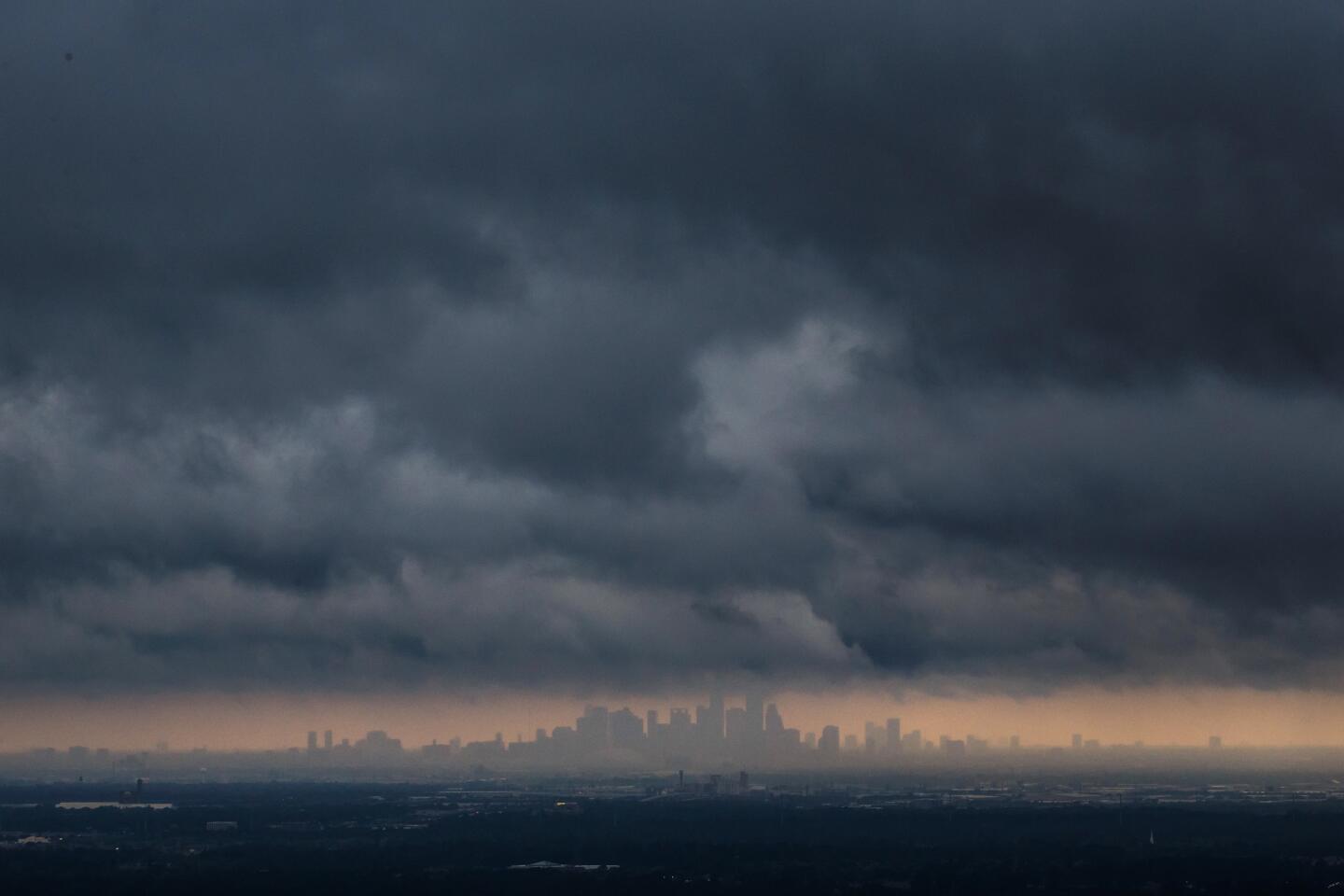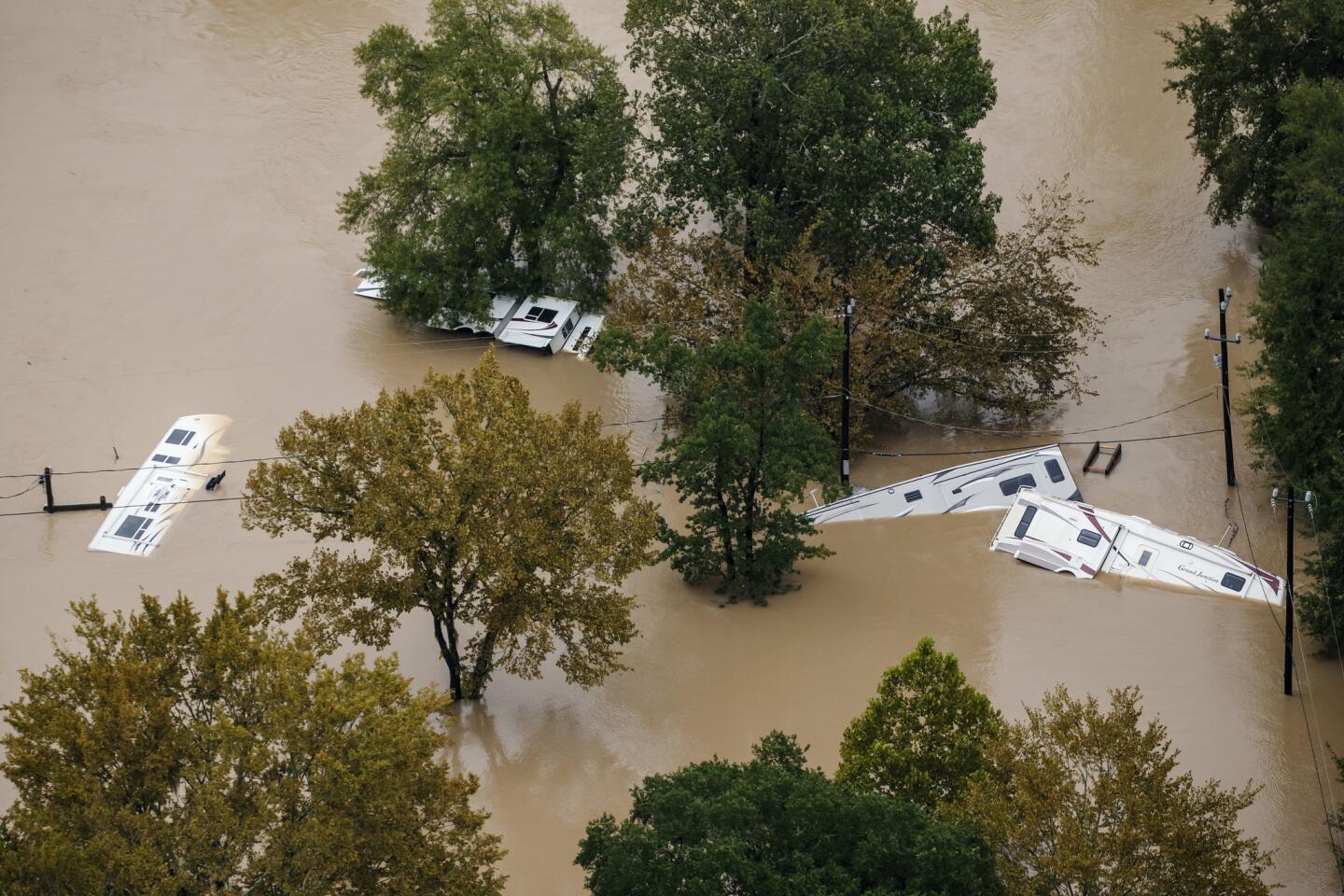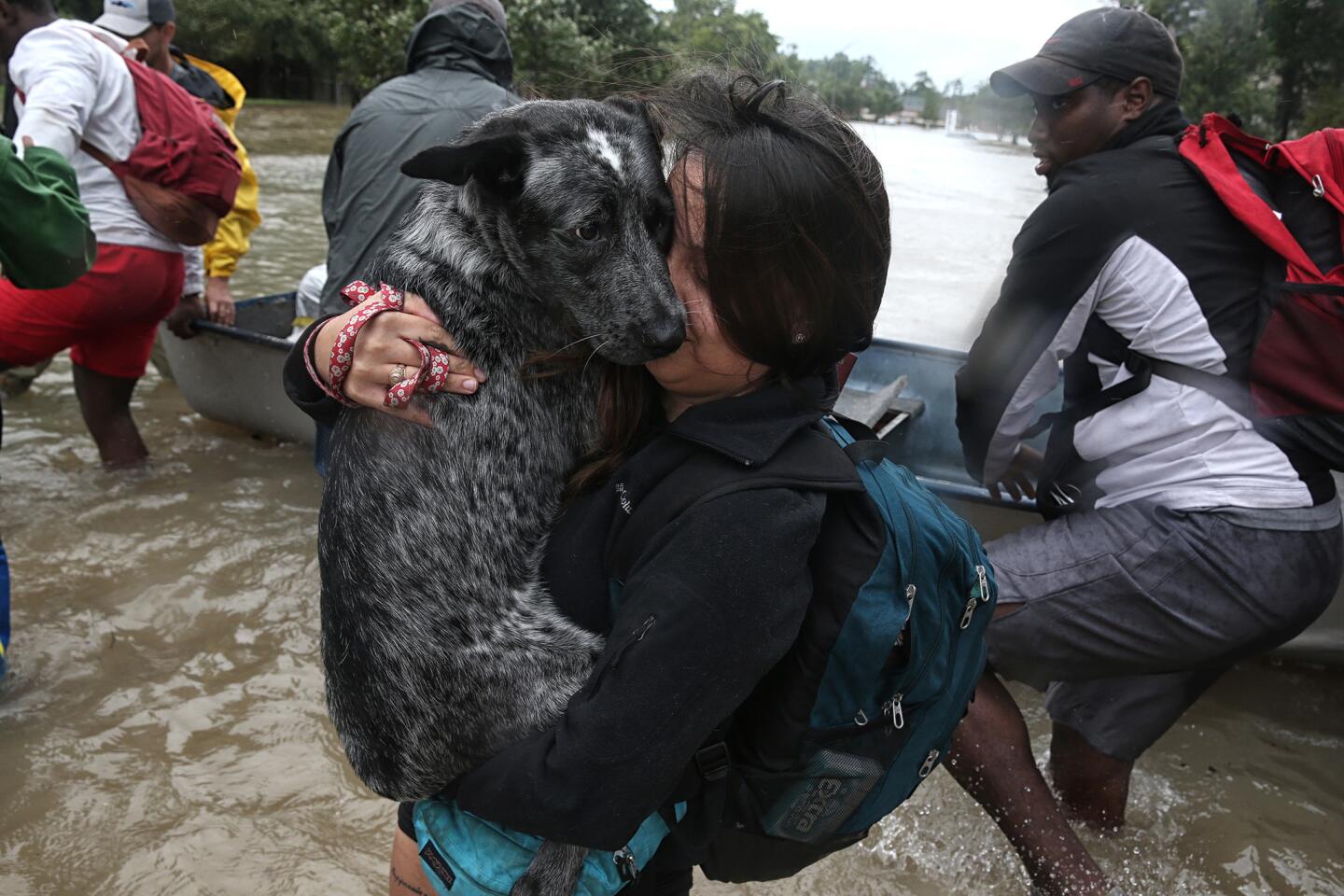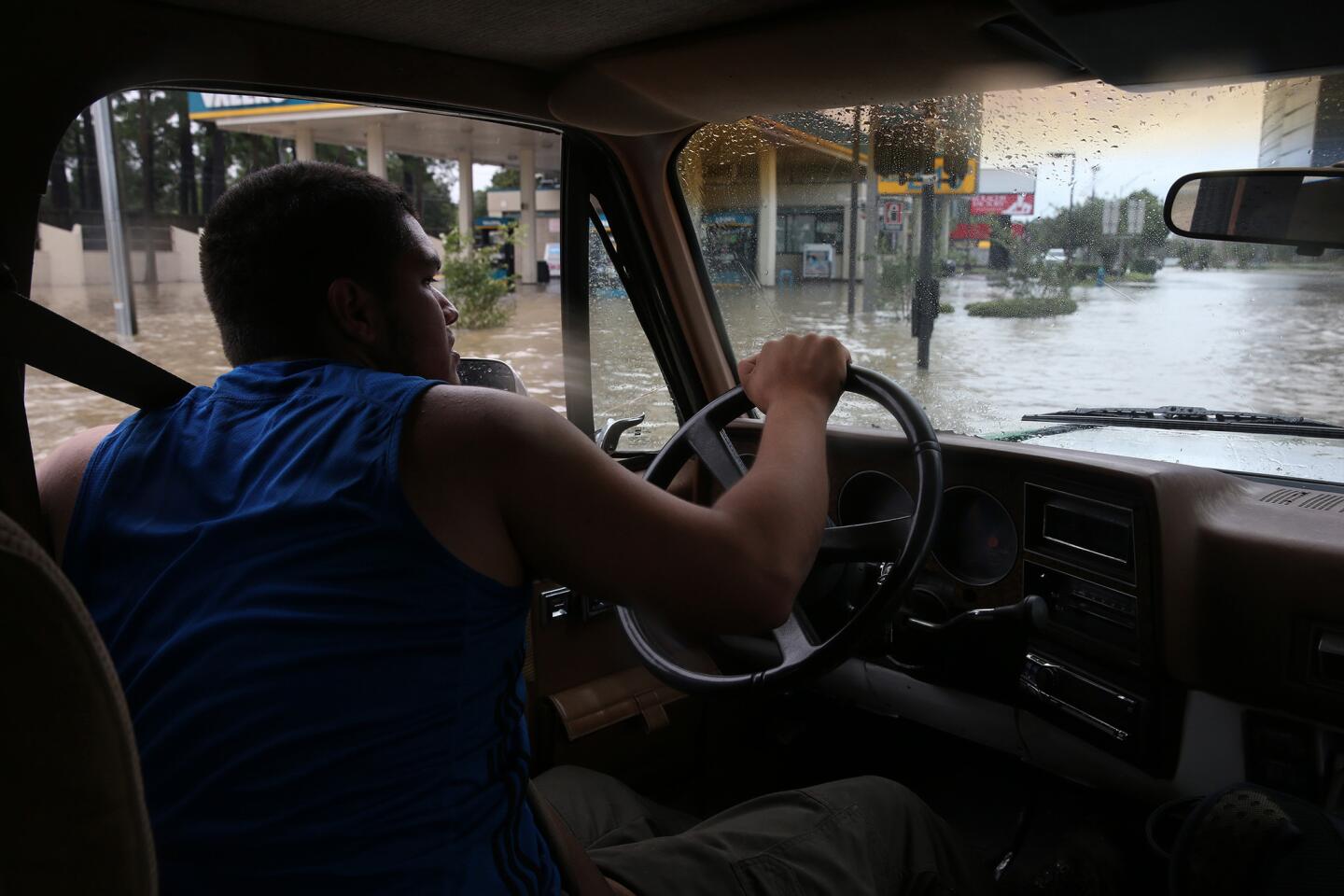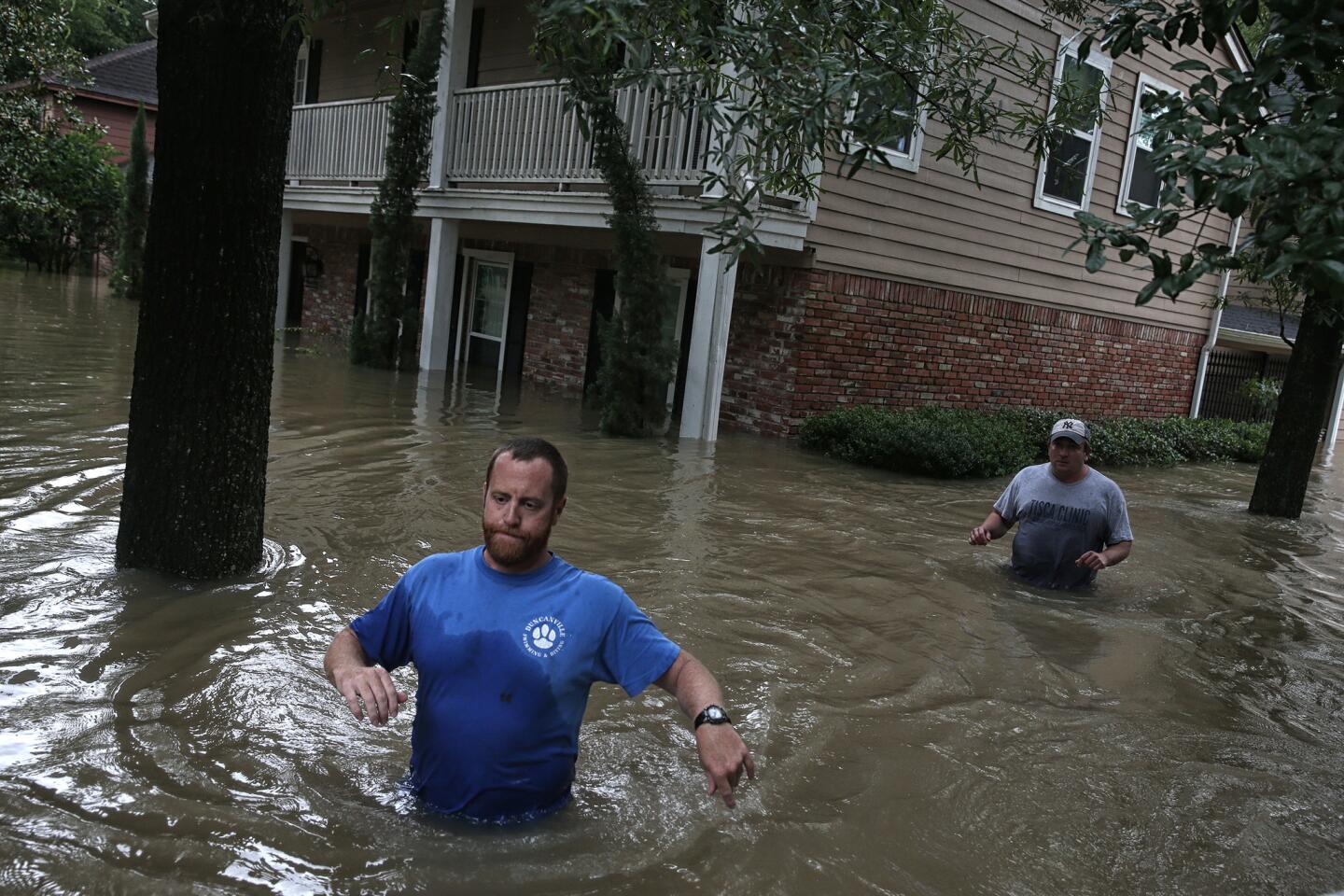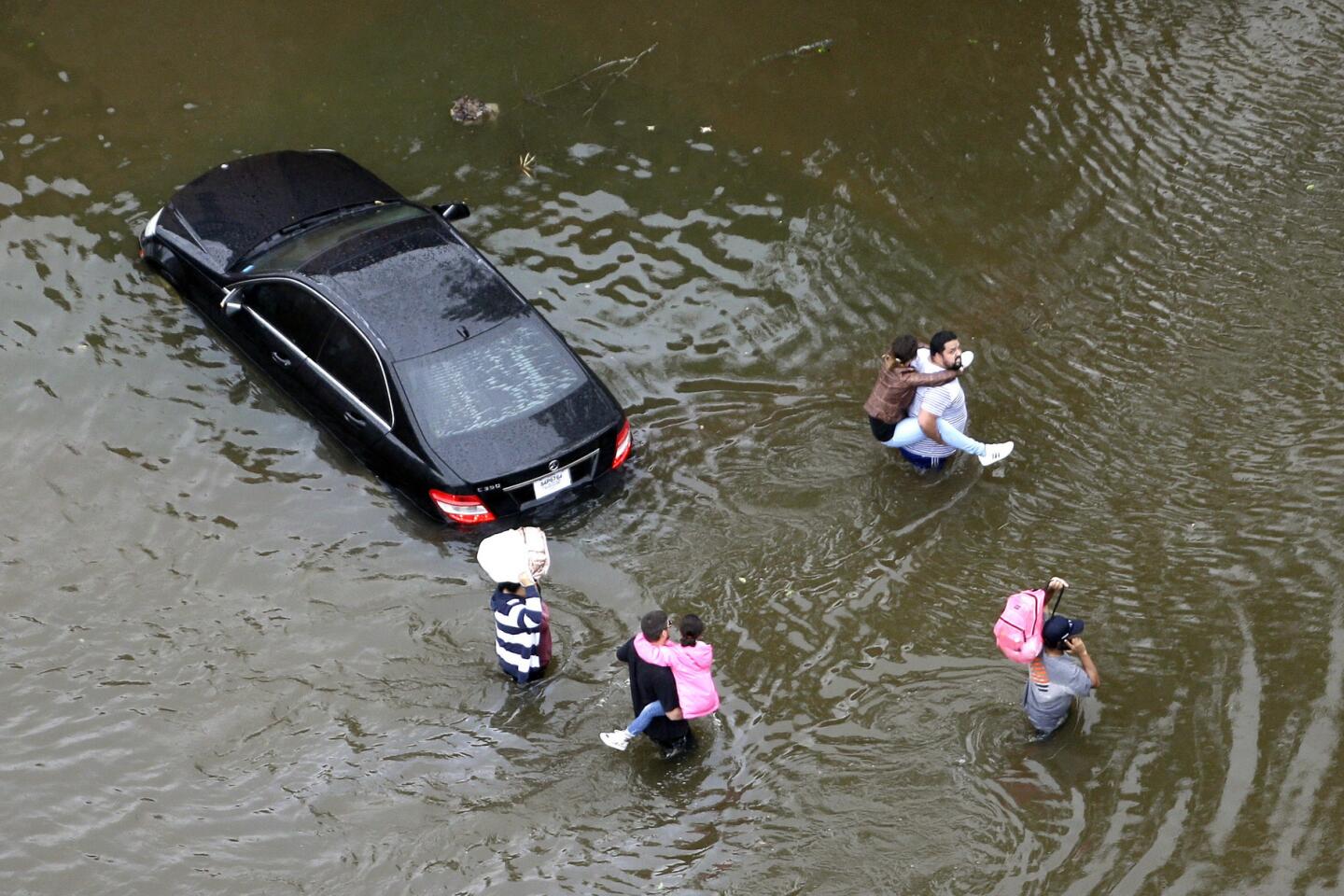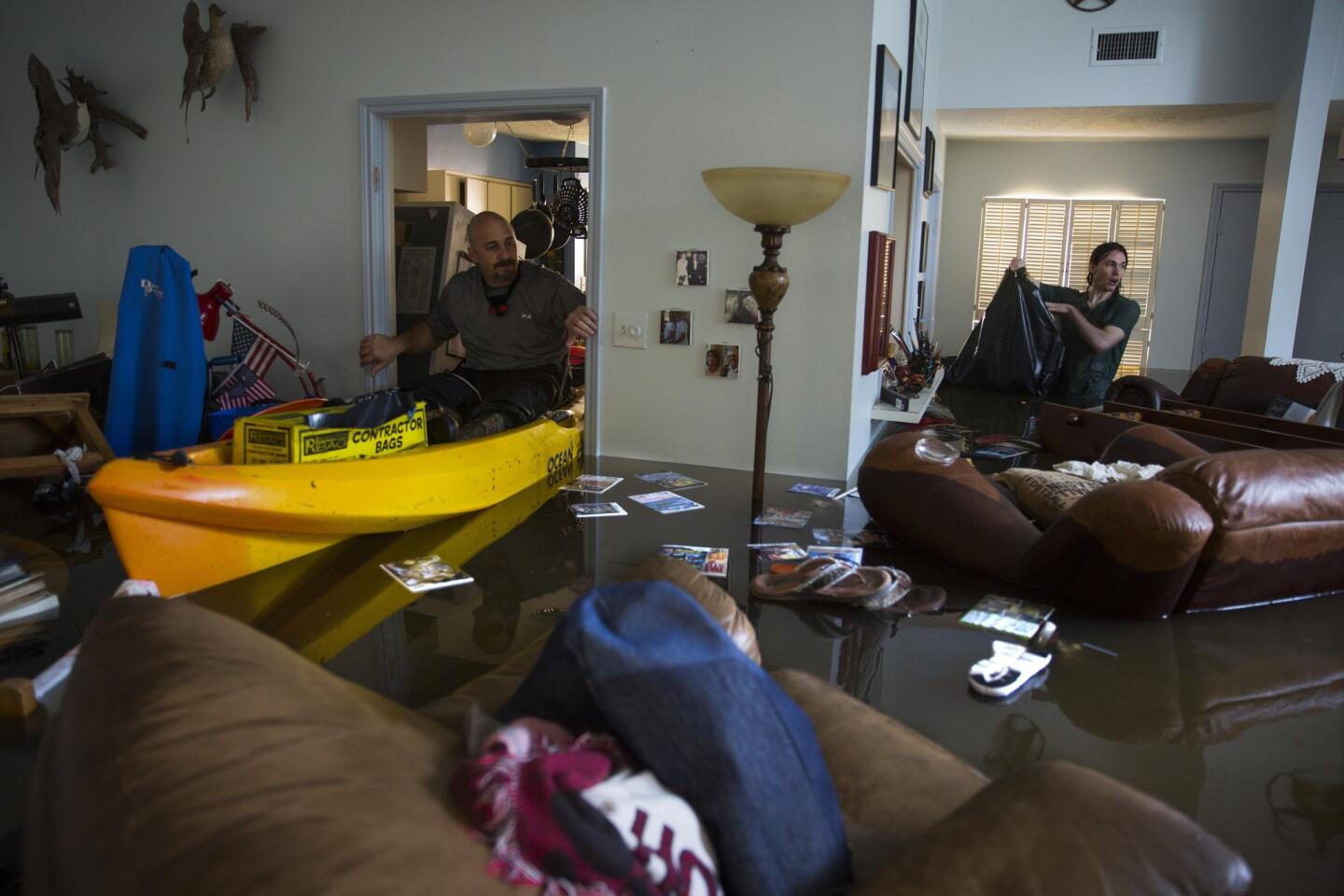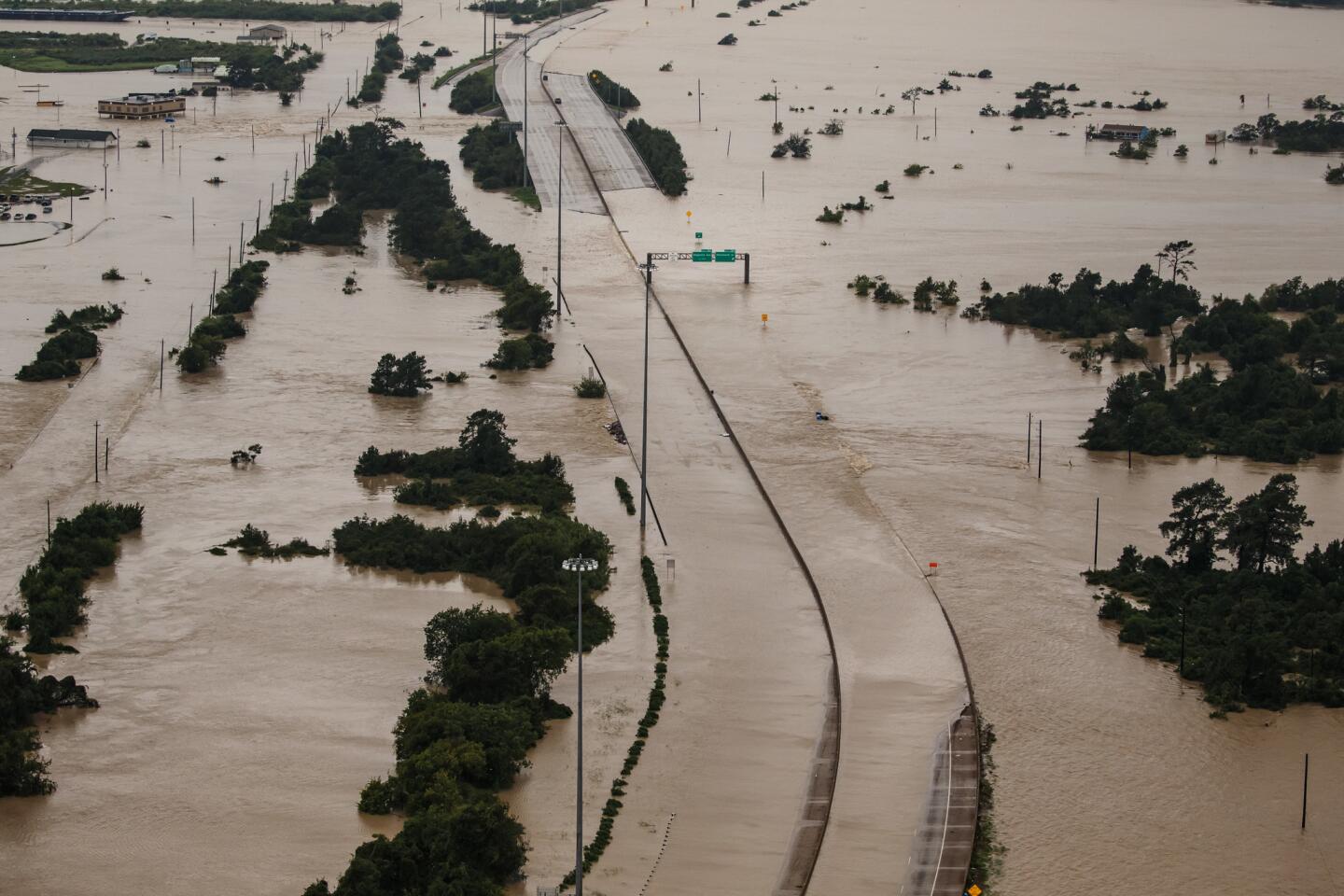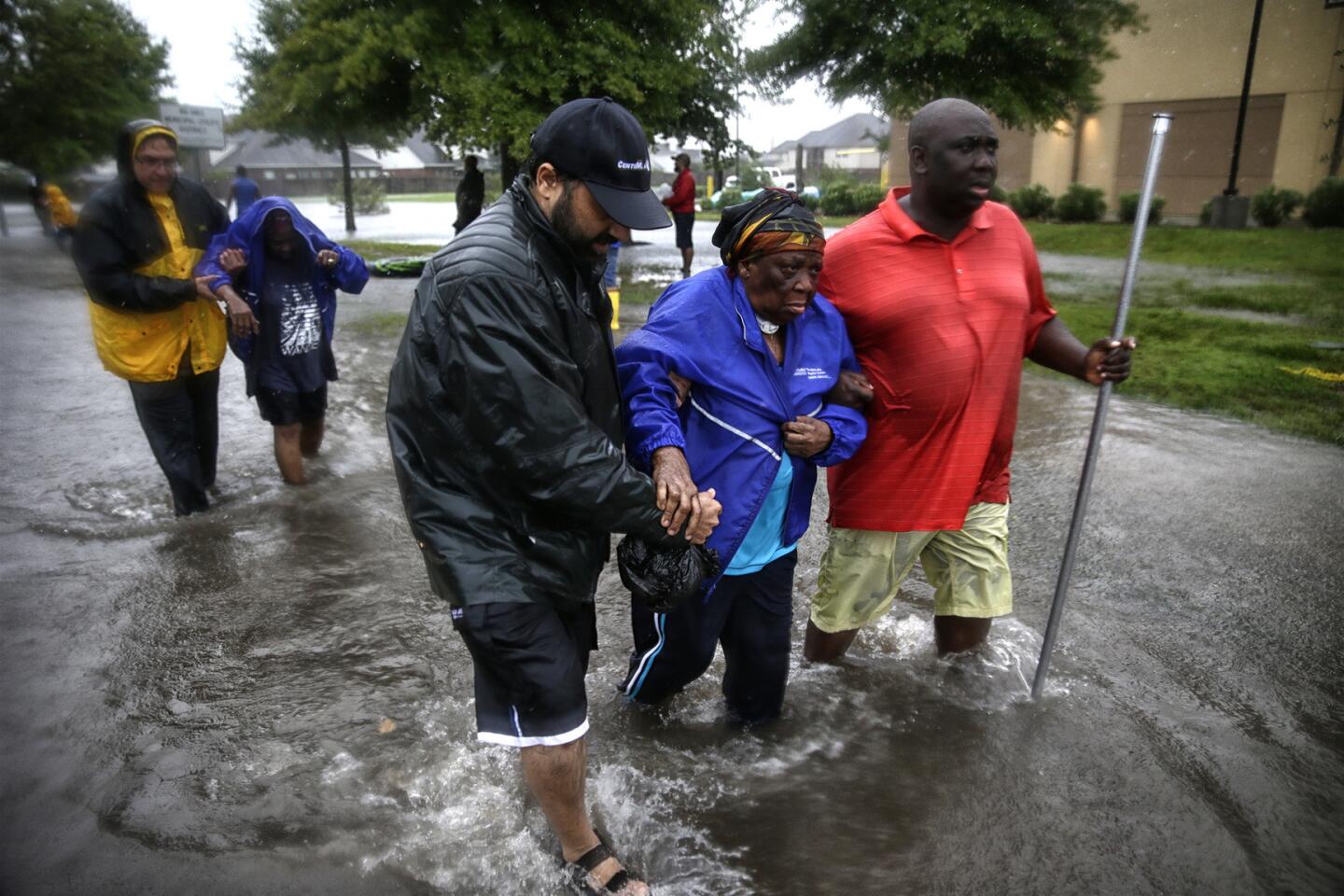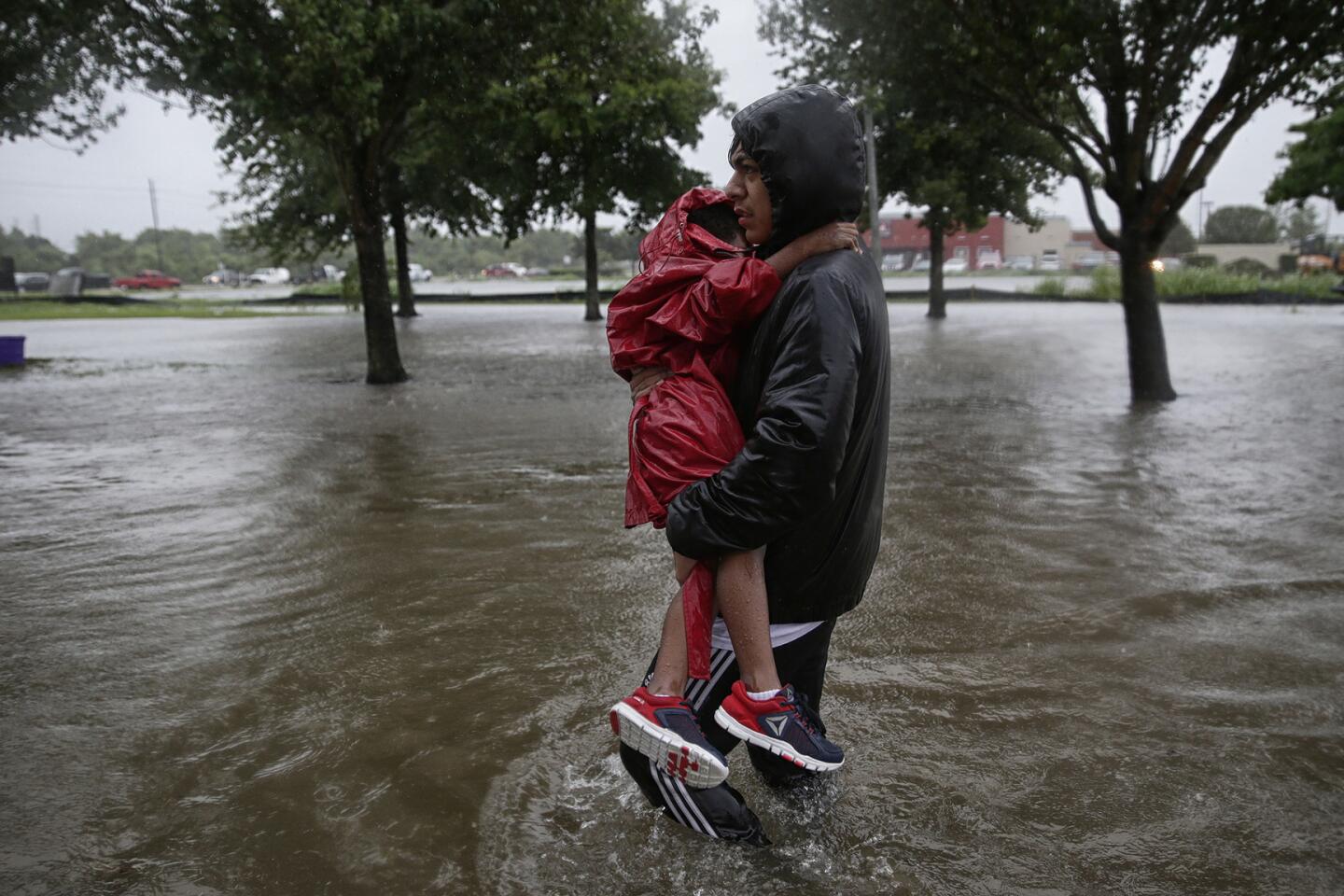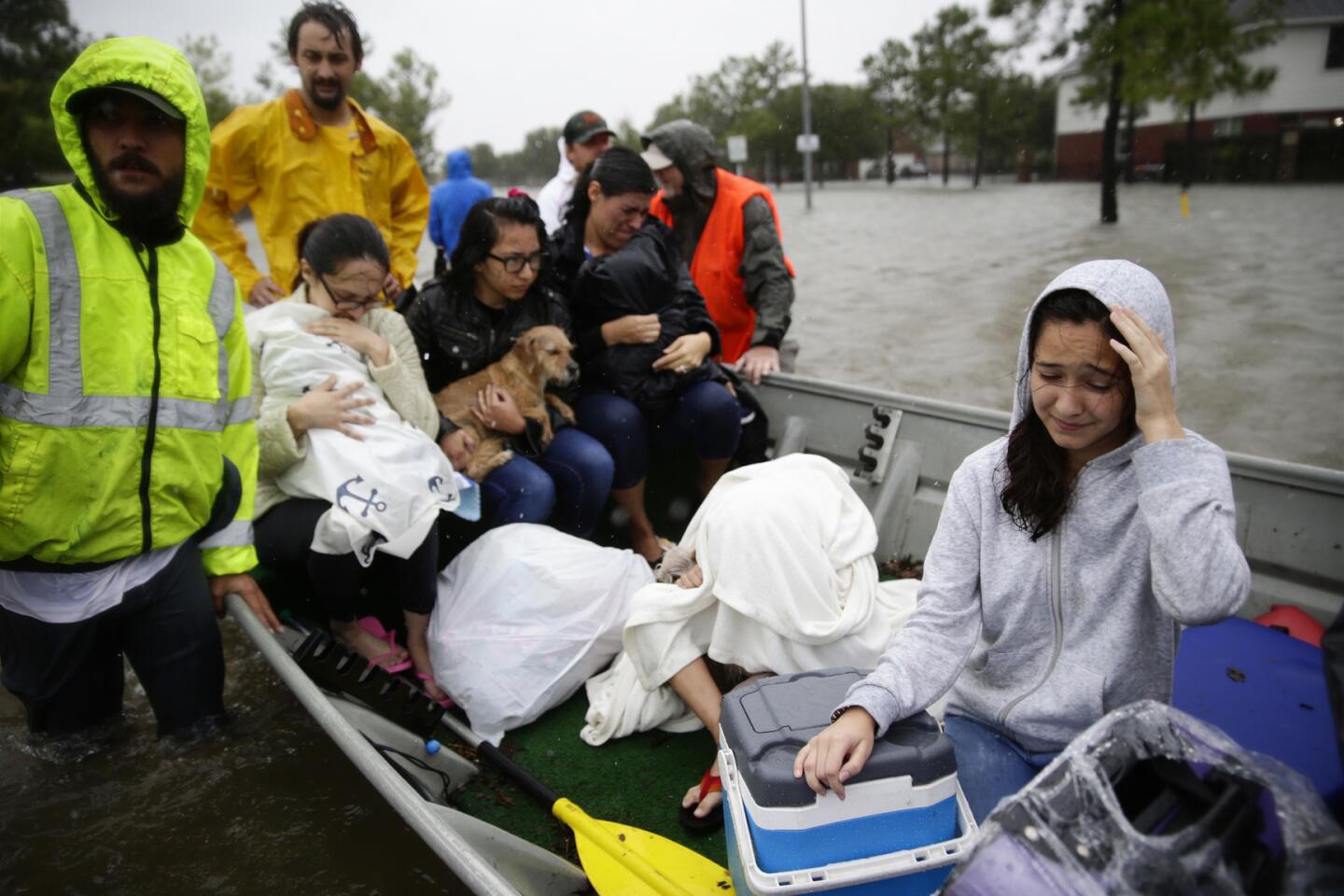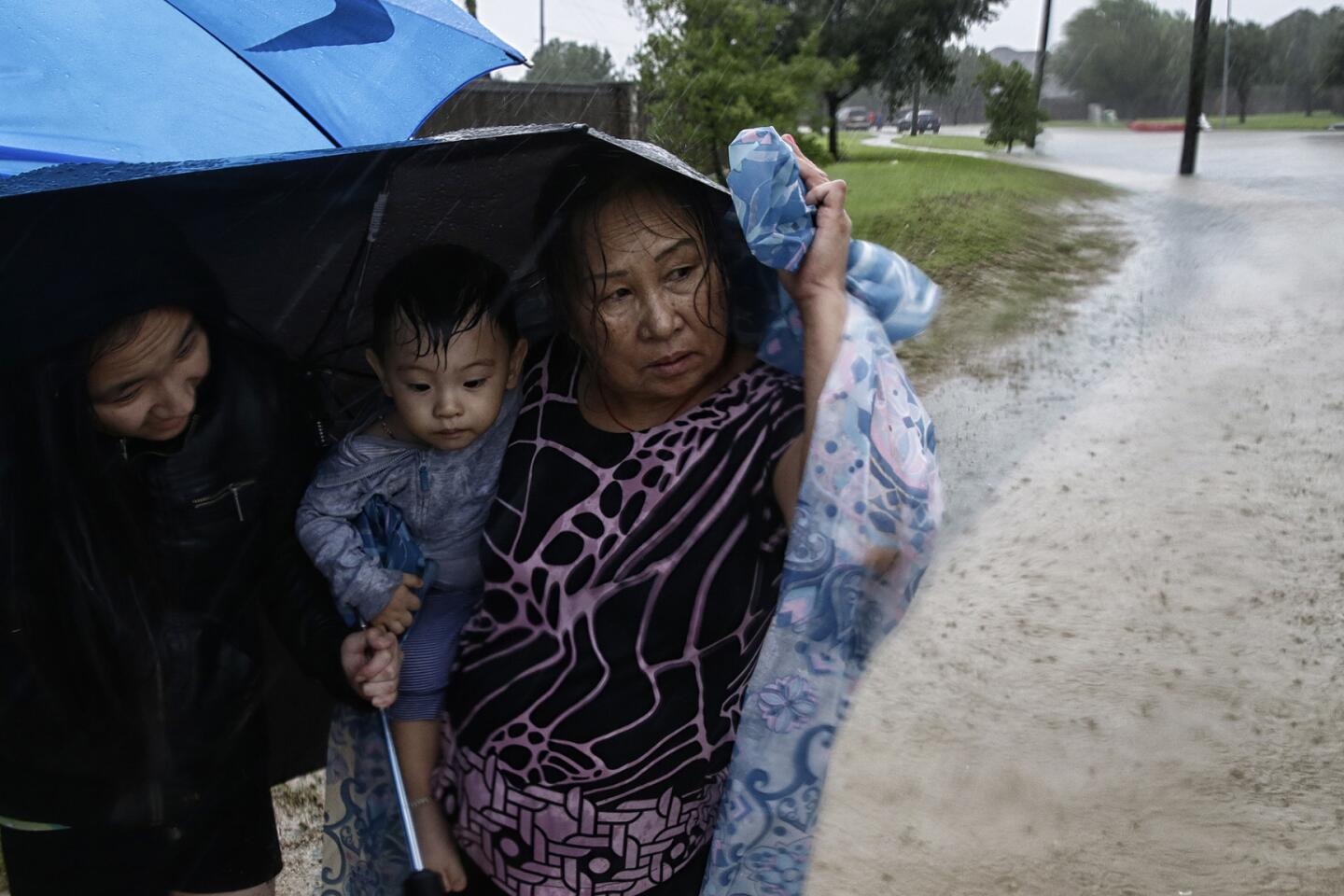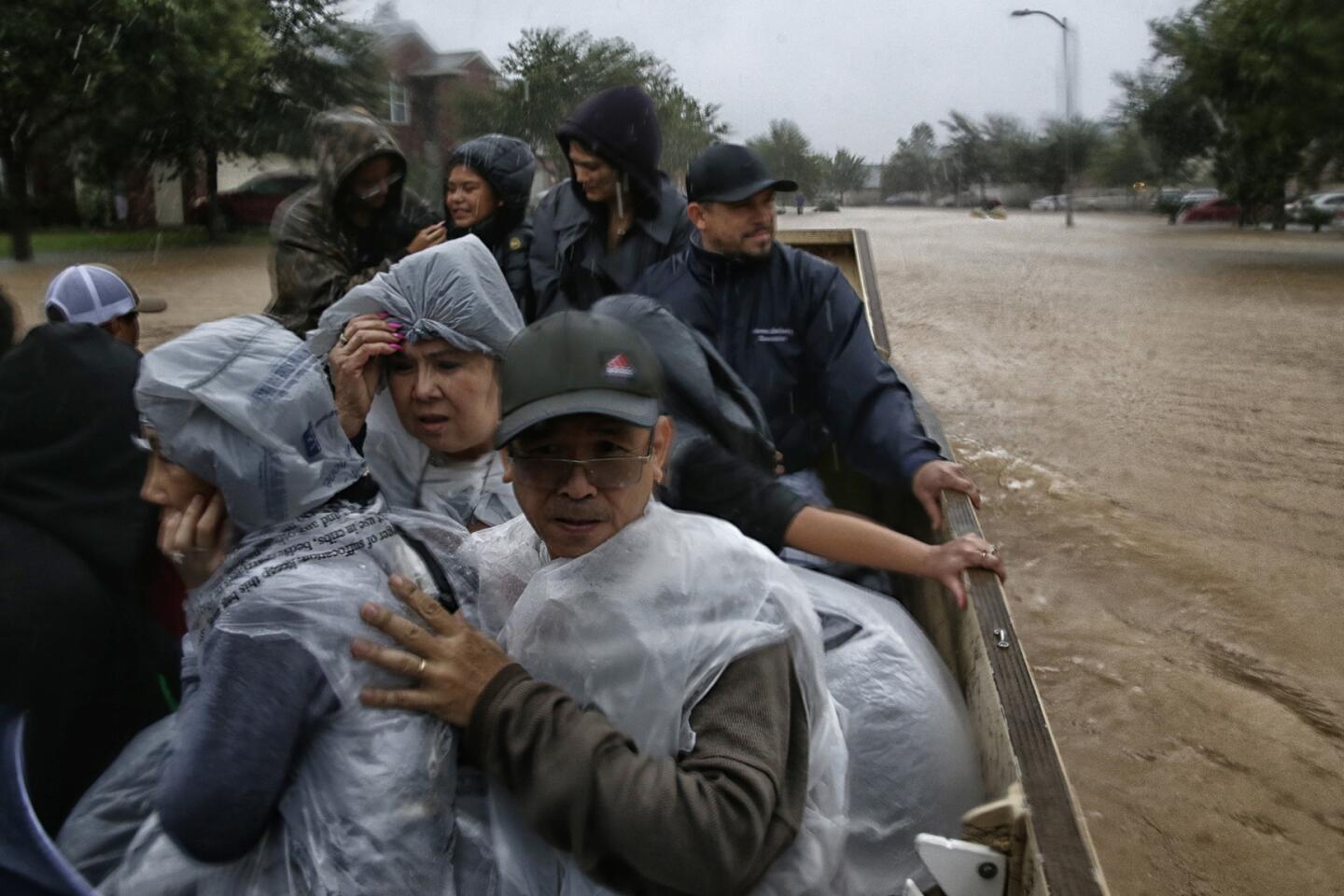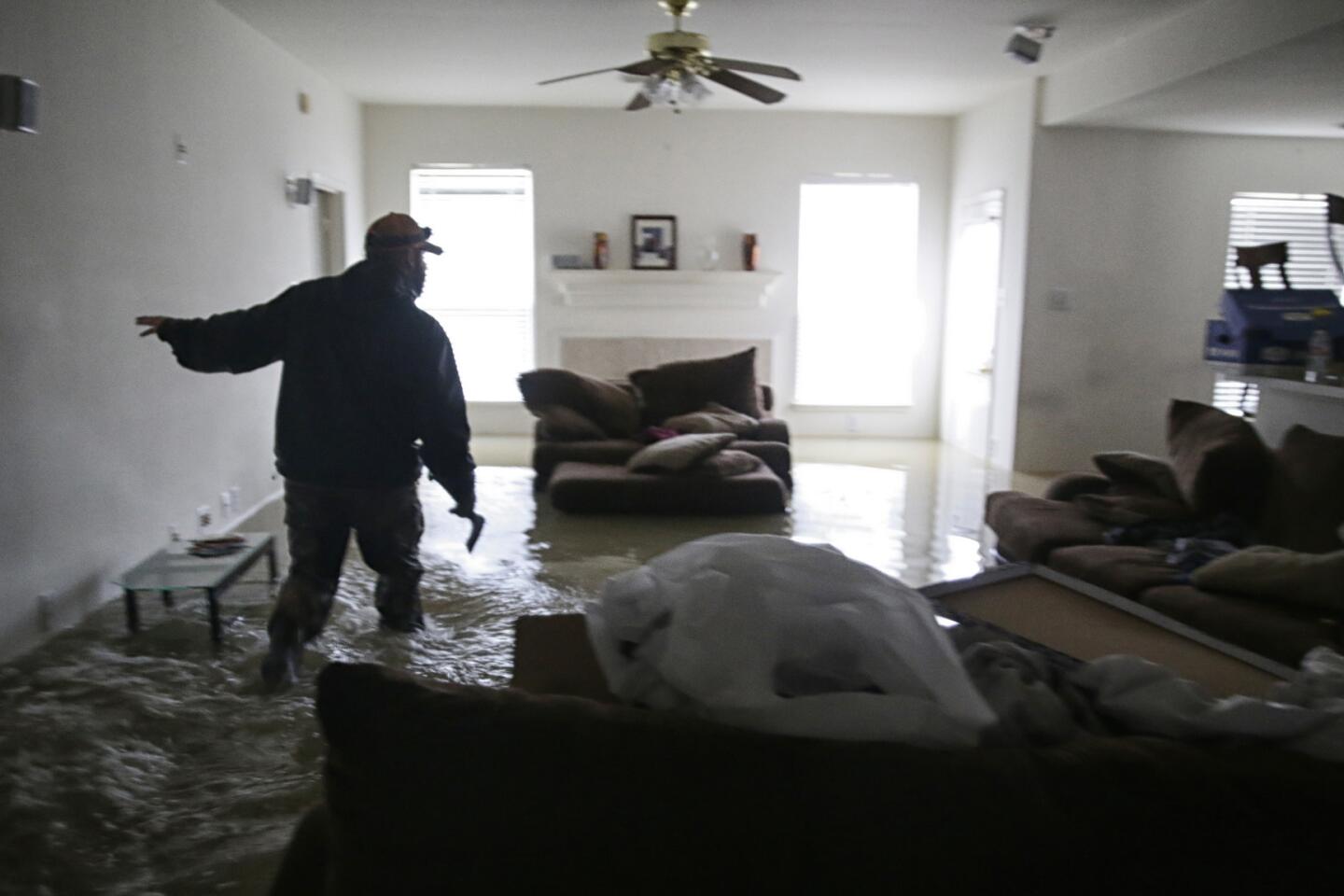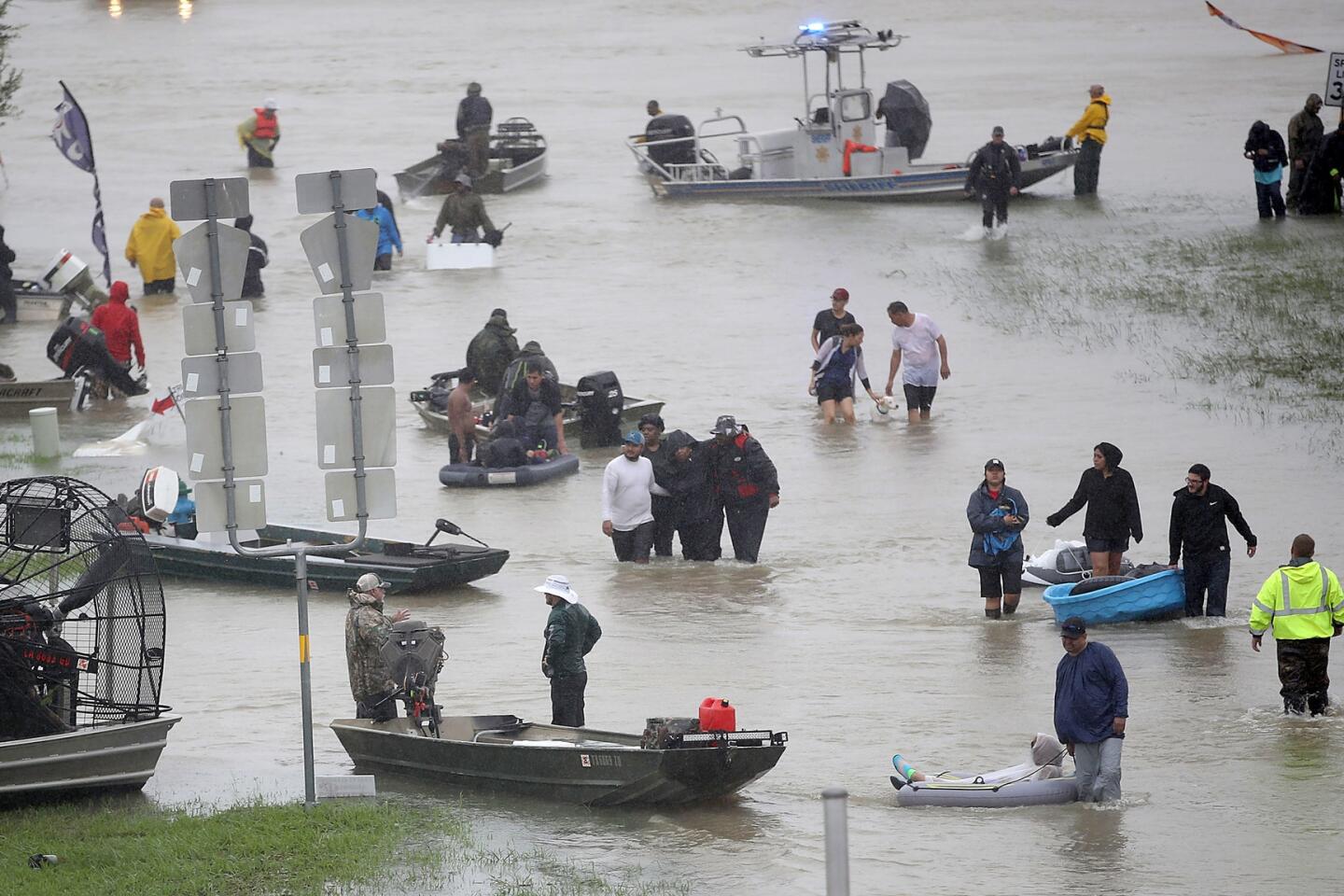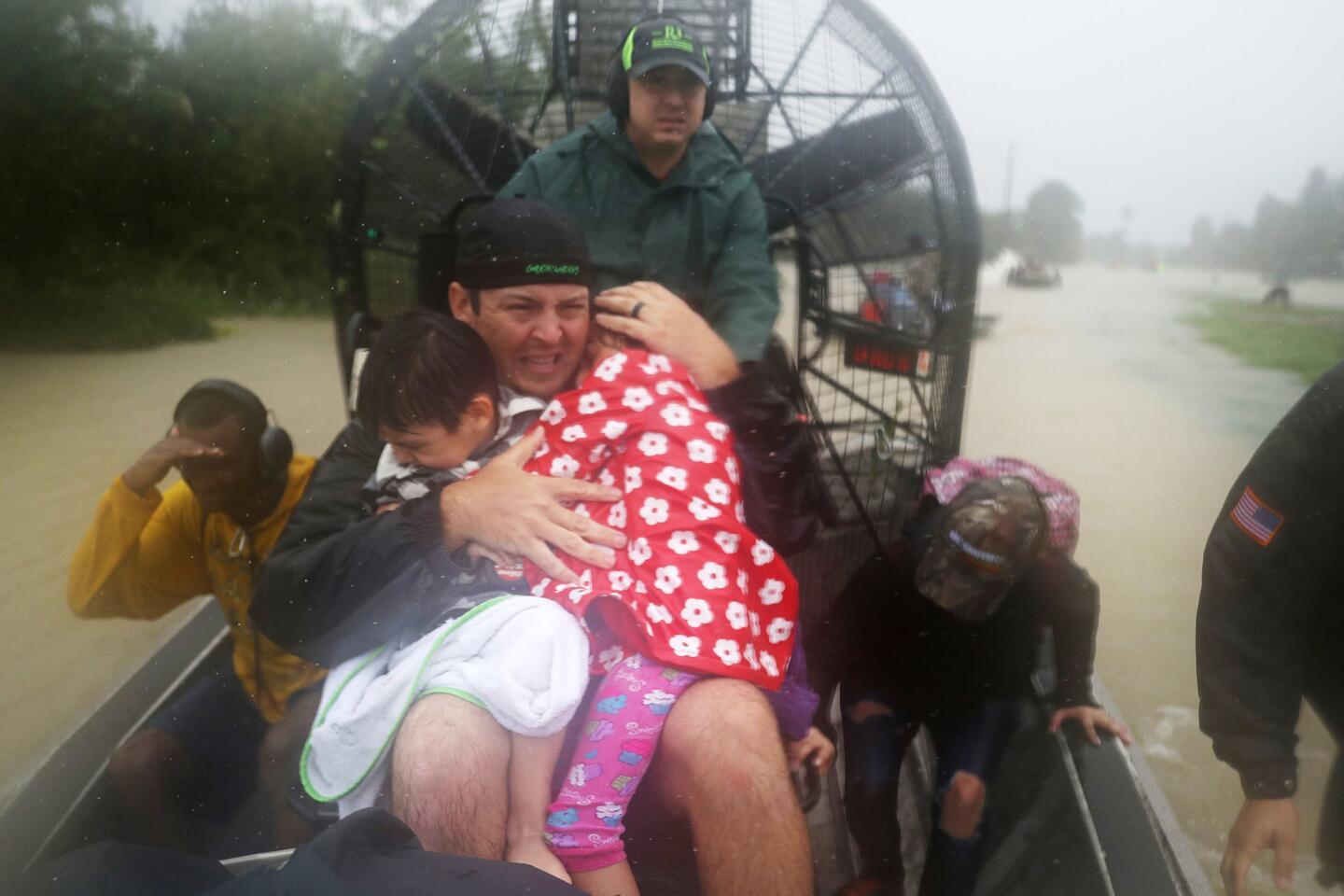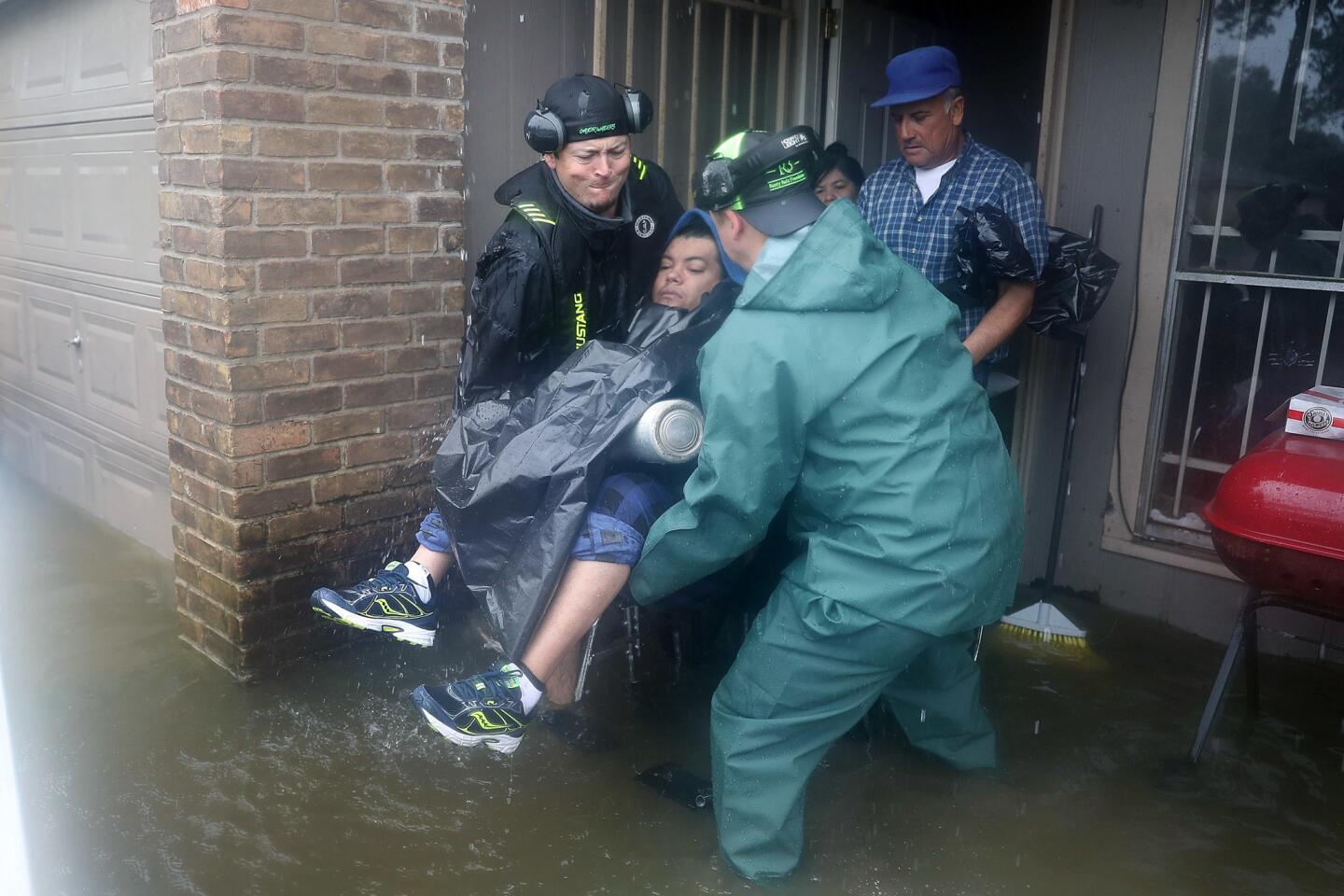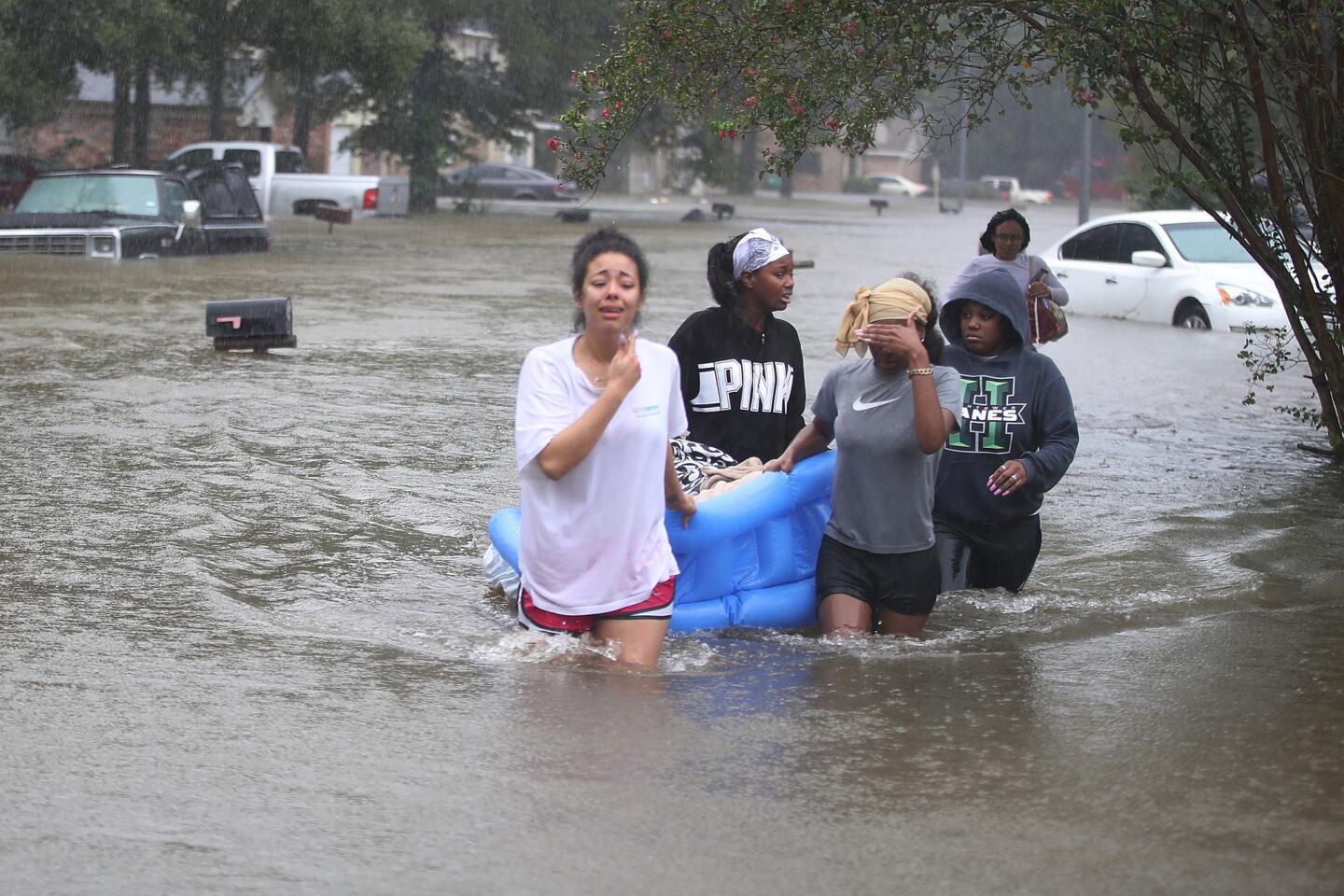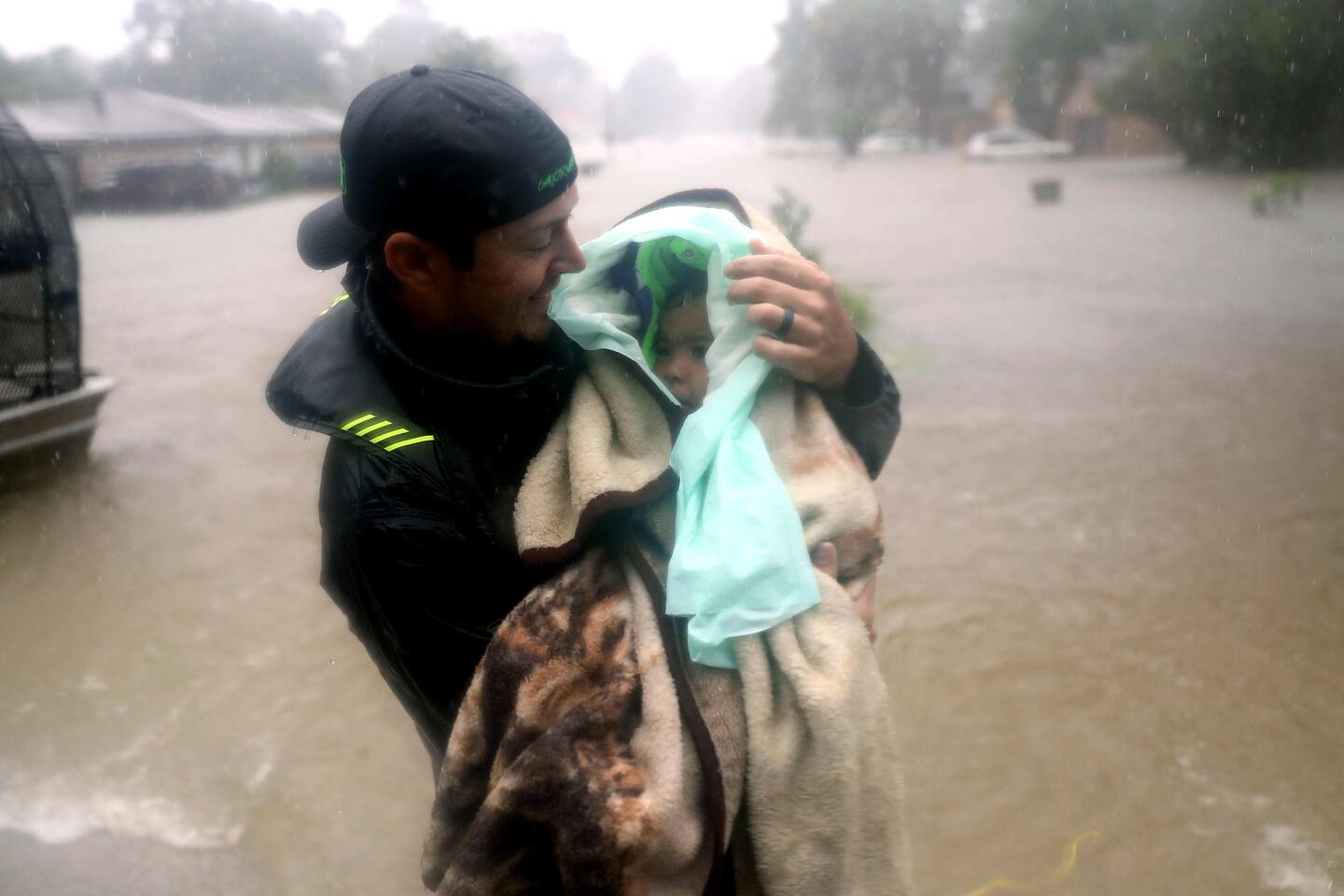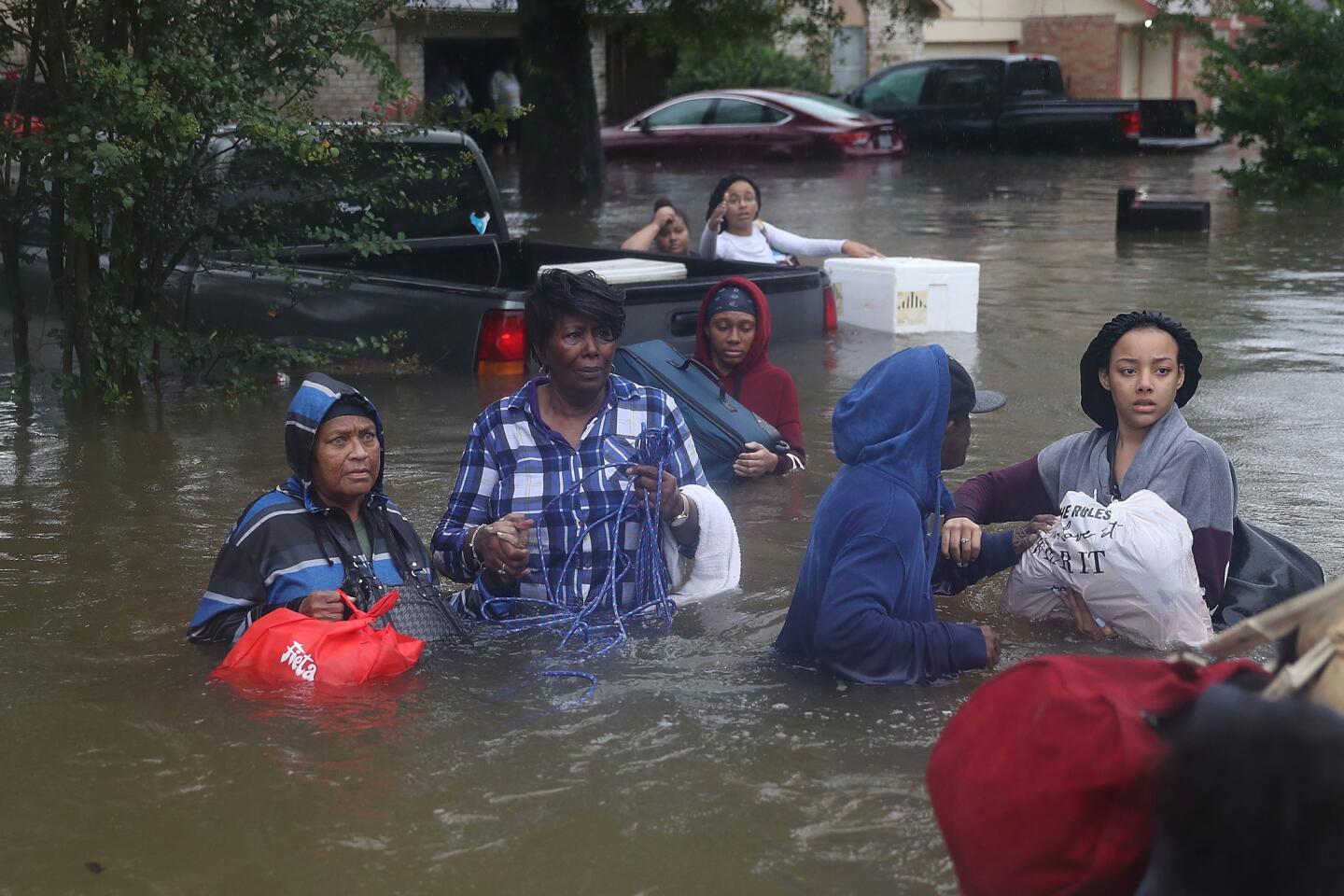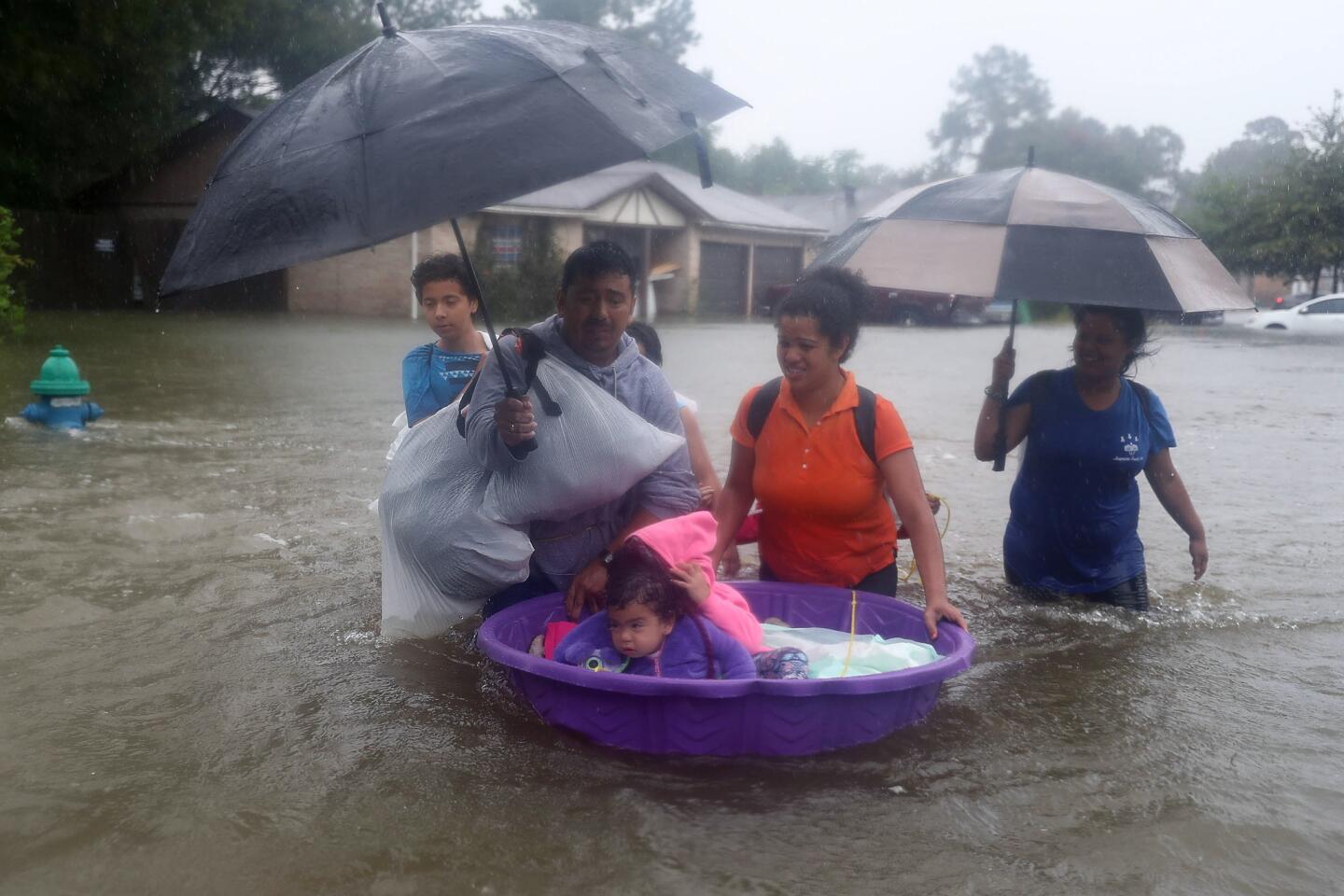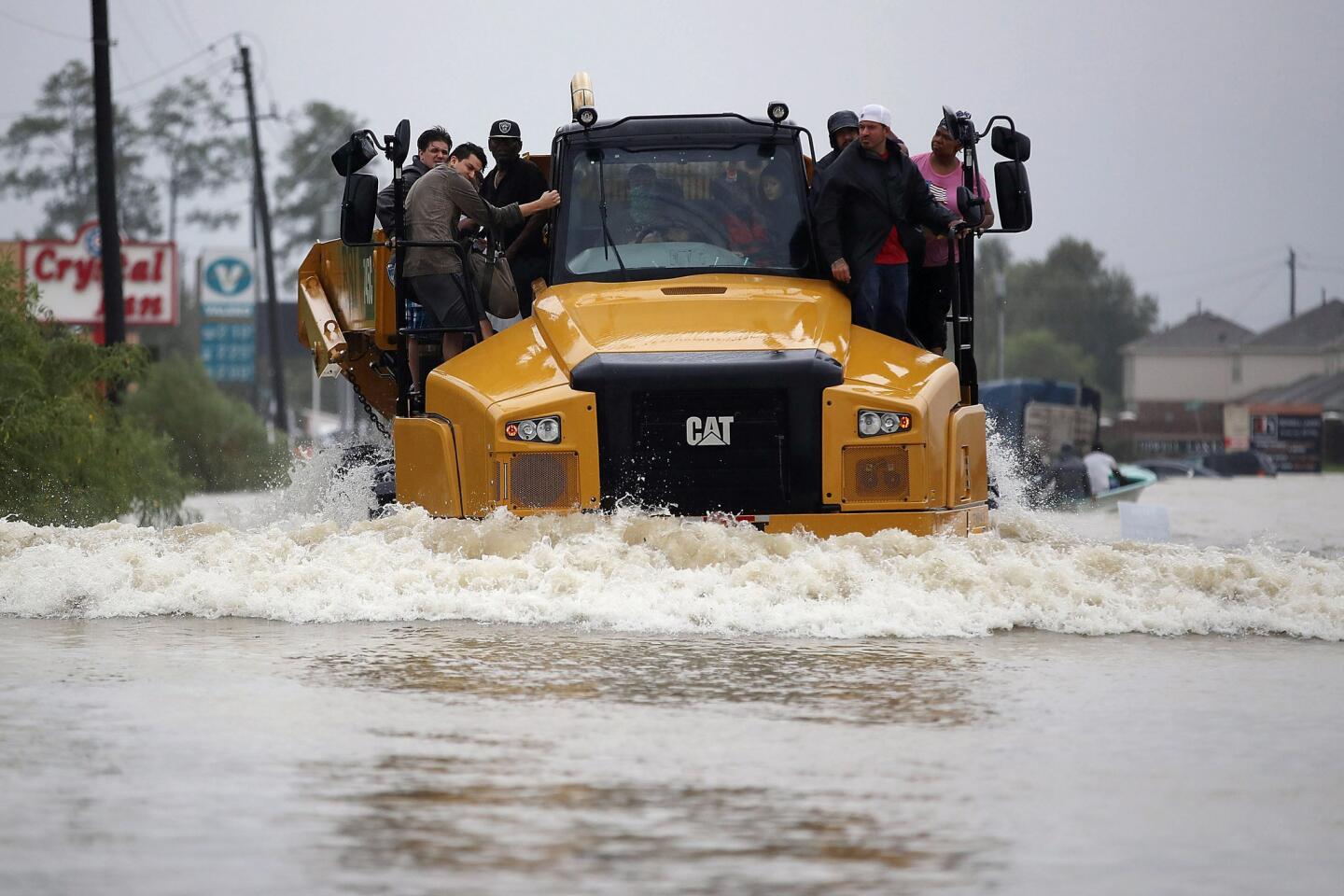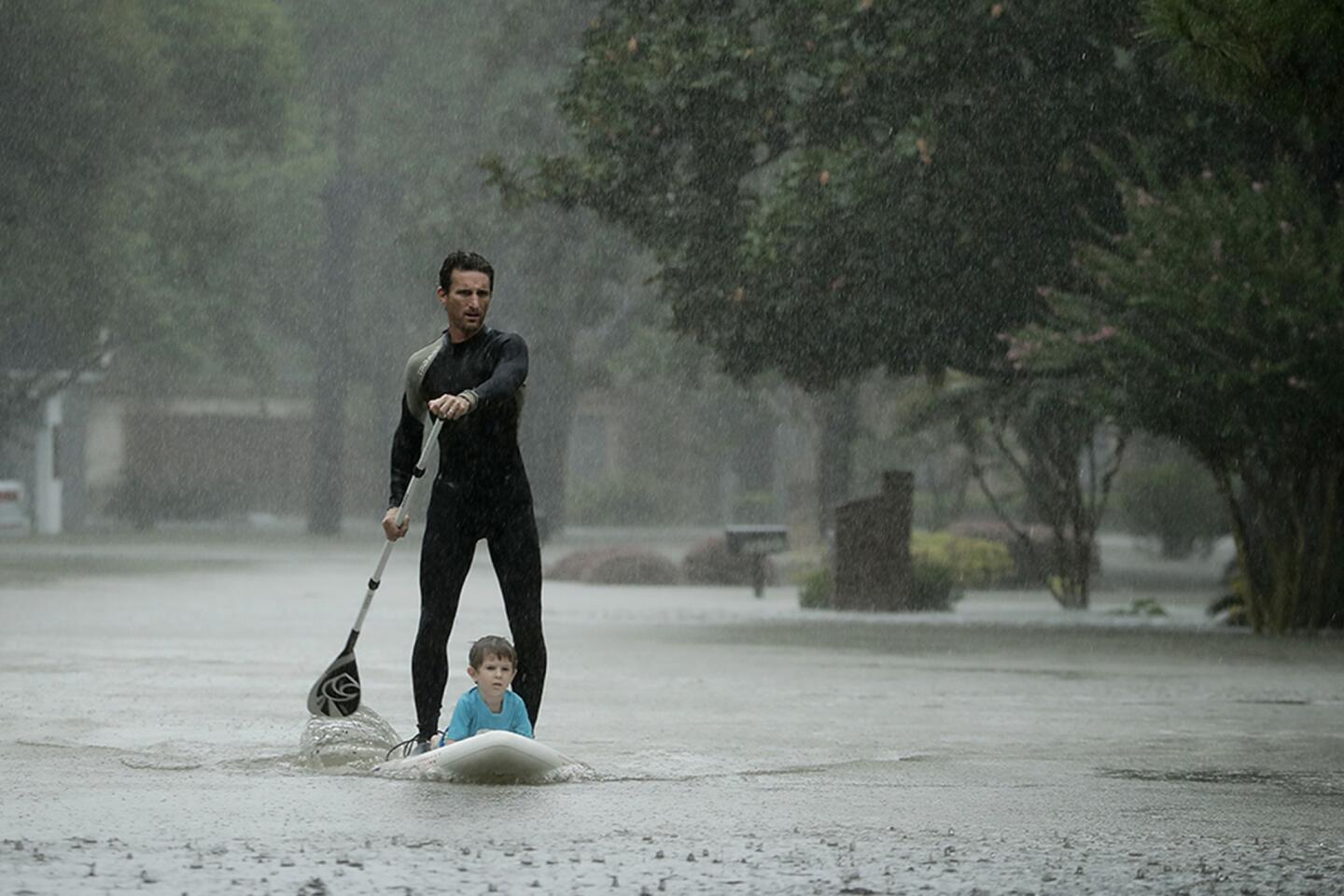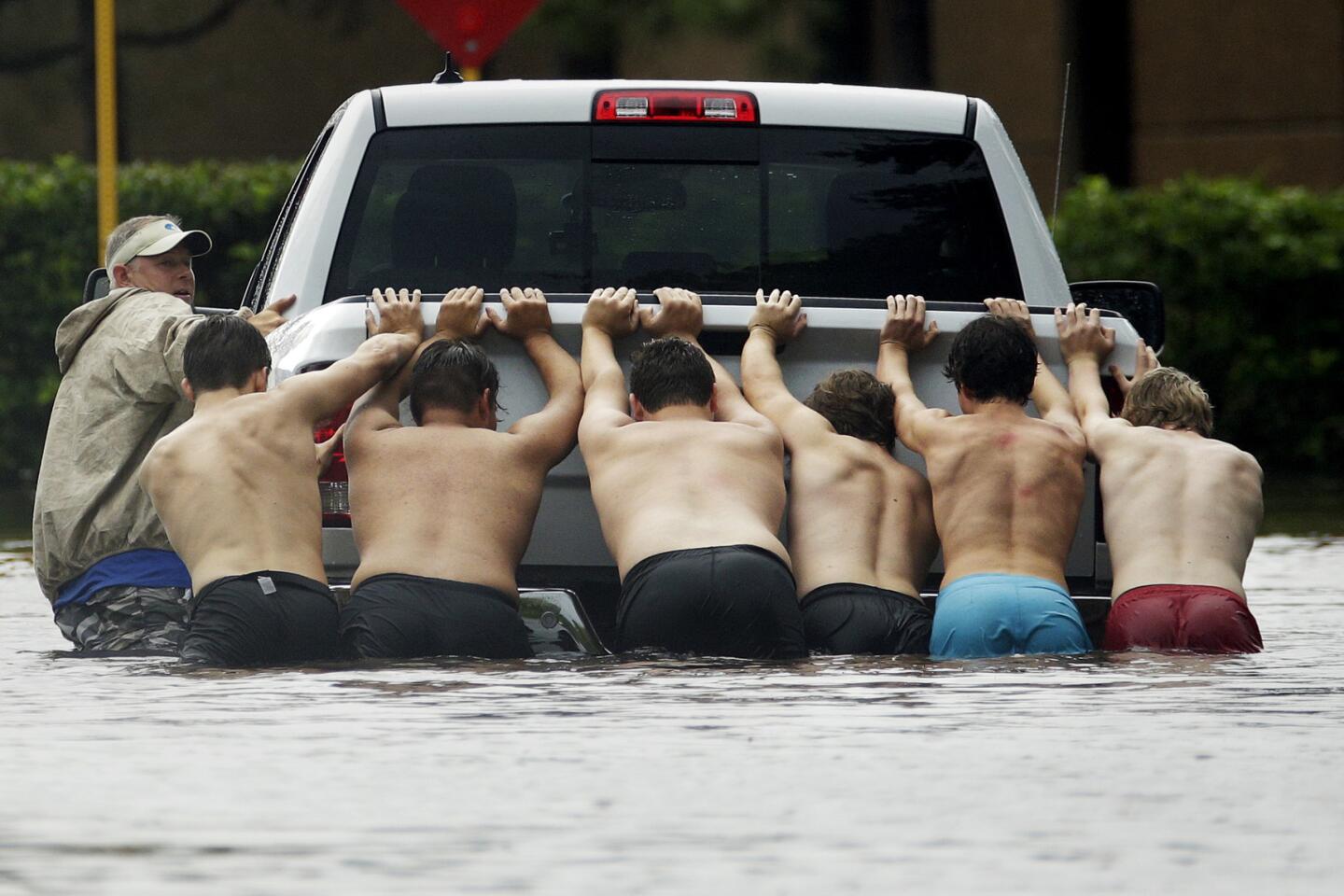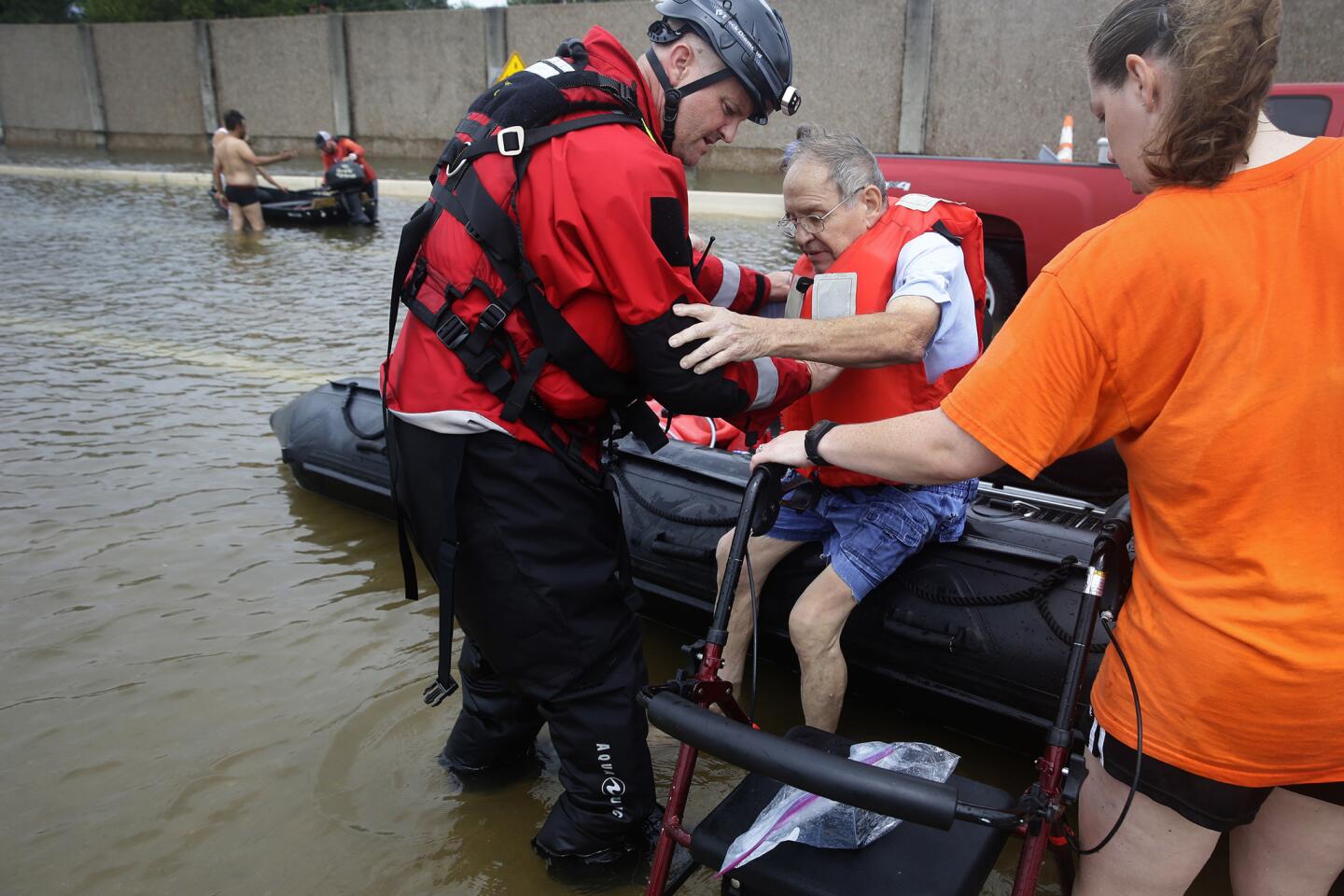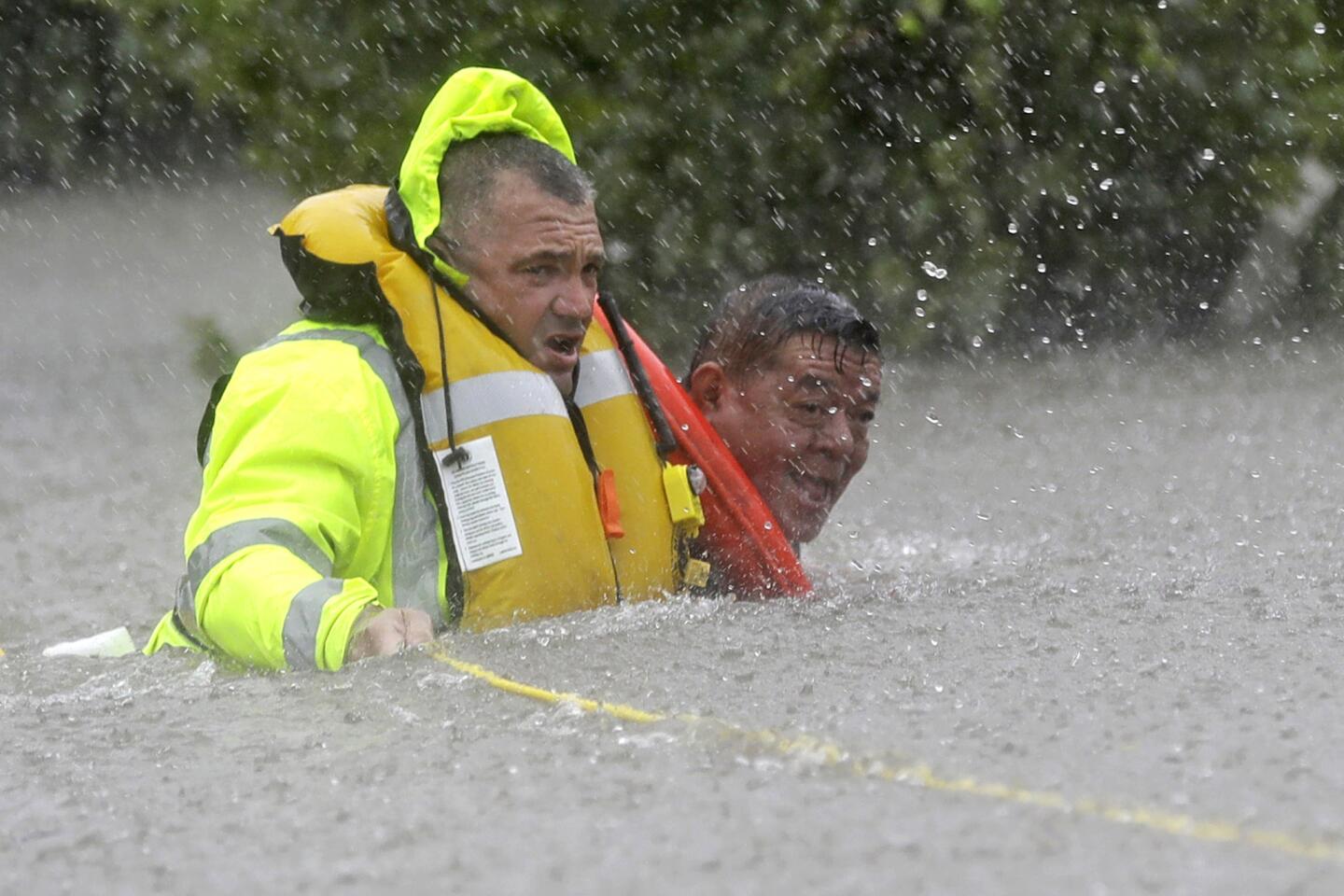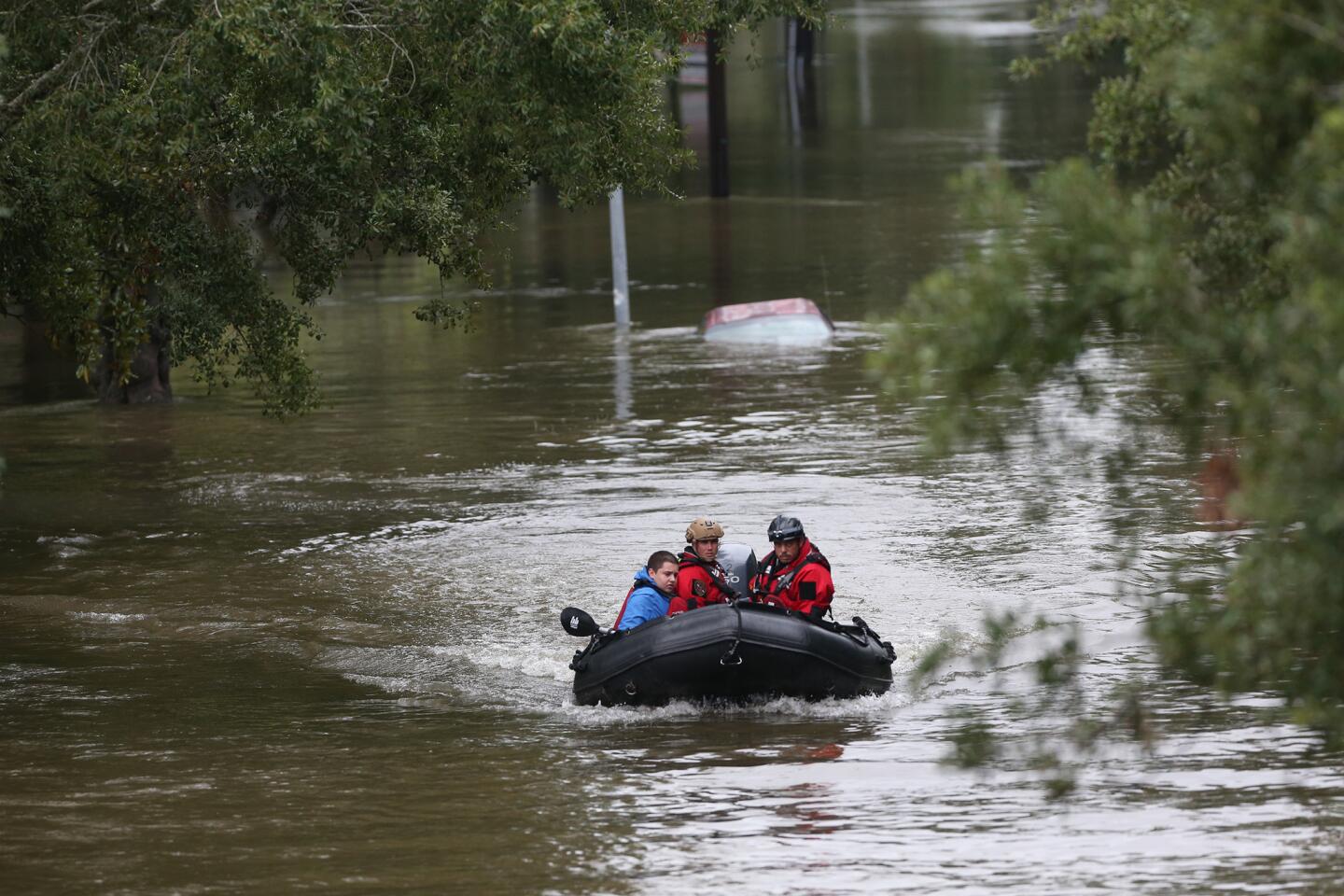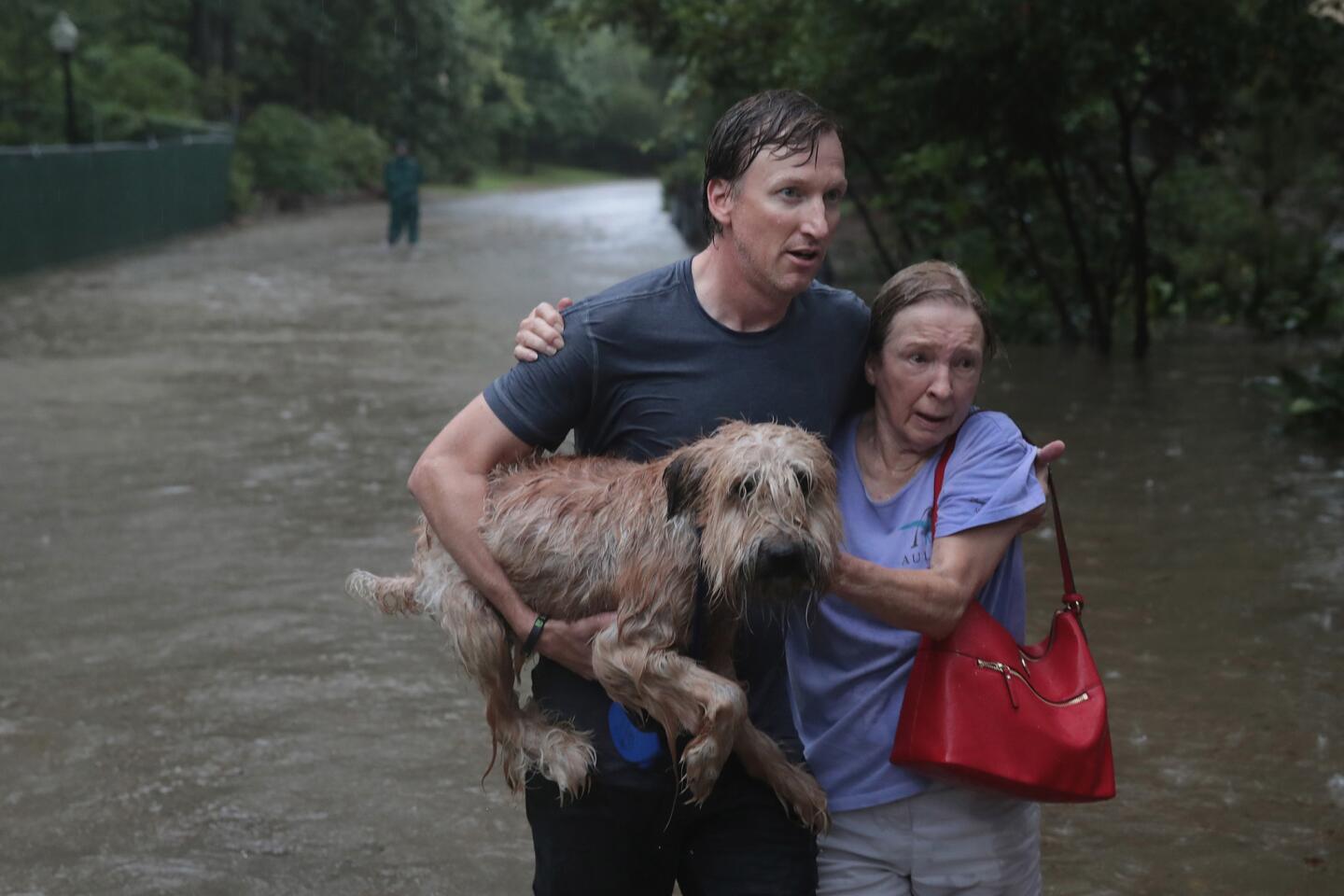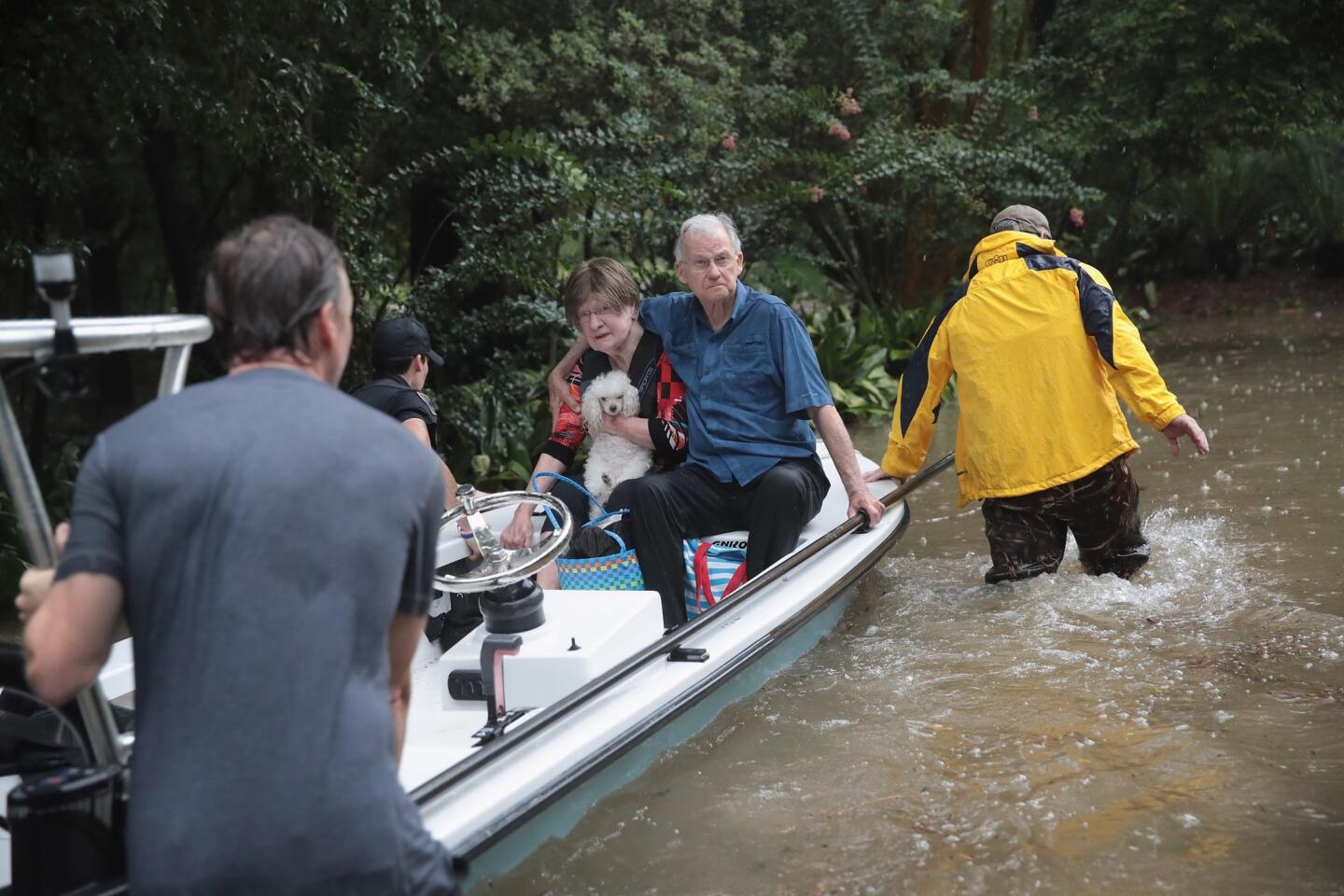Collapsed roofs and downed trees as Hurricane Harvey batters Texas coast
- Share via
Hurricane Harvey has become the first major hurricane in 12 years to hit the mainland United States, coming ashore Friday night in Texas with 130-mph winds and threatening millions of people along the Gulf Coast with catastrophic flooding and torrential rains.
As the storm’s center neared landfall close to Corpus Christi, President Trump announced on Twitter that he had granted Texas Gov. Greg Abbott’s request for a disaster declaration, “which unleashes the full force of government help!”
Abbott warned that the storm is a “very complex and dangerous” hurricane that could bring devastating flooding along the middle Texas coast as Harvey is expected to dump more than 2 feet of rain over parts of the region.
“It’s a hurricane that’s going to prove more dangerous than many hurricanes,” Abbott said. “We are going to be dealing with immense, really record-setting flooding in multiple regions across the state of Texas.”
The storm slammed onto shore Friday evening as a powerful Category 4 hurricane and powered its way north of Corpus Christi.
Downgraded to a Category 3 storm, Harvey made a second landfall shortly after midnight along the northeastern shore of Copano Bay, the
Initial reports suggested the staggering strength of the storm.
At least 10 people were treated for injuries at a local jail in Rockport, about 31 miles northeast of Corpus Christi, after the roof of a senior citizens complex collapsed, local media reported.
Part of a high school also collapsed, and a portion of the exterior of a hotel peeled off in the heavy winds, KXAN-TV of Austin reported.
“People are trapped inside at least one collapsed building. We can't get rescue teams to them right now,” Rockport City Manager Kevin Carruth told KIII News.
Emergency officials reported large numbers of downed trees and more than 86,000 people around the state without power.
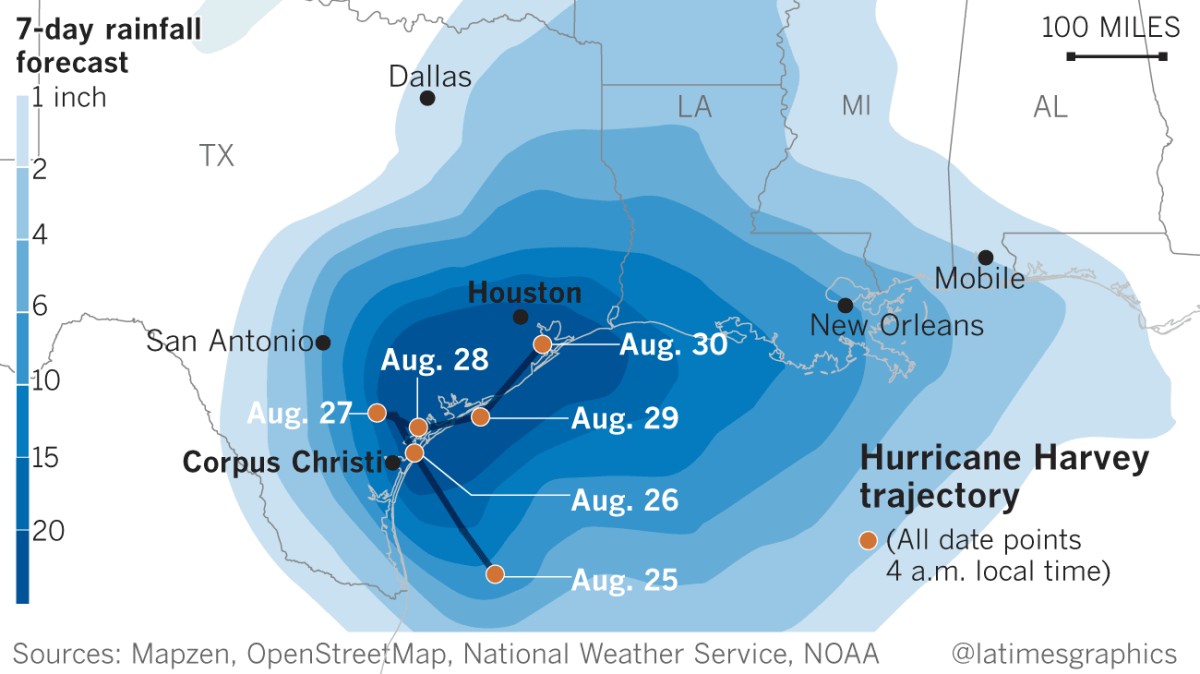
A hurricane warning is in effect along a wide stretch of the coastline from Port Mansfield to Sargent, spanning a region home to about 4 million people. An additional 12 million, many in the major cities of Houston and San Antonio, are under a tropical storm warning.
Heavy bands of rain began pounding the coast near Galveston on Friday afternoon as a stream of vehicles flowed out of the seaside resort city.
Few people were still out on the roads as the hurricane approached and the area fell under a tornado warning, with some drivers taking shelter in the lobbies of area hotels that have remained open.
The National Weather Service office in Corpus Christi cautioned that the extreme rainfall could be “devastating to catastrophic,” and that the current threat to life and property was “extreme.” Rivers and tributaries could overflow their banks and streets and parking lots become “rivers of raging water with underpasses submerged,” the weather service said.
A major hurricane poses the first major test of emergency response for the Trump administration and the Federal Emergency Management Agency’s new administrator, Brock Long, who was confirmed in June.
Trump plans to travel to Texas next week, Homeland Security Advisor Tom Bossert said. Speaking to reporters at a news briefing Friday, he added that federal officials had significantly improved their ability to respond to natural disasters since Hurricane Katrina caused widespread flooding in New Orleans in 2005, and the president seemed determined to provide help to Texas in the face of the storm.
Harvey intensified in the central Gulf of Mexico on Thursday morning, reaching Category 3 hurricane status by early afternoon Friday and Category 4 status by early Friday evening. Hours later, the storm was reaching landfall near Corpus Christi and moving northwest at about 10 mph.
As it moves inland, Harvey is likely to slow down and meander near the coastline, dropping up to 35 inches of rain across some parts of Texas through Wednesday.
Before Harvey, the last Category 4 hurricane to hit the United States was Charley, which struck Florida in 2004. The most recent major hurricane to make landfall was Wilma, a Category 3 storm that hit Florida the next year.
In 2016, thousands of residents along the Florida, Georgia and South Carolina coasts evacuated as Hurricane Matthew was forecast to make landfall as a Category 4 storm. However, the hurricane veered east and weakened to a Category 2 as it skirted along the coast.
Historically, slow-moving tropical storms and hurricanes have caused some of Texas’ most severe flooding. In 2001, Tropical Storm Allison hovered above the Houston area for days, dumping up to 30 inches of rain — as much as 80% of the area’s average annual rainfall over some neighborhoods.
The last hurricane to hit the Texas coast — Hurricane Ike, a Category 2 storm that wreaked havoc after making landfall in Galveston in 2008 — killed at least 37 people and resulted in more than $30 billion in damage.
Abbott had urged residents of low-lying and coastal areas — even residents of Houston, where Mayor Sylvester Turner has not called for evacuations — to evacuate before Harvey made landfall.
“What you don’t know and what nobody else knows right now is the magnitude of flooding that will be coming,” the governor said.
At the Hertz car rental outside Houston's George Bush Intercontinental Airport, arriving customers snapped up trucks and SUVs in preparation for the days of catastrophic rains projected to come.
After learning she was speaking to a journalist, one of the rental workers paused and asked, in a grim voice, "Do you think they're telling the truth about how bad it'll get?" Several other employees also stopped and craned their necks to listen.
Local officials and news outlets have had to bat down a viral social media message that circulated widely among Texans on Thursday warning that the storm would be far worse than officials were already predicting.
"Ignore unfounded, unsourced weather predictions that have needlessly frightened Houstonians," Mayor Turner tweeted. "Get info from trusted outlets."
Not everybody was running from the storm.
One married couple, Tom Miller, 48, an IT analyst, and Ron Marcus, 55, a food service manager, both of Bartlesville, Okla., had been watching the forecast for days and noted the hurricane coming toward Texas.
They decided to beat it to Galveston — where they had been planning to catch a cruise where Miller's niece was expecting to get married. Veterans of Tornado Alley, they figured they could wait out a hurricane, with its weaker-than-a-tornado winds.
"We headed out last night and drove straight through [the night] to get here," arriving around 4 a.m. Friday morning, said Miller.
"Of course, after getting here," Miller added sheepishly, "it's kind of growing in intensity."
Along the southern edge of Galveston, foaming waves marched furiously toward the shore, where a TV cameraman and an anchor stood in the sand to record the oncoming wrath of the storm.
They weren't alone. Three friends — James Hibberts, 19, of Clear Lake, Branden Castillo, 26, of Webster, and William Mead, 21, of Clear Lake — moseyed around nearby in the sand, barefoot, hoping to get on TV.
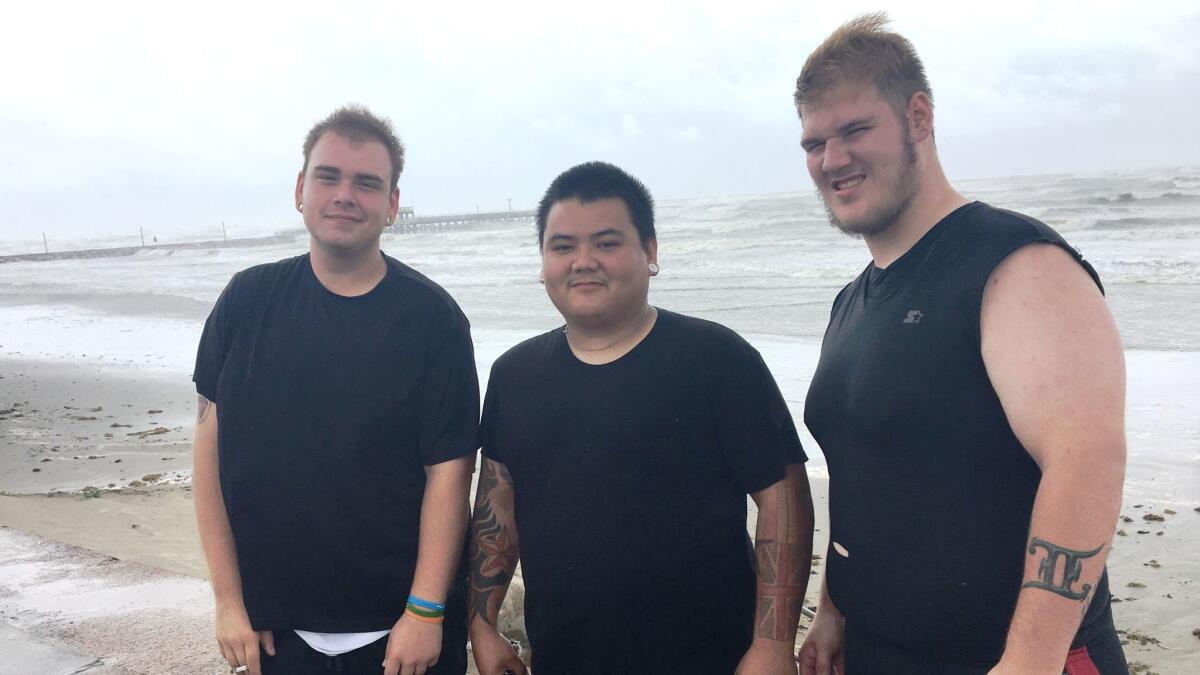
Like other sightseers that had not fled the area, they weren't intimidated by the storm.
"Danger is not a factor in these parts," Mead said, smiling, as the men's shirts whipped around in a fierce wind.
The men were hoping to skimboard on one of the main roads running along Galveston's gulf shoreline, but it hadn't flooded yet.
Even they were amazed when they saw two surfers paddle out and try to ride the waves, which raged unpredictably toward the beach.
Regretfully, Mead said he couldn’t hang out all weekend. He has a job at Wal-Mart. "I gotta work tomorrow," he said.
In Corpus Christi, despite evacuation orders and warnings that the storm would make landfall near their coastal town, Eddie Canales and his neighbors decided to stay.
Canales, 69, said the dire warnings ahead of Harvey’s arrival reminded him of Hurricane Celia, the last major storm he weathered at his grandparents’ home there in 1970. That storm tore a path of destruction through the seaside refinery community, a tourist mecca and working-class haven. Canales recalled how “ferocious” winds of 160 mph damaged 90% of downtown and destroyed about a third of homes.
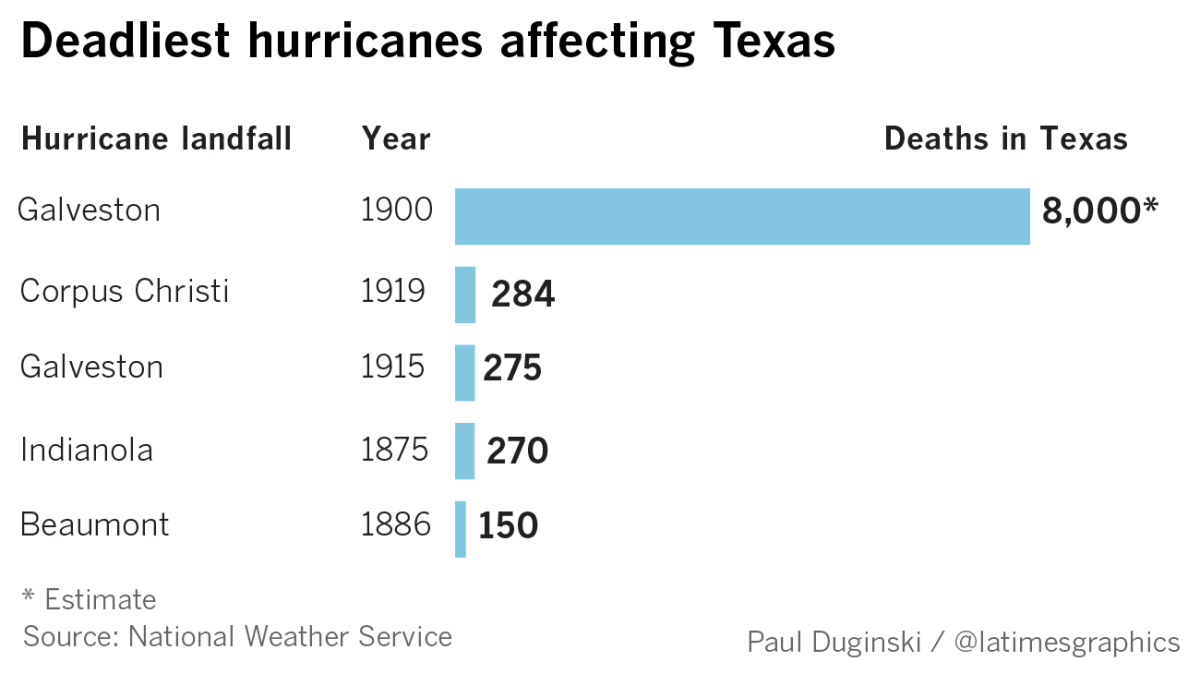
His grandparents’ house was spared. But when they emerged to check on his uncle nearby, they found him sheltering with neighbors, his roof torn off by storm winds.
“The house next door was fine. That’s what Celia created: little twisters and squalls across the city,” said Canales, director of the South Texas Human Rights Center. “Refinery tanks were bent like beer cans. Every single drive-in theater was flattened and gone. We didn’t have electricity at my mom’s house for 11 days, and there was a curfew. The whole city came together with barbecuing, and there were scalpers around selling ice.”
This time, he has a truck parked on high ground and neighbors with a gas generator and pontoon boat. He stocked up on water and other essentials, boarded up his ranch house’s windows and retreated inside Friday as the rain picked up.
“The wind is starting to gust up. I just checked all the windows to make sure they’re completely shut. I’ve got neighbors on both sides that are still here. We’re going to weather the storm,” he said. “It’s kind of dicey, but I can always go up to the attic if it gets to flooding” and escape to higher ground.
Local emergency managers divided the city into zones: the two closest to the port were considered most at risk for storm surge flooding, but Canales lives two zones farther inland, so he feels safer.
His concern late Friday was Oso Creek about a block away, which was already swollen from recent rain. He planned to take a nap Friday afternoon, then stay up watching the latest season of “House of Cards” and the live drama outside, monitoring as the storm makes landfall around midnight.
A friend in Houston phoned to check on him.
“I’m hunkered down in Corpus — wish me well!” Canales said.
She asked if he knew where she could get gas for her car — shortages had been reported in Houston.
“You’re not going to find it,” he said, laughing. “Just go back home. Don’t worry about it. Hunker down.”
After preemptively declaring a state of disaster for 30 Texas counties, Gov. Abbott on Thursday activated about 700 members of the state National Guard.
Mandatory evacuation orders were already in effect across seven coastal counties. Mayor Joe McComb of Corpus Christi, Texas’ eighth largest city with a population of about 325,000, had encouraged residents to leave voluntarily.
With Houston forecast to see up to 20 inches of rainfall, local officials there were readying evacuation boats and high-water rescue vehicles.
On Thursday, Houston’s Office of Emergency Management urged residents to stockpile enough water, food and medication for five to seven days, secure anything that could be picked up by strong winds, and park vehicles off the streets. The Houston Independent School District, the largest public school system in Texas, canceled all classes Monday on what would have been the first day of school.
Gas prices spiked as oil and gas operators shut down about 21% of oil production and 23% of natural gas production in the Gulf of Mexico, according to the federal Bureau of Safety and Environmental Enforcement. Workers have been evacuated from four of the 10 rigs operating in the gulf, as well as from 86 production platforms, about 11% of the gulf’s staffed platforms.
In neighboring Louisiana, Gov. John Bel Edwards declared a state of emergency Thursday for the entire state.
“All arms of the state’s emergency preparedness and response apparatus are planning for the serious threat posed by Hurricane Harvey, and we are calling on all Louisianans throughout the state to do so as well,” Edwards said.
Just a few inches of rain could cause severe challenges in New Orleans, which is still recovering from flooding after thunderstorms earlier this month overwhelmed the city's drainage system. On Thursday, Mayor Mitch Landrieu urged residents to prepare for 5 to 10 inches of rain.
With 105 out of 120 pumps operating in the city, Landrieu said, officials are "working around the clock" to repair drainage pumps and turbines.
"There is no need to panic, but there is need to be well-prepared," Landrieu said.
Bossert said federal emergency officials had been in close contact with state managers in Texas and Louisiana and were assured that both states had made aggressive preparations.
“Now is not the time to lose faith in your government institutions,” Bossert told reporters.
“They all seemed to be well postured, and they didn’t report to us any additional needs. In fact, they all reported to us that they’re in the right operational posture to help the American people in the path of this storm.”
At the same time, he said federal officials were urging residents of both affected states to take responsibility for themselves.
“You never want to plan for the federal government to swoop in and provide everything that you need, when you need it, just on time, right? It’s going to be 4.6 million people, I guess, in the path of this storm, depending on how the forecast goes,” Bossert said. “That’s a lot of people. We encourage people to be ready, be prepared, take some responsibility for their own safety as the next 72 hours unfold.”
Special correspondent Jarvie reported from Atlanta and staff writer Pearce reported from Houston. Staff writer Lisa Mascaro in Washington also contributed to this report.
ALSO
Heat wave expected to bring triple-digit temperatures to the Southland
In racially charged case, Florida carries out its first execution since early 2016
UPDATES:
11:15 p.m.: This article was updated with initial damage reports, the downgrading of the storm and a second landfall.
7:10 p.m.: This article was updated with news that the hurricane had reached the Texas coast and President Trump issued a federal disaster declaration.
4:20 p.m.: This article was updated with the upgrading of the storm to the Category 4 level.
2:55 p.m.: This article was updated with an interview with a resident of Corpus Christi.
2:35 p.m.: This article was updated with an interview with those gathered at the beach in Galveston.
2:20 p.m.: This article was updated with additional comments from White House officials and information about oil operations in the Gulf of Mexico.
12:15 p.m.: This article was updated with comments from White House homeland security advisor Tom Bossert.
12:00 p.m.: This article was updated with a report from Galveston and information from the governor’s news conference.
11:05 a.m.: This article was updated with the latest movements of the storm.
9:20 p.m.: This article was updated with interviews in Houston and an appeal from the city’s mayor.
8:15 a.m.: This article was updated to report on preparations for Hurricane Harvey in Louisiana.
This article was originally published at 8 a.m.
Sign up for Essential California
The most important California stories and recommendations in your inbox every morning.
You may occasionally receive promotional content from the Los Angeles Times.

